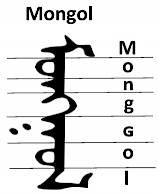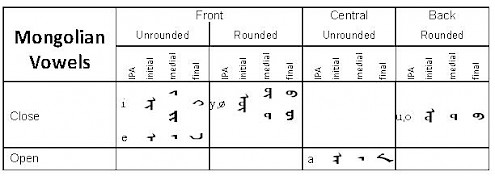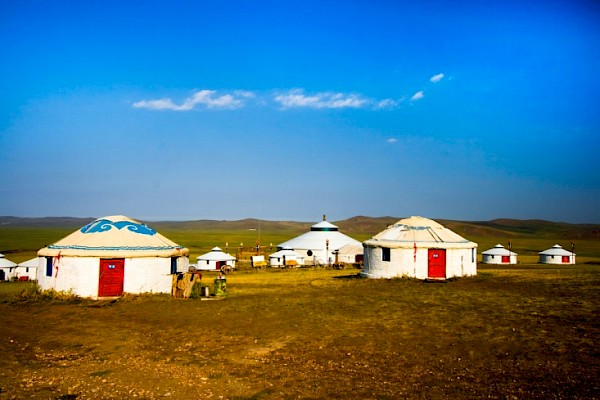Summary
The History of Bible Translation in China can be divided into four periods:
- The Era of Sporadic Bible Translations: 635–1800
- The Struggle for the Authoritative Chinese Bible: 1800–1920
- The Rise of the Authoritative Chinese Bible: 1920–1980
- The Marginalization of the non-Chinese Bibles: 1980–present
The Era of Sporadic Bible Translations (635–1800) is characterized by irregular missions from the Middle East and Europe to China, often in combination with trade activities. The missionaries were a subgroup of a larger set of people who had established contact with the Chinese for various reasons. The first missionaries who migrated to China were Nestorian Christians in A.D. 635. They moved to China via the ancient Silk Road together with other Middle East traders. The Muslim Huí 回 people, whose population is distributed unevenly throughout Modern China, are descendants of these traders. The Nestorian missionaries translated several books of the Old and New Testament into Middle ChineseLinguists divide the history of Chinese into five periods:
Old-Chinese 上古文 B.C. 1000-0
Middle-Chinese 中古文 A.D. 0-900
Old-Mandarin 近代汉语 1000-1200
Middle-Mandarin 近代汉语 1368-1644
New-Mandarin 现代汉语 1800-today. No manuscript survived to the present day, but the Nestorian stela of Xī'ān referred to the translation of Bible portions. These portions were probably secondary translations based on the ancient Syriac Bible, the Peshitta. During the Mongol empire in the medieval period, Pope Nicholas IV appointed John of Montecorvino as his special envoy to the Mongol court. Venetian trader Marco Polo traveled to China at approximately the same time as John, although he was more motivated by commercial gains than religious interests. In 1307, John of Montecorvino translated the Psalms and the New Testament into Old Uyghur, the language used by the Mongol elite. No manuscript was preserved, but John mentioned his achievements in two letters to the Pope. The third language into which portions of the Bible were translated was the Formosan Siraya language. During the Dutch occupation of Taiwan in 1661, reformed preacher Daniel Gravius translated the Gospel of Matthew into Siraya. As a member of the Dutch Reformed Church clergy, he was employed by the Dutch East India Company, which was a chartered trading company. Dutch missionary activities had impacted the indigenous people until the early eighteenth century. None of three aforementioned Bible translations had any lasting effect nor were circulated widespread as there was no strategic plan to push these efforts. They were drops in the bucket (Isaiah 40:15), yet they were imperceptible beginnings that laid claim to Christianity’s ancient roots in China.
The nineteenth century saw the Struggle for the Authoritative Chinese Bible (1800-1920). This struggle depended on another conflict: the choice of the lingua franca (common language) that could unify the Chinese empire. The Manchu government used the speech of BěijīngIt was called Guānhuà 官话 or language of the Mandarins. as the language in which daily business was conducted. However, only a limited number of people in the populous south could speak this language fluently. Classical Chinese enjoyed prestige in the nineteenth century, but like Latin, nobody spoke it as a native language. Over 50 years, the Protestant missionaries had translated five versions of the Classical Chinese Bible. None of these endeavors, however, appealed to Chinese Christians, for which we might present two reasons. First, the Bibles were translated in a dead, albeit prestigious, language. Second, there was no consistent language policy behind Classical Chinese to promote it as a vehicular language for ordinary people. In the later nineteenth century, it became increasingly clear that the speech of Běijīng might assume the role as the lingua franca. Frustrated by the lack of an authoritative Bible, in 1890, the Protestant missionaries established three interdenominational translation committees: one for the high register of Classical Chinese, one for its low register, and one for Mandarin, the speech of Běijīng. Only the Mandarin committee survived the long translation process of 30 years; the classical committees were dissolved in the meantime. These decisions were influenced by political developments. At a national conference in 1913, the young Republic of China decided to adopt the speech of Běijīng as its national language. When the Mandarin committee completed their work and published the Chinese Union Bible in 1919, the timing could not have been better. Between the nineteenth and early twentieth centuries, Protestant missionaries also translated portions of the Bible into approximately 26 Chinese dialects. These Bibles were circulated locally, and they accommodated the needs of the nascent church communities until the authoritative Chinese Bible arrived. Moreover, Bible translations into three important minority languages were commenced or achieved in the nineteenth century: Manchu (1822), Tibetan (1862), and Modern Uyghur (1898). Fascinating stories are attached to each of these projects.
The Rise of the Authoritative Chinese Bible (1920-1980) correlates to the rise of Mandarin Chinese as the national language. During the Republican period (1911–1949), preparations for the promotion of Mandarin Chinese were made; however, real changes were only implemented during the Communist era after 1949. According to Chinese scholar Zhōu Mínglăn 周明朗See Zhōu (2003, 2013)., the Chinese language policy followed two models of nation-state building: the Soviet model (1950–1980) and the Chinese model (1980–present). In the 1950s, the Chinese government imposed a multilingual language order in which Mandarin Chinese became the lingua franca of Chinese dialect areas, which was supplemented by the local dialects where necessary. A minority language became the lingua franca of an ethnic autonomous area, and Mandarin Chinese was spoken as a complementary language. During this phase of nation-state building, Mandarin Chinese marginalized all other Chinese dialects. The last Chinese dialect in which a Bible portion was translated was the Teochew 潮汕 dialect (Southern Mǐn) in 1922. This marked the beginning of a gradual process in which all dialect translations fell into disuse while the Chinese Union Version rose to prominence. Exceptions are the Hokkien and Hakka dialects, which are spoken by a sizable diaspora abroad, and for which the Bible Society of Taiwan published revised Bible translations in 2008 and 2012.
The Marginalization of the non-Chinese Bibles (1980-today): The Cultural Revolution (1966–1976) destroyed the multilingual language order, but a reversion to the old order seemed impossible. The government amended Article 19 of the Constitution in 1982 and made Mandarin Chinese the lingua franca (Pŭtōnhuà) of all nationalities. This led to the Chinese model of nation-state building with a monolingual language order in place. The transition was accentuated by the collapse of the Soviet Union in 1991 and the introduction of economic reforms. Labor and household registration rules were reformed; people were no longer required to work in the location where they were born. This led to a strong increase of internal migration from poor rural areas to richer coastal areas. In particular, young people left the countryside, whereas elderly people stayed behind. Some observers estimatedSee Zhōu Mínglăn (2013, p. 25). that the number of migrants increased to 100 million in the 1990s and to 200 million in the 2000s. that the number of migrants increased to 100 million in the 1990s and to 200 million in the 2000s. The fusion of new populations boosted demand for Mandarin Chinese as the lingua franca at the expense of the Chinese dialects and minority languages. Furthermore, economic development created the need for a common language for communication, thus alienating minority people from their mother tongue, which is now perceived as a negative instead of a positive. As a result, minority languages began disintegrating at an alarming pace. This trend was exacerbated during 2010–2016 due to the emergence of mobile communication (the surface language of mobile devices is Mandarin Chinese) and the boom of construction projects (part of the land population was relocated into tower buildings in Hàn areas where the dominant language is Mandarin Chinese). Foreign missions came to China in the 1990s to translate the Bible in minority languages. Some of these projects have borne fruit in the past 10 years and added about five new languages to the set of languages with Scriptures. Yet, under prevailing obstructive conditions, the momentum for new translation projects is irrevocably lost; therefore, efforts to reach out to minority people will increasingly involve the Chinese Union Bible. There are a few exceptions though. The Flowery Miao (Ahmao)Spoken in Guìzhōu Province., Flowerly LisuSpoken in Yúnnán Province., NasupuSpoken in Yúnnán Province. and NuosuSpoken in Sìchuān Province. languages show rigorous use of the Bible by Christians. The assimilation of these languages to Mandarin Chinese is expected to be slower than other languages. In Taiwan, Mandarin Chinese has risen to a dominant position in public life as well. The Formosan languages are endangered to various degrees. Bible portions were translated in 10 minority languages over the past 60 years; the translation projects proceeded without repression. However, Taiwan’s economic development has undermined the use of minority Bibles in a similar way.
Over the past 1,400 years, missionaries have translated Bible portions in 70 languages. The following table categorizes these languages along their genetic affiliation.
|
Group/Family |
Translated Languages |
|---|---|
|
Sinitic |
29 |
|
Altaic |
5 |
|
Miao-Yao |
4 |
|
Tai-Kadai |
6 |
|
Tibeto-Burman |
14 |
|
Austro-Asiatic |
2 |
|
Formosan |
10 |
Table 1: Language groups with Scriptures in China
More than 38 Christian organizations based in 14 countries and affiliated with 11 denominations participated in Bible translation projects. Organizations from the United States of America and Great Britain have contributed most to Bible translation in China. The following table classifies the contribution toward Bible translation in China according to the Christian organizations, their denominations, and their country of origin.
|
Denomination |
Organization |
Country of Origin |
Translated Languages |
|---|---|---|---|
|
Orthodox |
Syrian Orthodox Church |
Syria, Iraq |
1 |
|
|
Russian Orthodox Church |
Russia |
2 |
|
Catholic |
Roman Catholic Church |
Italy |
3 |
|
Three-Self |
China Christian Council/Three-Self Patriotic Movement |
China |
6 |
|
Anglican |
American Episcopal Mission |
USA |
3 |
|
|
Church Missionary Society |
UK |
6 |
|
|
Church of England Zenana Missionary Society |
UK |
1 |
|
Reformed |
Dutch Reformed Church/Mission |
Netherlands |
2 |
|
|
Swedish Missionary Society |
Sweden |
1 |
|
Congregational |
American Board of Commissioners for Foreign Missions |
USA |
4 |
|
Presbyterian |
English Presbyterian Mission |
UK |
4 |
|
|
American Presbyterian Mission |
USA |
10 |
|
|
Canadian Presbyterian Mission |
Canada |
2 |
|
|
Presbyterian Church of Taiwan |
Taiwan |
2 |
|
Baptist |
Baptist Serampore Mission |
UK, India |
1 |
|
|
Conservative Baptist Foreign Mission Society |
USA |
1 |
|
|
American Southern Baptist Mission |
USA |
2 |
|
|
American Baptist Missionary Union |
USA |
3 |
|
Methodist |
American Methodist Episcopal Mission |
USA |
2 |
|
|
American Southern Methodist Episcopal Mission |
USA |
1 |
|
|
United Methodist Mission |
UK |
2 |
|
|
United Methodist Free Church |
UK |
1 |
|
|
English Wesleyan Mission |
UK |
1 |
|
|
Bible Christian Mission |
UK |
1 |
|
Pentecostal |
Dutch Pentecostal Missionary Society |
Netherlands |
1 |
|
Interdenominational |
Anonymous Individuals |
--- |
3 |
|
Asian Christian Service |
USA |
1 |
|
|
|
London Missionary Society |
UK |
6 |
|
|
China Inland Mission (until 1964) |
UK |
11 |
|
|
Overseas Missionary Fellowship (after 1964) |
UK |
1 |
|
|
Basel Missionary Society (until 2001) |
Switzerland |
1 |
|
|
Institute for Bible Translation |
Russia |
1 |
|
|
Research Foundation Language and Religion |
Germany |
4 |
|
|
Vandsburger Mission/Marburger Mission |
Germany |
1 |
|
|
Moravian Church Mission |
Germany |
1 |
|
|
Zentralasien-Gesellschaft |
Germany |
1 |
|
|
Summer Institute of Linguistics/Wycliffe Bible Translation |
USA |
5 |
|
|
Bible Society of Taiwan |
Taiwan |
7 |
|
|
United Bible Societies |
--- |
8 |
Table 2: Bible Translation by Christian Missions in China
Chinese dialects (28)
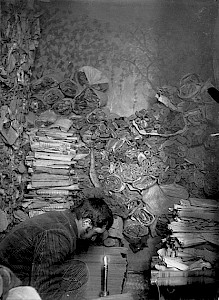 Orientalist Paul PelliotFrench Orientalist Paul Pelliot 伯希和 (1878-1945) discovered many of the Dúnhuāng manuscripts.Parts of the Bible were first translated by NestorianNestorius (386–450), Patriarch of Constantinople, emphasized the disunion of the human and divine natures of Christ. His teachings were condemned as heretical by the Council of Ephesus (431). As he was separated from the Western Churches, he associated himself with churches in Syria, Iraq, and Persia to form the Church of the East. Some historians have warned, though, that the churches of Syria, Iraq, and Persia had not unequivocally embraced Nestorius’s monophysitism and that the Church of the East should not be identified with the doctrine of Nestorius (see Hofrichter 2006). Christians after A.D. 635 when the Syrian missionary AlobenAloben (Chinese: Āluóběn 阿罗本) is known exclusively from the Nestorian Stela in Xī’ān. He was probably a Syriac speaker from Persia. His name might be a transliteration of the Semitic “Abraham.” came to Cháng’ān (today’s Xī’ān). A stela was found in Xī’ān in 1625 commemorating Christian activities in China during the Tang dynasty (A.D. 618-907). The stela was erected in A.D. 781, after the Nestorian missionaries had evangelized the local population for some time. In A.D. 720, China became an ecclesiastic province of the Church of the East, under the name of Beth SinayeSee Wilhelm Baum and Dietmar W. Winkler (2003). The Church of the East: A Concise History. London: RoutledgeCurzon.. The Church of the East in China disappeared after the fall of the Tang dynasty in A.D. 907. The text on the stela mentions “Scriptures were translated,” which unequivocally refers to the translation of some portion of the Bible. However, no Bible translation has been preserved.
Orientalist Paul PelliotFrench Orientalist Paul Pelliot 伯希和 (1878-1945) discovered many of the Dúnhuāng manuscripts.Parts of the Bible were first translated by NestorianNestorius (386–450), Patriarch of Constantinople, emphasized the disunion of the human and divine natures of Christ. His teachings were condemned as heretical by the Council of Ephesus (431). As he was separated from the Western Churches, he associated himself with churches in Syria, Iraq, and Persia to form the Church of the East. Some historians have warned, though, that the churches of Syria, Iraq, and Persia had not unequivocally embraced Nestorius’s monophysitism and that the Church of the East should not be identified with the doctrine of Nestorius (see Hofrichter 2006). Christians after A.D. 635 when the Syrian missionary AlobenAloben (Chinese: Āluóběn 阿罗本) is known exclusively from the Nestorian Stela in Xī’ān. He was probably a Syriac speaker from Persia. His name might be a transliteration of the Semitic “Abraham.” came to Cháng’ān (today’s Xī’ān). A stela was found in Xī’ān in 1625 commemorating Christian activities in China during the Tang dynasty (A.D. 618-907). The stela was erected in A.D. 781, after the Nestorian missionaries had evangelized the local population for some time. In A.D. 720, China became an ecclesiastic province of the Church of the East, under the name of Beth SinayeSee Wilhelm Baum and Dietmar W. Winkler (2003). The Church of the East: A Concise History. London: RoutledgeCurzon.. The Church of the East in China disappeared after the fall of the Tang dynasty in A.D. 907. The text on the stela mentions “Scriptures were translated,” which unequivocally refers to the translation of some portion of the Bible. However, no Bible translation has been preserved.
In 1907, Nestorian documents were found in the Mògāo Caves 莫高窟The Mògāo Caves 莫高窟 are located 25 km southeast of Dúnhuāng 敦煌 and contain examples of Buddhist fine art spanning a period of 1,000 years as well as a large number of documents in various languages such as Chinese, Tibetan, Uyghur, Sanskrit, and Sogdian. In 1907, Nestorian Christian works were found in the Caves. The International Dúnhuāng Project was established by the British Library in 1994, and it is a cooperative effort of 24 institutions from 12 countries to conserve, catalogue, and digitize the manuscripts found there. in Dúnhuāng敦煌Dúnhuāng 敦煌 is a county-level city in Northwestern Gānsù Province. It was a major stop on the ancient Silk Road connecting straight to the Chinese plains leading to Cháng'ān (Xī’ān). which mentioned Chinese translationsSee Saeki, Yoshio (1937). The Nestorian Documents and Relics in China. Tokyo: Academy of Oriental Culture. of the Pentateuch (referred to as “牟世法王经”), including the Book of Genesis (“浑元经”), the Psalms (“多惠圣王经”), the Gospels (“阿思翟利容经”), Acts of Apostles (“传代经”), and a few others. The language in which these portions were translated was Middle Chinese.
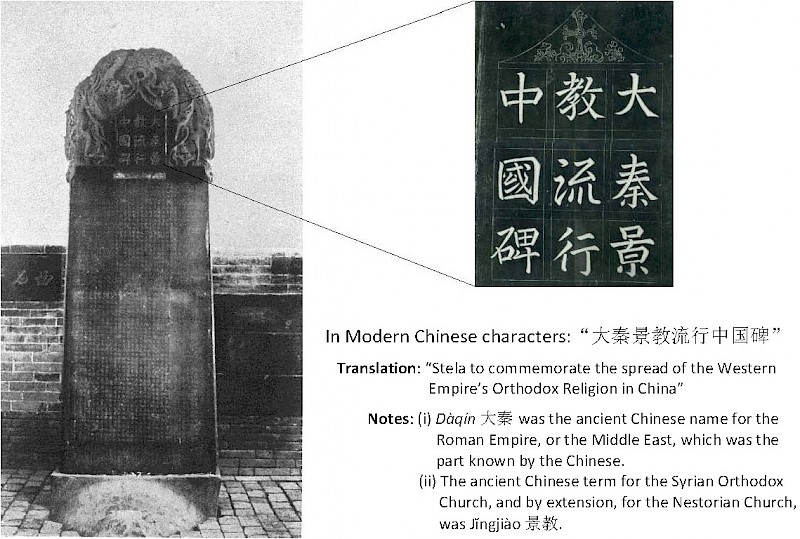
 Jesuit Shĕn FúzōngJesuit Shĕn Fúzōng 沈福宗 (?–1691), whose Latinized name was Michael Alphonsius, was a Qīng dynasty official from Nánjīng 南京. He converted to the Catholic faith and became one of a few Chinese who had traveled to Europe in the seventeenth century. Shĕn met with French King Louis XIV in 1684 and English King James II in 1685, and continued on to Lisbon, Portugal, where he entered the Society of Jesus. On his return to China, he died in Mozambique in 1691. This picture was painted by the German-English portrait painter Gottfried Kniller in 1685.During the Míng dynasty 明朝 (1378-1644), long after the disappearance of the Nestorian faith in China, Catholic missionaries came to China. Francis Xavier (1506-1552), a Basque Catholic, who was the companion of Ignatius of LoyolaThe Spanish nobleman and theologian, Ignatius of Loyola (1491–1556), was a leader of the Counter-Reformation and co-founder of the Society of Jesus, with Francis Xavier. and co-founder of the Society of Jesus, traveled as a pioneer to India, Japan, Borneo, and Maluku Islands to evangelize native populations. He died on the island of Shàngchuān 上川岛 in the South China Sea before reaching the Chinese Mainland.
Jesuit Shĕn FúzōngJesuit Shĕn Fúzōng 沈福宗 (?–1691), whose Latinized name was Michael Alphonsius, was a Qīng dynasty official from Nánjīng 南京. He converted to the Catholic faith and became one of a few Chinese who had traveled to Europe in the seventeenth century. Shĕn met with French King Louis XIV in 1684 and English King James II in 1685, and continued on to Lisbon, Portugal, where he entered the Society of Jesus. On his return to China, he died in Mozambique in 1691. This picture was painted by the German-English portrait painter Gottfried Kniller in 1685.During the Míng dynasty 明朝 (1378-1644), long after the disappearance of the Nestorian faith in China, Catholic missionaries came to China. Francis Xavier (1506-1552), a Basque Catholic, who was the companion of Ignatius of LoyolaThe Spanish nobleman and theologian, Ignatius of Loyola (1491–1556), was a leader of the Counter-Reformation and co-founder of the Society of Jesus, with Francis Xavier. and co-founder of the Society of Jesus, traveled as a pioneer to India, Japan, Borneo, and Maluku Islands to evangelize native populations. He died on the island of Shàngchuān 上川岛 in the South China Sea before reaching the Chinese Mainland.
The Italian Jesuit Matteo Ricci 利玛窦 (1552–1610) led a group of Jesuits to China and introduced Western science, particularly mathematics and astronomy, to the imperial court. He initiatedDavid Mungello (2005) counted 920 European Jesuits who had participated in the China mission between 1552 (the year when Francis Xavier died) and 1800. According to Kenneth Latourette (1929), there were likely 240,000 Roman Catholics in China in 1844 and 720,490 in 1901. an inter-cultural dialogue with Chinese Confucian philosophers. Many Chinese intellectuals converted and became priests of the Society of Jesus. Matteo Ricci translated portions of the Bible into Chinese, mainly liturgical selections but not entire books. The only preserved translation is the Ten Commandments.
The Chinese Rites Controversy was a dispute in the seventeenth century among Catholic missionaries over the religious nature of Chinese customsChinese folk religion is diverse in origins, founders, local rites, and philosophical traditions. The most common rites practiced are Chinese shamanism 巫教 (manipulation of spirits) and Chinese exorcism 傩文化 (expulsion of spirits). and Confucian ritesConfucianism 儒家 is an ethical and humanist system developed by Confucius 孔子 (551–479 B.C.). Confucius emphasized family importance and formulated principles of ethical governance. Confucius viewed religious practices such as ancestor worship and sacrifice to spirits from a humanist standpoint, that is, religious rites aim to maintain social harmony. Throughout history, Confucianism was a belief system of Chinese elite, not of ordinary people. such as ancestor reverence or the principles of Tiān 天Tiān 天 is the concept of Heaven, of the Supreme God, and of the universe itself. and Qì 气Qì 气 means “air” and is the substance of life. This classical Chinese concept is reminiscent of the four basic elements in Ancient Greece: fire, air, water, and earth.. Tolerant Jesuits argued that these practices were secular in nature and compatible with the Christian faith, while other missionariesThe Dominicans and Franciscans started missionary work in China in the seventeenth century. Because these missionaries came from the Spanish colony of the Philippines where they adopted a policy of non-accommodation, they rejected the local customs and Jesuit practice in China. disagreed and contacted the Pope for guidance.
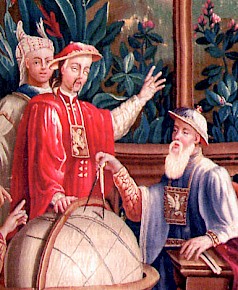 Kangxi Emperor
Kangxi Emperor
with a Jesuit astronomerBetween 1646 and 1720, the dispute embroiled Pope Clement XI (papacy 1700–1721), the Chinese Emperor Kāngxī 康熙帝 (1654–1722), scholars of European universities, and the Holy See’s Sacred Congregation for the Propagation of the FaithThe congregation was founded by Pope Gregory XV in 1622, but after a name change, it is currently the Congregation for the Evangelization of Peoples..
Pope Clement XI issued the decree Cum Deus OptimusThe decree title in Latin means “With the Best God.” in 1704, in which he condemned the Confucian and Chinese folk rites. Specifically, the Pope
-
forbade the use of Tiān 天 “Heaven” and Shàngdì 上帝 “Lord Above,” but allowed the term Tiānzhǔ 天主 “Lord of Heaven” as names for God;
-
proscribed Christians from participating in Confucian rites; and
-
prohibited Christians from participating in rites of the Chinese folk religion such as ancestor worship or rites during which the soul of a deceased person is directed to the afterworld.
In 1715, Pope Clement XI further condemned the practice of Chinese religious rites in his papal bull Ex illa dieA papal bull is a sealed decree of the Pope. The meaning of the Latin title Ex illa die is “from that day.”. Chinese Emperor Kāngxī was vexed by the papal decree, changed his benevolent attitude toward Christianity, and banned Christian missionary activities in his imperial decree of 1721Li Dun Jen (1969, p. 224) translated the following from the Decree of Kāngxī: “Reading this proclamation, I have concluded that the Westerners are petty indeed. It is impossible to reason with them because they do not understand larger issues as we understand them in China. There is not a single Westerner versed in Chinese works, and their remarks are often incredible and ridiculous. To judge from this proclamation, their religion is no different from other small, bigoted sects of Buddhism or Taoism. I have never seen a document, which contains so much nonsense. From now on, Westerners should not be allowed to preach in China, to avoid further trouble.”. The Chinese Rites Controversy undermined the relationship between the Catholic Church and the Chinese government. Relationships have not been restored, even today.
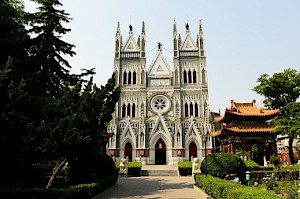 The Běitáng Church 西什库北教堂The Běitáng Church in Běijīng was built by the Chinese Emperor Kangxi 康熙皇帝 in 1703.During the Chinese Rites Controversy, French missionary Jean Basset 巴设 (1662-1707) of the Paris Foreign Mission SocietyThe Missions Etrangères de Paris is a Roman Catholic missionary organization established in 1663 by instruction of the Holy See’s Sacred Congregation for the Propagation of the Faith. The organization’s original purpose was to be independent of the Spanish and Portuguese colonial powers, and this organization remains active today, especially in East Asia. noted the lack of Bible translations into Chinese. Based in Sìchuān Province, he finally undertook the task together with Chinese scholar John Xu 许若翰. Before Father Basset died in 1707, he translated 80% of the Vulgate Version of the New Testament, but his work was never printed. Englishman Hodgman brought a copy of this translation to England in 1737, where it was deposited in the library of Sir Hans SloaneThis information is based on the article by Bernward Willeke (1945) titled “The Chinese Bible Manuscript in the British Museum” in Catholic Biblical Quarterly 7, pp. 450–453. and later in the British Museum. Protestant missionary Robert Morrison made a copy of this text, which he used for his translation of the Bible in 1823.
The Běitáng Church 西什库北教堂The Běitáng Church in Běijīng was built by the Chinese Emperor Kangxi 康熙皇帝 in 1703.During the Chinese Rites Controversy, French missionary Jean Basset 巴设 (1662-1707) of the Paris Foreign Mission SocietyThe Missions Etrangères de Paris is a Roman Catholic missionary organization established in 1663 by instruction of the Holy See’s Sacred Congregation for the Propagation of the Faith. The organization’s original purpose was to be independent of the Spanish and Portuguese colonial powers, and this organization remains active today, especially in East Asia. noted the lack of Bible translations into Chinese. Based in Sìchuān Province, he finally undertook the task together with Chinese scholar John Xu 许若翰. Before Father Basset died in 1707, he translated 80% of the Vulgate Version of the New Testament, but his work was never printed. Englishman Hodgman brought a copy of this translation to England in 1737, where it was deposited in the library of Sir Hans SloaneThis information is based on the article by Bernward Willeke (1945) titled “The Chinese Bible Manuscript in the British Museum” in Catholic Biblical Quarterly 7, pp. 450–453. and later in the British Museum. Protestant missionary Robert Morrison made a copy of this text, which he used for his translation of the Bible in 1823.
After several private projects of Scripture translation by Catholics in the eighteenth century, Jesuit Louis de Poirot 贺请泰 (1735–1814) translated the New Testament and most of the Old Testament into Chinese. The manuscript was preserved for a long time in the Běitáng Church 北堂 Library in Běijīng, and is now held in Shànghǎi. The translation was based on the Vulgate. Basset and de Poirot’s translations are difficult to understand for modern Chinese speakers as the following excerpt of the Gospel of Luke illustrates.
Gospel of Luke 1: 13-19
| Basset’s Translation (1707) | De Poirot’s Translation (1814) | Chinese Union Translation (1919) | NIV English Translation (1979) |
|---|---|---|---|
| 13 […] 尔妻依撒伯,将与尔生子,尔必名之若翰 […] | 13 […] 尔妻依撒伯尔要与你一子,尔宜取名若翰 […] | 13 […] 你的妻子伊利沙伯要给你生一个儿子,你要给他起名叫约翰 […] | 13 […] Your wife Elizabeth will bear you a son, and you are to call him John […] |
| 14 […] 且众以其生为乐矣。 | 14 […] 尔得此子,尔心乐多,人亦大喜。 | 14 […] 有许多人因他出世,也必喜乐。 | 14 […] and many will rejoice because of his birth, |
| 15 盖其为大主前,酒与麯皆不饮,犹在母腹,而满得圣风矣。 | 15 此子在主前本是大,他不宜饮酒及凡从菓压出的汁,自母腹即满被圣神。 | 15 他在主面前将要为大,淡酒浓酒都不喝,从母腹里就被圣灵充满了。 | 15 for he will be great in the sight of the Lord. He is never to take wine or other fermented drink, and he will be filled with the Holy Spirit even before he is born. |
| 16 且多化依腊尔子归于厥主神。 | 16 使多依斯拉耶耳嗣妇本主。 | 16 他要使许多以色列人回转,归于主他们的 神。 | 16 He will bring back many of the people of Israel to the Lord their God. |
| 18 […] 我妻亦暮年矣。 | 18 […] 妻年亦迈。 | 18 […] 我的妻子也年纪老迈了。 | 18 […] and my wife is well along in years. |
| 19 […] 我乃加别尔在神前者,使出语尔,报此福音。 | 19 […] 我是上主前的加彼厄尔,我奉命语尔,报尔此佳音。 | 19 […] 我是站在 神面前的加百列,奉差而来对你说话,将这好信息报给你。 | 19 […] I am Gabriel. I stand in the presence of God, and I have been sent to speak to you and to tell you this good news. |
The nineteenth and twentieth centuries are the era of Protestant Scripture translation. The milestone in this process is the publication 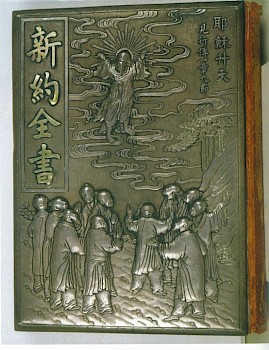 Wényán New Testament, 1814This is one of four copies of the New Testament (1814) in Wényán 文言 that was presented to Emperor Pŭ Yí 溥仪. A Chinese official saved this copy during the political turmoil of 1911, and it was later given to the American Bible Society in 1944. See Noss, Phil (2007). A History of the Bible Translation. Rome: Edizioni di Storia e Letteratura.of the Chinese Union Version in 1919, which is the authoritative and most prevalent Bible version of the twentieth century in China. This Bible is the endpoint of 100 years of rivalries, disappointments, and strugglesThe Term Question Controversy, which became the tangled part of the Chinese Rites Controversy mentioned earlier, was one important source of conflict. It developed in two stages. During the first stage between 1846 and 1855, Walter Henry Medhurst combed the Chinese Classics to define the meaning of Shén 神 and Shàngdì 上帝. According to Medhurst’s study, Shàngdì is perceived as the source of creation, the one without origin, while Shén is an emanation of Shàngdì that has to fulfill a function. He argued that the pair Shàngdì/Shén can render the dichotomy that exists in English between God/gods. James Legge supported this view by claiming that in ancient times, the Chinese believed in monotheism, which was then supplanted by polytheism. The terms Shàngdì and Shén are roughly representative of these two periods. William Boone dissented from this view. He emphasized that the Hebrew Elohim is a generic term, not a proper name, that must be rendered as such in other languages. For Boone, the generic term is Shén, not Shàngdì. No agreement was reached at this point. During the second stage of the Term Question Controversy, between 1863 and 1877, members of the Běijīng committee pushed for the use of the Catholic term Tiānzhŭ 天主 “Lord of Heaven,” which was met with resistance. The term was perceived as being merely definitional and too close to Catholicism. In the following years, the British and Foreign Bible Society (BFBS) printed its Bibles with Shàngdì, while the American Bible Society used the term Shén or Tiānzhŭ. The controversy has not been resolved, but Chinese members of the Union Bible committees preferred the term Shén, which was used in the Union Bible of 1919 with a preceding blank case. and finally achieves a consensus between missionaries of different countries.
Wényán New Testament, 1814This is one of four copies of the New Testament (1814) in Wényán 文言 that was presented to Emperor Pŭ Yí 溥仪. A Chinese official saved this copy during the political turmoil of 1911, and it was later given to the American Bible Society in 1944. See Noss, Phil (2007). A History of the Bible Translation. Rome: Edizioni di Storia e Letteratura.of the Chinese Union Version in 1919, which is the authoritative and most prevalent Bible version of the twentieth century in China. This Bible is the endpoint of 100 years of rivalries, disappointments, and strugglesThe Term Question Controversy, which became the tangled part of the Chinese Rites Controversy mentioned earlier, was one important source of conflict. It developed in two stages. During the first stage between 1846 and 1855, Walter Henry Medhurst combed the Chinese Classics to define the meaning of Shén 神 and Shàngdì 上帝. According to Medhurst’s study, Shàngdì is perceived as the source of creation, the one without origin, while Shén is an emanation of Shàngdì that has to fulfill a function. He argued that the pair Shàngdì/Shén can render the dichotomy that exists in English between God/gods. James Legge supported this view by claiming that in ancient times, the Chinese believed in monotheism, which was then supplanted by polytheism. The terms Shàngdì and Shén are roughly representative of these two periods. William Boone dissented from this view. He emphasized that the Hebrew Elohim is a generic term, not a proper name, that must be rendered as such in other languages. For Boone, the generic term is Shén, not Shàngdì. No agreement was reached at this point. During the second stage of the Term Question Controversy, between 1863 and 1877, members of the Běijīng committee pushed for the use of the Catholic term Tiānzhŭ 天主 “Lord of Heaven,” which was met with resistance. The term was perceived as being merely definitional and too close to Catholicism. In the following years, the British and Foreign Bible Society (BFBS) printed its Bibles with Shàngdì, while the American Bible Society used the term Shén or Tiānzhŭ. The controversy has not been resolved, but Chinese members of the Union Bible committees preferred the term Shén, which was used in the Union Bible of 1919 with a preceding blank case. and finally achieves a consensus between missionaries of different countries.
The struggle for an authoritative Chinese Bible was shaped by the struggle for a lingua franca that could unify the whole country, which was intense at the turn of the twentieth century. Since the Tang dynasty (A.D. 618-907), there were two literary standards, Wényán 文言The nineteenth century missionaries called Wényán 文言 “High Wénlǐ” 深文理, but it is not a standard name used in China., the classical literary language, and Báihuà 白話The nineteenth century missionaries called Báihuà 白話 “Easy Wénlǐ” 易文理, but it is not a standard name used in China., the vernacular standard of ordinary people.
Wényán 文言 enjoyed great prestige among the population in the early twentieth century and was accorded the status of the language of the learned. The vast majority of Chinese literature, history, philosophy, and other sciences were written in Wényán 文言, the only truly national form of Chinese. Like Latin, Wényán 文言 and Báihuà 白話 are written languages that cannot be spoken. They are different from any current Chinese dialect and thus cannot assume the role of a lingua franca.
In 1913, a language commission was established in Beijing with representatives from all over China. A controversy erupted over which dialect should be selected as China’s lingua franca. Finally, the northern representatives forced their point, resulting in the Beijing dialect being chosen as the Standard Language.
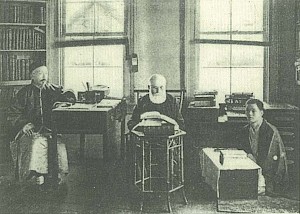 Joseph Schereschewsky
Joseph Schereschewsky
施约瑟 (1831-1906)Samuel Isaac Joseph Schereschewsky 施约瑟 (1831–1906) was a Lithuanian Jew, who studied in Germany, emigrated to the United States, converted to the Christian faith, studied theology at the General Theological Seminary of the Episcopal Church in New York, and volunteered as a missionary. He was sent to China by the American Episcopal Mission, which belonged to the network of Anglican missions, and arrived in Shànghăi in 1859. He founded St. John’s College and was ordained as the Anglican Bishop of Shànghăi in 1877. He was a member of the translation committee for the Standard Běijīng language, and he translated most of the Old Testament. He was a Bible translator extraordinaire whose work influenced the Chinese Union Version of 1919.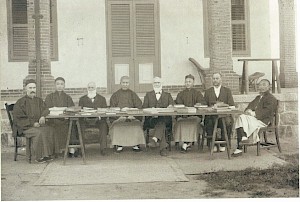 Translators of the
Translators of the
Chinese Union Version in 1906The photo appeared in “China and the Gospel,” Annual Report of the China Inland Mission, 1906. In the nineteenth century, five different complete translations of the Bible into Wényán 文言 were completed, with the first two under intense governmental persecution:
-
1822: by Joshua Marshman 马士曼Joshua Marshman 马士曼 (1768-1837) was a colleague of Willian Carey and was based at the Baptist Serampore Mission in Calcutta, India. Marshman and Carey coordinated Bible translation into several Indian languages. With the assistance of Johannes Lassar, he published the Chinese Bible incrementally in Serampore. and Johannes Lassar 拉撒尔Johannes Lassar 拉撒尔 was an Armenian born in Macao. He prepared a first draft of the New Testament in 1816 based on the Greek text and the English King James Version. He and Marshman used the term Shén 神 “God,” Shèng Fēng 圣风 “Holy Spirit,” and zhàn 蘸 “baptize.” (Baptist Missionaries);
-
1823: by Robert Morrison 马礼逊Robert Morrison 马礼逊 (1782–1834) was sent by the London Missionary Society 伦敦传道会 to China, and he arrived in Macao in 1807. Under intense governmental persecution, he completed a translation of the Bible in 1823. He returned to the United Kingdom on a furlough in 1824, where he was made a fellow of the Royal Society for his work on a Chinese-English dictionary. He was also awarded the title of Doctor of Divinity by the University of Glasgow. The keywords Morrison used in his translation of the Bible were the terms Shén 神 “God,” Shèng Fēng 圣风 “Holy Spirit,” and xĭ 洗 “baptize.” and William Milne 米憐William Milne 米憐 (1785–1822) was the second missionary of the London Missionary Society who was sent to China. He arrived in Macao in 1823 and was the only assistant of Robert Morrison. He baptized Chinese evangelist Liáng Fā 梁发, who later preached the gospel to the Chinese rebel leader Hóng Xiùquán 洪秀全. In 1815, Milne moved to the Malayan Straits Settlement of Malacca (present-day Malaysia), where he continued to serve Chinese immigrants. Collaborating with Robert Morrison on the translation of the Chinese Bible, he contributed by translating the books of Deuteronomy through Job. (London Missionary Society);
-
1847: by W. H. Medhurst 麦都思Walter Henry Medhurst 麦都思 (1796–1857) was a missionary of the London Missionary Society. He was sent to Malacca in 1816, where he learned Malay and Chinese. In 1842, he moved to Shànghăi and collaborated with Karl Gützlaff and Elijah Bridgman on the translation of the Bible in Classical Chinese, which was completed in 1847. He was an influential discussant in the Term Question Controversy; he had combed Chinese Classics for different names for God., K. Gützlaff 郭士立Karl Gützlaff 郭士立 (1803–1851) was a German missionary who went to Singapore and Bangkok, where he translated the Gospel of Luke in Thai in 1834. He then moved to Macao and Hong Kong, made short trips to Japan, and successfully translated the Gospel and Epistles of John in Japanese in 1837. After 1840, he started working on a Chinese Bible translation in cooperation with William Henry Medhurst and Elijah Bridgman. He contributed by translating most of the Old Testament. The entire Bible was completed in 1847. Due to the government’s interdiction of foreign missionary activities in Inner China, he started a school of “native missionaries.” In 1851, he discovered the fraud of the “missionaries” whom he had engaged: these “missionaries” reported activities at places to where they had never traveled. Shortly afterwards, he died. As a prolific writer, he inspired numerous people in Europe. A street in Hong Kong is named after him., and E. Bridgman 裨治文The American Board of Commissioners for Foreign Missions appointed Elijah Coleman Bridgman 裨治文 (1801–1861) as its first missionary for service in China, and he arrived in Guăngzhōu in 1830. He contributed to the translation of the Bible in Classical Chinese and was active in Christian education. He later moved to Shànghăi, where he died and was buried with his wife., whose translation was adopted by Hóng Xiùquán 洪秀全Hóng Xiùquán 洪秀全 (1814–1864) was a Chinese Hakka rebel leader who led an insurrection against the Manchu Government (Spence 1996). When he failed the provincial examinations on four occasions, he saw visions of a fatherly and of a brotherly figure. After a Christian missionary provided him with summaries of the Bible, he interpreted the fatherly figure as God the Father, the brotherly figure as Jesus Christ, and proclaimed himself the younger brother of Jesus Christ. During the 1840s, he received further instructions by Christian missionaries and adopted the translation of Medhurst, Gützlaff, and Bridgman as the doctrinal base of his emerging organization of believers. In 1851, Hóng Xiùquán gathered 30,000 followers and tensions with the Manchu government arose. He rebelled when the government troops tried to disperse his followers. Hóng defeated the government troops, occupied Nánjīng in 1853, and established a kind of theocracy, the Heavenly Kingdom or Tàipíngtiānguó 太平天囯. His rule was terminated in 1864 when government forces overcame the rebel’s defense lines, and Hóng Xiùquán was killed in 1864. He continued to inspire the Miao rebel movement in Guìzhōu., the leader of the Tàipíngtiānguó 太平天囯 movement;
-
1854: the Delegates’ VersionIn 1843, 12 missionaries representing various missionary organizations decided to revise the Bible. They established committees in the five ports determined in the Treaty of Nánjīng of 1842: Shànghǎi 上海, Guăngzhōu 广州, Níngbō 宁波, Fúzhōu 福州, and Xiàmén 厦门. Each committee sent a delegate (hence the name Delegates' Version) to a central committee that made final decisions on different issues. by W. H. Medhurst 麦都思, W. J. Boone 文惠廉William Jones Boone 文惠廉 (1811–1864) was a missionary of the American Episcopal Mission, who arrived in Macao 1839 and relocated to Shànghăi in 1844, where he served as an Anglican Bishop until his death. He was on the committee of the Delegates’ Version and played an influential role in the “Term Question” controversy. He argued for the use of Shén 神 for God., W. M. LowrieWalter Macon Lowrie 娄理华 (1819–1847) was a missionary appointed by the American Presbyterian Mission. He arrived in China in 1842., J. StronachJohn Stronach 施敦力 (1810–1888) was a British missionary of the London Missionary Society. He was stationed in Xiàmén 厦门 and was the representative of the Xiàmén committee on the Delegates’ Version committee., and E. C. Bridgman 裨治文; and
-
1863: by E. C. Brigdman 裨治文 and M. S. Culbertson 克陛存Michael Simpson Culbertson 克陛存 (1819–1862) was a missionary of the American Presbyterian Mission. He was stationed in Níngbō from 1845 to 1851 and later in Shànghǎi from 1851 to 1862. after they separated from the Delegates’ Committee.
In the 1880s, the Protestant churches were disappointed in the lack of an authoritative translation and convened a General Mission ConferenceSee Zetzsche, Jost (1999). “The Work of Lifetimes: Why the Union Version Took Nearly Three Decades to Complete.” In Bible in Modern China: The Literary and Intellectual Impact, edited by Irener Eber, Sze-Kar Wan, and Knut Walf, 77–100. Sankt Augustin: Institut Monumenta Serica. in 1890 to prepare a new translation in Wényán 文言, Báihuà 白話, and Vernacular Mandarin Chinese, the speech of Beijing. Three translation committees were formed.
As it became increasingly clear that Mandarin would become the lingua franca, the classical language committees were dissolved by 1907, and the Mandarin translation was published in 1919 under the name Chinese Union Version. It remains the authoritative Chinese Bible version but was revised once in 2010 by the Hong Kong Bible Society.
Besides the Classical languages and Mandarin Chinese, missionaries also translated the Bible into other Chinese dialects. The European and Chinese definitions of “language” 语言 and “dialect” 方言 differ throughout history. In the European understanding, two speeches are dialects if they are intelligible; they are languages if not. The Chinese use ethnic and political traits to correlate two speeches. Two speeches are dialects if the people who use them share the same ethnic group or nationality; they are two languages if they belong to different groups.
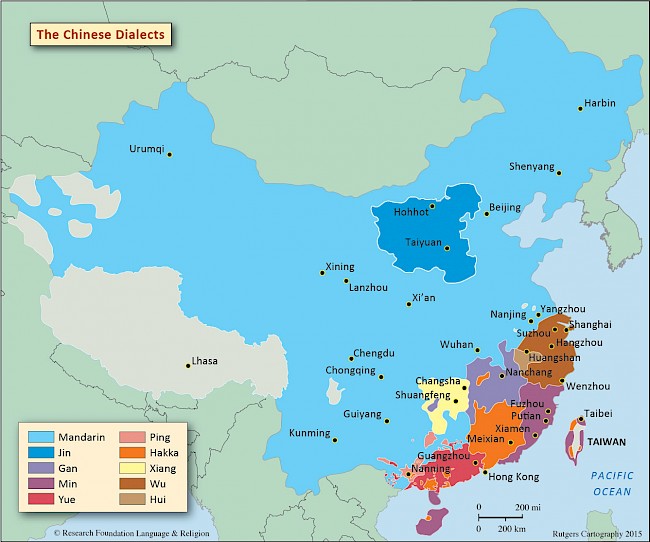 Speakers of the Chinese dialects are the ethnic Hàn 汉, but the linguistic variation between these dialects is comparable to or even more significant than that of the Germanic or Romance languages. There are nine Chinese dialect groups, and each has a complex subsystem.
Speakers of the Chinese dialects are the ethnic Hàn 汉, but the linguistic variation between these dialects is comparable to or even more significant than that of the Germanic or Romance languages. There are nine Chinese dialect groups, and each has a complex subsystem.
|
Dialect Group |
Population |
|---|---|
|
Mandarin 官 |
960 Million |
|
Jìn 晋 |
48 Million |
|
Gàn 赣 |
31 Million |
|
Mǐn 闽 |
70 Million |
|
Yuè 粤 |
60 Million |
|
Píng平 |
3.8 Million |
|
Hakka 客家 |
30 Million |
|
Xiāng 湘 |
38 Million |
|
Wú 吴 |
80 Million |
|
Huī 徽 |
4.6 Million |
Table 3: The Chinese Dialects
Translations of the Bible in Chinese dialects emerged shortly after the completion of the first Bibles in Wényán 文言. Bibles in Mandarin were published in 1874, in four different Mǐn 闽 dialects in 1884–1922, in Cantonese in 1894, in four different Wú 吴 dialects in 1901–1914, and in Hakka in 1916. Portions of the Bible were translated in 25 different Chinese dialects. Details are displayed in the following chart.
|
ISO639-3 |
Dialect |
Chinese Dialect Group |
BookThe first translation of one of the sixty-six books of the Bible. | NTThe first translation of the New Testament. | BibleThe first translation of the entire Bible. |
|
ltc |
Middle Chinese |
Root |
650 (?)A stela was found in Xī’ān in 1625 commemorating Christian activities in China during the Tang dynasty (A.D. 618–907). The stela was erected in A.D. 781, after the Nestorian missionaries had evangelized the local population for some time. The text on the stela includes the mention “Scriptures were translated,” which refers to the translation of some portion of the Bible, although no text has been preserved. In 1907, Christian documents were found in the Mògāo Caves 莫高窟 in Dúnhuāng 敦煌 that mentioned Chinese translations of the Pentateuch (referred to as “牟世法王经”), including the Book of Genesis (“浑元经”), translation of the Psalms (“多惠圣王经”), the Gospels (“阿思翟利容经”), Acts of Apostles (“传代经”), and a few others. The language in which these portions were translated was Middle Chinese. |
|
|
|
lzh |
High Wénlǐ 深文理This term, coined by missionaries, designates the Classical Chinese language spoken during B.C. 500-A.D. 200. |
Literary 文言文 |
1810The first complete book of the Bible was the Gospel of Matthew, which was translated by Joshua Marshman and Johannes Lassar in Serampore, India, in 1810. It was based on the Greek text and the English King James Version. Within the same year, Robert Morrison, who was assisted by William Milne, published the Acts of the Apostles in Guăngzhōu 广州. Morrison’s translation relied on the Greek text, Jean Basset’s 1707 translation, and the English King James Version. | 1814The New Testament was first completed by Robert Morrison and William Milne in 1814. However, Joshua Marshman and Johannes Lassar completed another version of the New Testament in 1816. | 1822Joshua Marshman and Joannes Lassar completed and published the entire Bible in Serampore in 1822. Robert Morrison, with the support of William Milne, translated another version of the entire Bible in 1819 but published it in Guăngzhōu 广州 in 1823. The Delegates’ Version was completed in 1855 by W. H. Medhurst (London Missionary Society), W. J. Boone (American Episcopal Mission), W. M. Lowrie (American Presbyterian Mission), J. Strotrach (London Missionary Society), and E. C. Bridgman (American Board of Commissioners for Foreign Missions). |
|
lzh |
Easy Wénlǐ 易文理Easy Wénlǐ 易文理 is also a term created by missionaries and corresponds to simplified Classical Chinese, in which the literary balance and richly embroidered figures of speech are abandoned in favor of a more direct communication of ideas. Easy Wénlǐ 易文 and High Wénlǐ 深文理 were superseded by Mandarin Chinese after 1919. |
Literary 文言文 |
1883The Gospels of Mark and John were first translated in 1883 by Griffith John (London Missionary Society). | 1885The New Testament was first completed in 1885 by Griffith John (London Missionary Society). | 1902The entire Bible was completed in 1902 by S. I. J. Schereschewsky (American Episcopal Mission) and others from the Easy Wénlǐ Union Bible Committee, and it was published in the same year by the American Bible Society in Shànghăi. |
|
cmn |
Standard 普通话 |
Guān 官, Běijīng 北京 |
1864In Standard Chinese, the Gospel of John was first translated in 1864 by the Beijing Committee, which included William A. P. Martin (American Presbyterian Mission), Joseph Edkim, (London Missionary Society), S. I. J. Schereschewsky (American Episcopal Mission), J. S. Burdon (Church Missionary Society), and H. Blodget (American Board of Commissioners for Foreign Missions). The Beijing Committee was appointed in 1861. | 1872The New Testament was first translated in 1872 by the Beijing Committee. | 1874The Old Testament was completed in 1874 by S. I. J. Schereschewsky. His Old Testament version and the Beijing Committee’s New Testament version became the standard Mandarin Bible until the publication of the Union Version. In 1919, the Union Bible Committee, which included J. Edkins, J. Wherry, D. Z. Sheffield, T. W. Pearce, and L. Lloyd, completed an authoritative Bible translation, which is still in use today. The Chinese Union Version was published in 1919 by the American Bible Society in Shànghăi. The first integral Catholic translation of the Bible was completed in 1953 by a team led by Italian Father Gabriele M. Allegra (1907–1976) in Hong Kong. |
|
cmn |
Nánjīng 南京 |
Guān 官, Jiānghuái 江淮 |
1854The Gospel of Matthew was translated in 1854 from the Delegates’ Wénlǐ Version by a Chinese, under the supervision of W. H. Medhurst and J. Stronach (both from the London Missionary Society). | 1857The New Testament was completed under the same circumstance in 1857. It was published in the same year by the British and Foreign Bible Society (BFBS) in Shànghăi. |
|
|
cmn |
Yāntái 烟台Kiaotung is an older name for this Guān dialect spoken in Yāntái 烟台, a city in Shāndōng Province. |
Guān 官, Jiāoliáo 胶辽 |
1918The Gospel of Mark was translated in 1918 by missionaries of the North China Baptist Mission, a branch of the American Southern Baptist Mission. |
|
|
|
cmn |
Jǐnán 济南 |
Guān 官, Jìlǔ 冀鲁 |
1892The Gospels of Luke and John were translated in 1892 by C. H. Judd and E. Tomalill (China Inland Mission). |
|
|
|
cmn |
Wǔhàn 武汉The city is formerly known as Hànkǒu 汉口 from which modern-day Wǔhàn 武汉 evolved. |
Guān 官, Xīnán 西南 |
1921The Gospel of Mark was first translated in 1921 by J. H. L. Patterson (London Missionary Society). |
|
|
|
hak |
Méizhōu 梅州The Hakka language in Meixian 梅县 (literally “Plum County”), a district in Méizhōu 梅州 Prefecture, Northeastern Guǎngdōng Province, is the standard dialect of Hakka. |
Hakka 客家 |
1860The Gospel of Matthew was first translated in 1860 by missionaries of the Basel Missionary Society, including R. Lechler, P. Wilmes, C. P. Piton, and Kong Fatlin, an ordained Chinese pastor. It was published in Berlin in the same year. | 1883The first New Testament was completed in 1883 by missionaries of the Basel Missionary Society, including the same individuals who completed the Gospel of Matthew. The version using the Roman script was published in Basel in 1883 by the BFBS, while the version using Chinese characters was published in Guăngzhōu in the same year by the BFBS. | 1916The first entire Bible in Chinese characters was completed in 1916 by A. Nagle, G. A. Guzman, and W. Ebert (all from the Basel Missionary Society) and was published in Shànghăi in the same year by the BFBS. The Bible was retranslated between 1984 and 2012 and published by the Bible Society in Taiwan in Taibei in 2012, in both Romanized Hakka and Chinese characters. |
|
hak |
Hépó 河婆Wukingfu 五经富 is a town in Hépó 河婆, which is a subdistrict of Jiēxī 揭西 County in Guangdong Province. The English Presbyterian Mission established a mission there in 1871. |
Hakka 客家 |
|
1916The first New Testament was translated by a committee of the English Presbyterian Mission, including M.C. Mackenzie and Phang Ki Fung. |
|
|
hak |
Lóngyán 龙岩A former name of this Hakka dialect was the Tīngzhōu 汀州 dialect. |
Hakka 客家 |
1919The Gospel of Matthew was translated in 1919 by C. R. Hughes and E. R. Rainey (London Missionary Society). |
|
|
|
cdo |
Fúzhōu 福州 |
Mǐn 闽, Eastern 东 |
1852The Gospel of Matthew was first translated into the Fúzhōu 福州 subdialect of Eastern Mǐn in 1852 by Moses Clark White 怀德 (American Methodist Episcopal Mission) and published in Fúzhōu by the American Bible Society in the same year. | 1856The New Testament was first completed in 1856 by William Welton 温敦 (Church Missionary Society) and Lyman Birt Peet 弼利民 (American Board of Commissioners for Foreign Missions), and it was published by the American Bible Society in Fúzhōu in the same year. | 1891The Old Testament was completed by a committee, which included Caleb Cook Baldwin 摩嘉立, James Walker (both with the American Board of Commissioners for Foreign Missions), John Richard Wolfe 胡約翰, Llwellyn Lloyd, William Banister (all with the Church Missionary Society), and Nathan Plumb (American Methodist Episcopal Mission), in 1888. A revised version of the Old Testament and the New Testament was jointly published as the first complete Bible by the American Bible Society and BFBS in 1891. |
|
mnp |
Shàowǔ 邵武 |
Mǐn 闽, Northern 北 |
1891The Epistle of James was translated in 1891 by J. E. Walker (American Board of Commissioners for Foreign Missions). |
|
|
|
mnp |
Jiàn'ōu 建瓯 |
Mǐn 闽, Northern 北 |
|
1896The first New Testament was translated and revised in 1896 by L. J. Bryer (Church of England Zenana Missionary Society). |
|
|
mnp |
Jiànyáng 建阳 |
Mǐn 闽, Northern 北 |
1898The Gospel of Mark was first translated in 1898 by Mr. and Mrs. H. S. Phillips (Church Missionary Society). |
|
|
|
cpx |
Púxiān 莆仙The older name for the Púxiān Mǐn 莆仙闽 dialect is Hinghua Mǐn 兴化话 spoken in Pútián 莆田 County. |
Mǐn 闽, Púxiān 莆仙 |
1892William Nesbitt Brewster 蒲魯士 (American Methodist Episcopal Mission) translated the Gospel of John into Púxiān Mǐn in 1892. | 1902Aided by native speakers, W. N. Brewster 蒲魯士 (American Methodist Episcopal Mission) completed the first New Testament in Púxiān Mǐn in 1902. | 1912W. N. Brewster 蒲魯士 (American Methodist Episcopal Mission) completed the first entire Bible in 1912. It was published in the same year by the American Bible Society. |
|
nan |
Teochew 潮汕 |
Mǐn 闽, Southern 南 |
1875The Book of Ruth was translated in 1875 by S. B. Partridge (American Baptist Missionary Union). | 1896The New Testament was completed in 1896 by missionaries including S. B. Partridge, W. Ashmore, and A.M. Fields (American Baptist Missionary Union). | 1922The entire Bible was completed in 1922 by English Presbyterian Missionaries, including W. Duffus, George Smith, J. C. Gibson, and H. L. Mackenzie. |
|
nan |
Hainanese 海南 |
Mǐn 闽, Southern 南 |
1891In 1891, C. C. Jeremiassen (American Presbyterian Mission) translated the Gospel of Matthew with the help of F. P. Gilman. |
|
|
|
nan |
Hokkien 福建Hokkien has three subdialects: the Quanzhou, Zhangzhou, and Xiamen (Amoy) dialects, which are all spoken in Fujian Province and Taiwan. The Bible was translated into the Xiamen (Amoy) dialect. |
Mǐn 闽, Southern 南 |
1852The Gospel of John was first translated in 1852 by Elihu Doty (Dutch Reformed Mission) and published in the same year by the BFBS in Guăngzhōu. | 1873The New Testament was translated into the Amoy dialect by the first missionary to Taiwan, James Laidlaw Maxwell 马雅各 (English Presbyterian Church) in 1873, by using the Pe̍h-ōe-jī orthography. | 1884The Old Testament was completed in the Amoy dialect by James Laidlaw Maxwell 马雅各 (English Presbyterian Church) in 1884, by using the Pe̍h-ōe-jī orthography. In 1930, Thomas Barclay 巴克礼 (English Presbyterian Church) retranslated the New Testament in 1916 and the entire Bible, using the Romanized Pe̍h-ōe-jī orthography. The Amoy Romanized Bible was published in 1933. It was later transliterated in Chinese characters and published in 1996. |
|
wuu |
Wēnzhōu 温州 |
Wú 吴, Ōujiāng 瓯江 |
1892W. E. Soothill (United Methodist Free Church) translated and revised the Gospel of Matthew in 1892. | 1902W. E. Soothill (United Methodist Free Church) translated the entire New Testament in 1902. The manuscript was published in the same year by the BFBS. |
|
|
wuu |
Shànghǎi 上海 |
Wú 吴, Tàihú 太湖 |
1847Walter Henry Medhurst 麦都思 (London Missionary Society) translated the Gospel of John in 1847 and privately published it in Shànghăi in the same year. | 1870The New Testament was completed in 1870 by John Marshall Willoughby Farnham 法納姆 (American Presbyterian Mission) and published in Roman characters by the American Bible Society in Shànghăi in the same year. | 1908The entire Bible was completed in 1913 by the Shànghăi Bible Committee and published by the American Bible Society in Shànghăi. |
|
wuu |
Níngbō 宁波 |
Wú 吴, Tàihú 太湖 |
1852The Gospel of Luke was translated in 1852 by missionaries in Níngbō, including W. A. Russell (Church Missionary Society), D. B. McCartee, W. A. P. Martin, and H. V. V. Rankin (American Presbyterian Mission). | 1868The New Testament was completed in 1868 by J. H. Taylor (China Inland Mission), F. F. Gough, and G. E. Moule (Church Missionary Society). A revised edition was published in 1874 by the American Bible Union in Shànghăi. | 1901The entire Bible was completed in 1901 by R. Goddard (American Baptist Missionary Union), W. S. Moule (American Presbyterian Mission), and N. B. Smith (Church Missionary Society). It was published in the same year by the BFBS in Shànghăi. |
|
wuu |
Hángzhōu 杭州 |
Wú 吴, Tàihú 太湖 |
1879The Gospel of John was first translated in 1879 by G. E. Moule (Church Missionary Society) with reference to the Beijing Mandarin version. |
|
|
|
wuu |
Sūzhōu 苏州 |
Wú 吴, Tàihú 太湖 |
1879The Gospels and Acts of Apostles were translated in 1879 by John W. Davis (American Presbyterian Mission) and published in the same year by the Shànghăi American-Chinese Book Company. | 1881The New Testament that was adapted from the Shànghăi Version by G. F. Fitch (American Presbyterian Mission) and A. P. Parker (American Southern Methodist Episcopal Mission) was completed in 1881. | 1908The entire Bible was adapted and retranslated in 1908 by J. W. Davis, D. M. Lyon, J. H. Hayes (American Presbyterian Mission), and T. C. Britton (American Southern Baptist Mission). |
|
wuu |
Tāizhōu 台州 |
Wú 吴, Tāizhōu 台州 |
1880The Gospels were translated in 1880 by W. D. Rudland (China Inland Mission), assisted by his missionary colleagues, including C. Thomson, C. H. Jose, and J. G. Kauderer. | 1881The New Testament was translated in 1881 by W. D. Rudland and his missionary colleagues: C. Thomson, C. H. Jose, and J. G. Kauderer (all with the China Inland Mission). | 1914The entire Bible was completed in 1914 by W. D. Rudland (China Inland Mission) and his colleagues. |
|
wuu |
Jīnhuá 金华 |
Wú 吴, Wùzhōu 务州 |
1866The Gospel of John was translated in 1866 by H. Jenkins (American Baptist Missionary Union) and published in the same year by the American Bible Society in Shànghăi. |
|
|
|
yue |
Liánzhōu 连州 |
Yuè 粤, Luōguǎng 罗广 |
1904The Gospel of Matthew was translated by Eleanor Chestnut 车以纶, a medical missionary of the American Presbyterian Mission in Liánzhōu in 1905. The manuscript was published by the American Bible Society in 1905. In the same year, Eleanor Chestnut was killed by villagers in Liánzhōu. |
|
|
|
yue |
Cantonese 广东话 |
Yuè 粤, Yuè-Hǎi 粤海 |
1862Charles Finney Preston 丕思业 (American Presbyterian Mission) translated the Gospels of Matthew and John into Cantonese 广东话 by 1862. The Gospels were published by the American Bible Society in Guăngzhōu in the same year. | 1877George Piercy 俾士 of the English Wesleyan Mission completed the New Testament in 1877, and it was privately printed in Guăngzhōu in the same year. | 1894The entire Bible in Cantonese was completed in 1894 by a committee of the American Presbyterian Mission, including Benjamin Couch Henry 香便文 and Henry Moyes 那夏礼. The manuscript was published by the American Bible Society. |
Table 4: Bible Translation in Chinese Dialects
 Cover of Hakka Bible,
Cover of Hakka Bible,
reprint of 1923The only Bible translations that are still used today are the Mandarin, Hokkien, and Hakka translations. Since 1949, Mandarin Chinese has gradually risen to such prominence that virtually all Hàn Chinese acquired native competence of the lingua franca.
Churches have adapted to this situation by shifting usage to the Mandarin Chinese Bible (the Chinese Union Version) in the twentieth century. The Scriptures are either entirely read in Mandarin Chinese or instantly translated into the respective dialect from the Mandarin Bible.
Since the nineteenth century, sizable Hokkien and Hakka populations migrated to other countries in Southeast Asia and North America. Hokkien (Taiwanese) is also spoken by 70% of the population in Taiwan. These Hokkien and Hakka diaspora communities continued using the Bibles of 1884 and 1916. Under the authority of the Bible Society of Taiwan, the Bibles were revised or retranslated to adapt to language use in the twenty-first century: in 2008, for Hokkien and in 2012, for Hakka.
Chinese Jews and Muslims (1)
The earliest specific evidenceScholars do not consider the mention of Sinim in Isaiah 49:12 to refer to the Chinese, nor do they accept the theory that Noah and his three sons, Shem, Ham, and Japhet, reached China, as Muslim sources from the A.D. tenth century had suggested. Scholars also disregard claims that the Chinese classics of the first millenary B.C. such as the Yìjīng 易经 or Laozi’s Dàodéjīng 道德经 are connected to the Hebrew Torah. No linkage between the Hebrew and Chinese language or script is believed to exist. Finally, scholars also reject the idea that the Chinese are linked to the Ten Lost Tribes of Israel (see Leslie 1998). of the presence of Jews in China comes from the Tang dynasty (A.D. 618–907). An eighth century manuscript in Hebrew script was found in the Mògāo Caves 莫高窟 in Dúnhuāng 敦煌, a station on the ancient Silk Road.
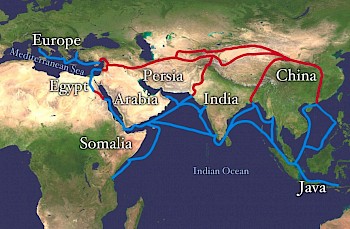 Ancient Silk Roads by Land and by SeaBC 206 – AD 1450.According to Arabic sources, Jews were among the many foreigners killed in the agitation of Khânfû (Canton 广州) in 878. The Jewish community at Kāifēng 开封 in Henan Province was founded during the Song dynasty (960–1279); their synagogue (qīngzhēnsì 清真寺) was built in 1163.
Ancient Silk Roads by Land and by SeaBC 206 – AD 1450.According to Arabic sources, Jews were among the many foreigners killed in the agitation of Khânfû (Canton 广州) in 878. The Jewish community at Kāifēng 开封 in Henan Province was founded during the Song dynasty (960–1279); their synagogue (qīngzhēnsì 清真寺) was built in 1163.
Chinese people referred to the Jewish religion as tiăojīnjiào 挑筋教, literally “the religion which removes the sinew,” which likely refers to the Jewish prohibition of eating the tendon attached to the socket of the hip (see Genesis 32:32).
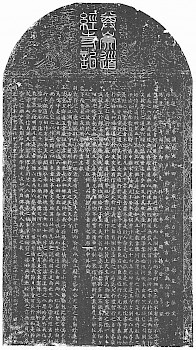 Stela of 1512Reproduced as Ink Rubbing.The Jew Moshe ben Abram (1619–1657), whose Chinese name was Zhào Yìngchéng 赵映乘, became a special envoy of the emperor at the end of the Míng dynasty 明朝 (1368–1644). He helped rebuild the Kāifēng synagogue that was destroyed in a flood in 1642. The Jewish community practiced the Rabbinic prayers and festivals. They copied 13 Torah scrolls in Hebrew. There is no information available on Jewish efforts to translate portions of the Torah into Chinese.
Stela of 1512Reproduced as Ink Rubbing.The Jew Moshe ben Abram (1619–1657), whose Chinese name was Zhào Yìngchéng 赵映乘, became a special envoy of the emperor at the end of the Míng dynasty 明朝 (1368–1644). He helped rebuild the Kāifēng synagogue that was destroyed in a flood in 1642. The Jewish community practiced the Rabbinic prayers and festivals. They copied 13 Torah scrolls in Hebrew. There is no information available on Jewish efforts to translate portions of the Torah into Chinese.
Four stelae in Chinese that are dated 1489, 1512, 1663, and 1679 were inscribed with information about the religion, festivals, and the history of the community. At its height, the Jewish community in Kāifēng had more than 5,000 members.
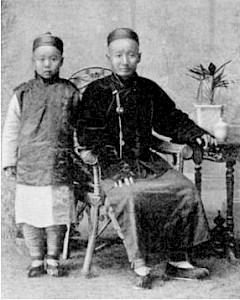 Kāifēng JewsAt the turn of the twentieth century.A number of setbacks occurred after the sixteenth century, which contributed to the decline of the Kāifēng Jewish community and of other Jewish communities in China, such as floods, calamities, and the turmoil caused by the Heavenly Kingdom 太平天国 rebellion in the nineteenth century. In 1850, the Kāifēng synagogue was reported to be in poor shape. By 1866, the synagogue had been dismantled, and no synagogue was rebuilt afterwards. Donald Leslie, the author of Jews and Judaism in traditional China, reasoned that the decline is mainly due to the lengthy isolation from other Jewish communities in the world. In the twentieth century, the Chinese government classified the Kāifēng Jews within the Hàn nationality. The Kāifēng Jews are reported to use seven Chinese surnames, among which are Lĭ 李 and Gāo 高. These surnames supposedly represent the names of Levi and Cohen.
Kāifēng JewsAt the turn of the twentieth century.A number of setbacks occurred after the sixteenth century, which contributed to the decline of the Kāifēng Jewish community and of other Jewish communities in China, such as floods, calamities, and the turmoil caused by the Heavenly Kingdom 太平天国 rebellion in the nineteenth century. In 1850, the Kāifēng synagogue was reported to be in poor shape. By 1866, the synagogue had been dismantled, and no synagogue was rebuilt afterwards. Donald Leslie, the author of Jews and Judaism in traditional China, reasoned that the decline is mainly due to the lengthy isolation from other Jewish communities in the world. In the twentieth century, the Chinese government classified the Kāifēng Jews within the Hàn nationality. The Kāifēng Jews are reported to use seven Chinese surnames, among which are Lĭ 李 and Gāo 高. These surnames supposedly represent the names of Levi and Cohen.
The Chinese Government defines the Huí 回 nationality, without regard to religion, as the descendants of Arab and Central Asian people who had settled in China during the Tang (AD 618–907) and Song (AD 960–1279) dynasties.
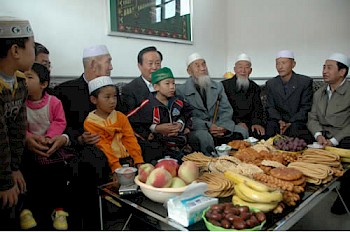 Huí family in Níngxià ProvinceThe Huí ancestors mainly originated from places along the ancient Silk Road. The overwhelming majority of the 10.5 million Huí people are Muslims. Huí communities exist across the country, but are concentrated in Northwestern China (Níngxià, Gānsù, Qīnghăi, and Xīnjiāng provinces).
Huí family in Níngxià ProvinceThe Huí ancestors mainly originated from places along the ancient Silk Road. The overwhelming majority of the 10.5 million Huí people are Muslims. Huí communities exist across the country, but are concentrated in Northwestern China (Níngxià, Gānsù, Qīnghăi, and Xīnjiāng provinces).
The Government also includes the 5,000 Utsuls 回輝 people on the Hǎinán Island within the Huí nationality. Their ancestors are Austronesian Muslims who arrived from Vietnam during the Ming dynasty (AD 1368–1644). The Huí people have no indigenous language but speak Mandarin Chinese. As they are Muslims, part of their religious vocabulary differs from that of the Hàn Chinese.
 Huí Bible (2010)Information on the number of Huí Christians is unknown. In 2010, an anonymous mission organization published a Huí Bible in Hong Kong. The language of this Bible is similar to that of the Chinese Union Version (Hong Kong Bible Society) or Chinese New Version (World Wide Bible Society), except for keywords such as God, Jesus, or Christ. Some differences are listed below.
Huí Bible (2010)Information on the number of Huí Christians is unknown. In 2010, an anonymous mission organization published a Huí Bible in Hong Kong. The language of this Bible is similar to that of the Chinese Union Version (Hong Kong Bible Society) or Chinese New Version (World Wide Bible Society), except for keywords such as God, Jesus, or Christ. Some differences are listed below.
The differences relate to how the Huí people traditionally transliterate religious terms from Arabic into Chinese. For example, the term Màixīhā 麦西哈 is a transliteration of “Messiah” in Arabic or Hebrew, while the term Jīdū 基督 is a transliteration of “Christ” in Greek. The different choice for the name of God, “True Lord” (Huí) versus the polytheistic concept of Shén 神 (Hàn), is reminiscent of the nineteenth century when Protestant missionaries disagreed on using Shén 神 versus Shàngdì 上帝.
|
Huí Bible (2010) |
Chinese Union Version (1919) |
English |
Reference |
|---|---|---|---|
| 真主 | 神 |
God (Yahweh) |
Mt. 3:9 |
| 主 | 主 |
Lord |
Mt. 4:7 |
| 神明 | 神 |
god (not Yahweh) |
Jn. 10:35 |
| 尔撒 | 耶稣 |
Jesus |
Mt. 1:1 |
| 麦西哈 | 基督 |
Christ |
Mt. 1:17 |
| 麦西哈的弟子 | 基督徒 |
Christian |
Ac. 11:26 |
| 易卜劣厮 | 魔鬼 |
devil |
Mt. 4:1 |
| 天仙 | 天使 |
angel |
Mt. 13:39 |
| 佳音 | 福音 |
Good News |
Mt. 4:23 |
| 礼拜堂 | 会堂 |
Synagogue |
Mt. 4:23 |
| 哲玛提 | 教会 |
Church |
Mt. 16:18 |
| 坟坑 | 阴间 |
Hades |
Mt. 11:23 |
Table 5: Terms in Huí Bible
Altaic Minorities (5)
The Altaic languages are a sprachbund or family of about 67 languages of which the geographical origin is the Altai Mountains in Central East Asia, spanning over Russia, China, and Mongolia. The Altaic languages consist of three subgroups: the Turkic (42), the Mongolic (13), and the Tungusic (12) languages. Two Altaic peoples ruled over China: the Mongols during the Yuán dynasty 元朝 (1271–1368) and the Manchus during the Qīng dynasty 清朝 (1644–1911).

The subsequent table illustrates the portions of the Bible that were translated into five Altaic languages of China: one Mongolic, two Tungusic, and two Turkic languages.
|
ISO639-3 |
Language |
Classification |
Population |
Book |
NT |
Bible |
|---|---|---|---|---|---|---|
|
mvf |
Chahar-Mongolian 内蒙古语Chahar-Mongolian 内蒙古语, the language of Mongolians living in China, has linguistic differences from Khalka Mongolian, the official language of Mongolia. |
Altaic, Mongolic, Central |
3,380,000 |
|
2004There are three translations of the New Testament in the twenty-first century. The first version, called “Ariun Nom”, was completed in 2004 by a team, including Stefan Müller of Zentralasien-Gesellschaft. It is the version with the widest circulation in the churches of Inner Mongolia. The second version is a dynamic equivalence translation completed by members of the Summer Institute of Linguistics (SIL), and was published in 2007 with the title “Shine Geree”. The third version was completed by Bao Xiaolin, a pastor of the Three-Self Church, in cooperation with the United Bible Societies and was published by Amity Press in 2013. |
|
|
mnc |
Manchu 满语Manchu 满语, a Southern Tungus language, was the primary language of the elite at the beginning of the Qīng Dynasty, but it went into steady decline thereafter. There are approximately 20 speakers remaining today in the Chinese Manchu nationality of more than 10 million people. |
Altaic, Tungusic, South |
20 |
1822Stepan Vaciliyevich Lipovtsov (1773–1841), an official of the Russian Foreign Office who studied Manchu for 20 years in China, translated the Gospel of Matthew into Manchu in 1822 prior to the final decline of Manchu in 1859. The British and Foreign Bible Society (BFBS) had 550 copies of the Gospel printed in St Petersburg, but only a few copies were distributed in China because the rest of the copies were destroyed in a flood. | 1835Stepan Lipoftsoff of the Russian Foreign Office translated the New Testament into Manchu by 1833, and George Borrow was appointed by the BFBS to help finalize the manuscript. In Beijing, George Borrow obtained an unpublished manuscript of the Manchu Old Testament, which the Jesuit missionary Louis Antoine de Poirot had completed in 1790. This manuscript enabled Borrow to learn the Manchu language in six months and to proofread Lipoftsoff’s New Testament. In 1835, the BFBS published the New Testament manuscript in St. Petersburg using Manchu characters. It has been reprinted often. |
|
|
evn |
Evenki 鄂温克语The Evenki 鄂温克语 language is also spoken by about 6,000 people in Russia. |
Altaic, Tungusic, North |
11,000 |
2002Nadezhda Bulatova and David Kheĭzell of the Institute for Bible Translation in Moscow translated the Gospel of Luke into the Tura dialect of Evenki in 2002. The manuscript was published by the Institute of Bible Translation (IBT) in Moscow in 2002 and republished as Evenki/Russian diglot with audio recording in 2013, making it usable for the Evenki in Inner Mongolia and Hēilóngjiāng, China. |
|
|
|
oui |
Old Uyghur 回鹘语The Modern Uyghur language is not developed from Old Uyghur 回鹘语. Instead, Modern Uyghur is a mixture of the literary Chagatai language and the speech of Kāshghar. What was called Old Uyghur developed into a distinct modern language, that is, Western Yugur. It was in the 1930s that the name of Uyghur was redefined. |
Altaic, Turkic, Southeast |
? |
|
1307The papal envoy John of Montecorvino, a Catholic missionary ahead of his time, translated the New Testament into Old Uyghur in 1307. John was based in Bĕijīng, where Old Uyghur was spoken as the lingua franca of the Mongol ruling elite. |
|
|
uig |
Modern Uyghur 维吾尔语The Modern Uyghur 维吾尔语 language is not derived from Old Uyghur. Instead, Modern Uyghur is a mix between the literary Chagatai language and the Kashgar speech. Old Uyghur has evolved into the modern Western Yugur language (the name Uyghur was redefined in the 1930s). |
Altaic, Turkic, Southeast |
8,400,000 |
1898The Gospels were first translated in 1898 by J. Avetaranian (Swedish Missionary Society) and published by the British and Foreign Bible Society (BFBS) in Leipzig in the same year. | 1914The New Testament was translated by J. Avetaranian and G. Raquette (Swedish Missionary Society) and published in 1914 by the British and Foreign Bible Society (BFBS) in Plovdiv (Bulgaria). | 1950In exile from Xinjiang, the first Bible was completed in 1950 by G. Ahlbert, O. Hermannson, Nur Luke, Moulvi Munshi, and Moulvi Fazil in India. It was published by the British and Foreign Bible Society (BFBS) in Cairo in 1950. In 2005, the Uyghur Bible Society published a new translation of the New Testament and portions of the Old Testament. |
Table 6: Bible Translation in Altaic Languages of China
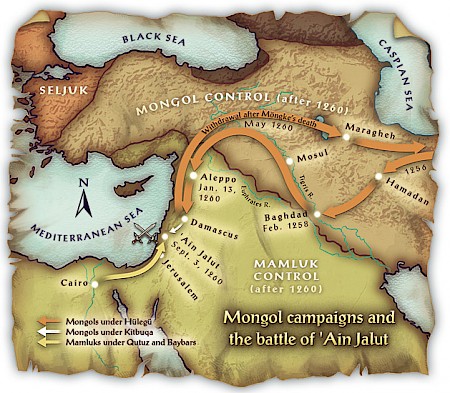 Among the Altaic groups, the Mongols 蒙古 assume a prominent historical role. Genghis Khan (1162–1227) founded the Mongol Empire in AvargaAvarga is located in Khentii Province, Mongolia. in 1206 and started the Mongol Invasions, which, at their peak in 1279, resulted in the conquest of most regions of Eurasia, Eastern Europe, and the Middle East. Yet, the Mongols endured a decisive defeat against the Muslim MamluksMamluks were slave-soldiers that Arab Fatimid Caliphs brought from Central Asian tribes to form their military elite corps, similar to the Légion étrangère (Foreign Legion). The Mamluks supplanted the Fatimids in 1174 and ruled over Egypt and the Middle East until the fifteenth century. in the Battle of Ain JalutAin Jalut, “Spring of Goliath,” is a place in the Jezreel valley of Southeastern Galilee. The European crusaders in Palestine allowed the Egyptian Mamluks to traverse it to fight the Mongols in 1260. See Cline (2002). of 1260.
Among the Altaic groups, the Mongols 蒙古 assume a prominent historical role. Genghis Khan (1162–1227) founded the Mongol Empire in AvargaAvarga is located in Khentii Province, Mongolia. in 1206 and started the Mongol Invasions, which, at their peak in 1279, resulted in the conquest of most regions of Eurasia, Eastern Europe, and the Middle East. Yet, the Mongols endured a decisive defeat against the Muslim MamluksMamluks were slave-soldiers that Arab Fatimid Caliphs brought from Central Asian tribes to form their military elite corps, similar to the Légion étrangère (Foreign Legion). The Mamluks supplanted the Fatimids in 1174 and ruled over Egypt and the Middle East until the fifteenth century. in the Battle of Ain JalutAin Jalut, “Spring of Goliath,” is a place in the Jezreel valley of Southeastern Galilee. The European crusaders in Palestine allowed the Egyptian Mamluks to traverse it to fight the Mongols in 1260. See Cline (2002). of 1260.
Shortly before this battle, European crusaders led by French King Louis IX (1214–1270) were likewise defeated by the Muslim Mamluks in the Battle of Al MansurahAl Mansurah is situated northeast of Cairo in the Nile delta and is the capital of the Dakahlia Governorate in modern-day Egypt. of 1250. Sharing a common enemy but different strategic goalsIn their military campaigns, the Mongols wanted control over all Eurasian people. The Europeans waged the crusades to allow pilgrims access to the Holy Land under Muslim control and to overcome the schism of 1054 between Catholic and Orthodox churches. The Orthodox churches were in Turkish-controlled territory., the Mongols and the Europeans considered forming an alliance against the Muslim forces.
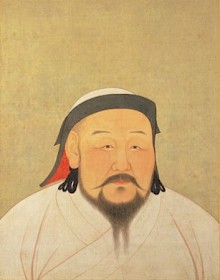 Kublai Khan EmperorKublai Khan Emperor 元世祖忽必烈 (1215–1294) was the first Emperor of the Yuán dynasty. He was the grandson of Genghis Khan. This picture was painted by Anige, a Nepali artist in Kublai’s court.Pope Innocent IV (1195-1254) initiated an overture toward the Mongols. In his letter Dei Patris ImmensaThe title Dei Patris Immensa translated from Latin into English: “The Boundlessness of God the Father.” written in 1245, he explained the Christian faith to Güyük KhanGüyük Khan (1206-1248) was the third Great Khan of the undivided Mongol Empire. He was the grandson of Genghis Khan. (1206-1248) and invited him to receive baptism. In his reply in 1246, Güyük Khan demanded submission of the Europeans.
Kublai Khan EmperorKublai Khan Emperor 元世祖忽必烈 (1215–1294) was the first Emperor of the Yuán dynasty. He was the grandson of Genghis Khan. This picture was painted by Anige, a Nepali artist in Kublai’s court.Pope Innocent IV (1195-1254) initiated an overture toward the Mongols. In his letter Dei Patris ImmensaThe title Dei Patris Immensa translated from Latin into English: “The Boundlessness of God the Father.” written in 1245, he explained the Christian faith to Güyük KhanGüyük Khan (1206-1248) was the third Great Khan of the undivided Mongol Empire. He was the grandson of Genghis Khan. (1206-1248) and invited him to receive baptism. In his reply in 1246, Güyük Khan demanded submission of the Europeans.
Contact continued even when the Mongolian empire separated into four khanatesA khanate is a Turkish and Mongol term to designate a polity or kingdom. A khanate is the polity ruled by a khan. in the 1260s. In particular, Kublai Khan (1215-1294) of the Yuán Khanate and Arghun Khan (1258-1291) of the Western Asian Ilkhanate corresponded with the Pope. They requested Catholic missionaries to visit the courts of the Mongol Khans. The communication most sympathetic to Christianity was a letter from Arghun Khan in which he discussed baptism. However, these written exchanges ceased after the death of Pope Nicholas IV (1227-1292) and of the two Khans.
 Letter of Arghun Khan to Pope Nicholas IV (1290)An approximate English translation from Mostaert and Cleaves’s (1952) French translation: “You have sent a message saying: ‘The other peoples of the universe, whoever they are, being people who pray according to their own religion and scriptures (Buddhists, Muslims, etc.), are praying falsely. The religion of Misiqa (Messiah, the Christ) adores Heaven and is true.’ May the Ilkhan now adopt the religion of Misiqa? Saying that our good father—because the religion of Misiqa is the right one—as well as our good grandmother had also received silam (“baptism,” a Syrian loanword), you have also again and again made communications, sent ambassadors and bearers of urgent oral messages who said ‘May nothing bad be committed against the Christians!’ Your saying ‘May the Ilkhan receive silam’ is legitimate. We say: ‘We the descendants of Genghis Khan, keeping our own proper Mongol identity, whether some receive silam or some don’t, that is only for Eternal Tengri (Heaven) to decide. People who have received silam and who, like you, have a truly honest heart and are pure, do not act against the religion and orders of the Eternal Tengri and of Misiqa. Regarding the other peoples, those who, forgetting the Eternal Tengri and disobeying it, are lying and stealing, are there not many of them? Now, you say that we have not received silam, you are offended and harbor thoughts of discontent. But if one prays to Eternal Tengri and carries righteous thoughts, it is as much as if he had received silam. We have written our letter in the year of the tiger, the fifth of the new moon of the first summer month (May 14th, 1290), when we were in Urumi.” The red seal inscription was 辅国安民之宝 (“Seal of the State patron and the source of peace for the People”).Pope Nicholas IV sent John of Montecorvino (1247–1328) as his special envoy to Arghun Khan and Kublai Khan. As a member of the Franciscan order, John was the forerunner of missionaries of the Middle Ages. He settled in Bĕijīng in 1294 shortly after the death of Kublai Khan. He built a church, established three mission stations, and learned Old Uyghur, the language spoken by the Mongol ruling elite. In 1307, he translated the New Testament and the Psalms into Old Uyghur. Although his Bible manuscripts did not endure, John’s accomplishments were reported in his two lettersThe letters are held at the Laurentian Library in Florence and at the National Library in Paris. Both letters are included and translated in Yule’s book of 1914, pp. 45-58. to the Pope. He died in Bĕijīng in 1328, and his mission in China continued for 40 years before the new Míng 明 rulers expelled foreign missionaries from China in the 1360s.
Letter of Arghun Khan to Pope Nicholas IV (1290)An approximate English translation from Mostaert and Cleaves’s (1952) French translation: “You have sent a message saying: ‘The other peoples of the universe, whoever they are, being people who pray according to their own religion and scriptures (Buddhists, Muslims, etc.), are praying falsely. The religion of Misiqa (Messiah, the Christ) adores Heaven and is true.’ May the Ilkhan now adopt the religion of Misiqa? Saying that our good father—because the religion of Misiqa is the right one—as well as our good grandmother had also received silam (“baptism,” a Syrian loanword), you have also again and again made communications, sent ambassadors and bearers of urgent oral messages who said ‘May nothing bad be committed against the Christians!’ Your saying ‘May the Ilkhan receive silam’ is legitimate. We say: ‘We the descendants of Genghis Khan, keeping our own proper Mongol identity, whether some receive silam or some don’t, that is only for Eternal Tengri (Heaven) to decide. People who have received silam and who, like you, have a truly honest heart and are pure, do not act against the religion and orders of the Eternal Tengri and of Misiqa. Regarding the other peoples, those who, forgetting the Eternal Tengri and disobeying it, are lying and stealing, are there not many of them? Now, you say that we have not received silam, you are offended and harbor thoughts of discontent. But if one prays to Eternal Tengri and carries righteous thoughts, it is as much as if he had received silam. We have written our letter in the year of the tiger, the fifth of the new moon of the first summer month (May 14th, 1290), when we were in Urumi.” The red seal inscription was 辅国安民之宝 (“Seal of the State patron and the source of peace for the People”).Pope Nicholas IV sent John of Montecorvino (1247–1328) as his special envoy to Arghun Khan and Kublai Khan. As a member of the Franciscan order, John was the forerunner of missionaries of the Middle Ages. He settled in Bĕijīng in 1294 shortly after the death of Kublai Khan. He built a church, established three mission stations, and learned Old Uyghur, the language spoken by the Mongol ruling elite. In 1307, he translated the New Testament and the Psalms into Old Uyghur. Although his Bible manuscripts did not endure, John’s accomplishments were reported in his two lettersThe letters are held at the Laurentian Library in Florence and at the National Library in Paris. Both letters are included and translated in Yule’s book of 1914, pp. 45-58. to the Pope. He died in Bĕijīng in 1328, and his mission in China continued for 40 years before the new Míng 明 rulers expelled foreign missionaries from China in the 1360s.
The Mongol armies moved back and forth along the Silk Road, a ten-thousand kilometer route on which traders, soldiers, nomads, pilgrims, and monks exchanged goodsThe Silk Road derived its name from the lucrative silk trade initiated during the Hàn dynasty 汉朝 (B.C. 207–A.D. 220). However, silk textiles were not the only goods that were traded., diseasesThe Black Death, a pandemic that killed an estimated 100 to 200 million people in the years 1346–1353, is believed to have originated from Central Asia where it traveled along the Silk Road and reached Europe. In 2010, scientists analyzed the DNA of victims and suggested this scenario. See Bos K.I. et al. (2011), “A draft genome of Yersinia pestis from victims of the Black Death” in Nature 478 (7370): pp. 506–10., technologiesMetallurgical, agricultural, and medical technologies were exchanged on the Silk Road beginning with the Hàn dynasty 汉朝., philosophiesManichaeism, for example, was a religious philosophy that expanded along the Silk Road. and religionsJewish, Christian, and Islamic religions came to China on the Silk Road during the Táng dynasty 唐朝 (618–907). Even before, Buddhism had traveled on the Silk Road in the reverse direction reaching the Greco-Roman world in ancient times.. The Silk Road was a crossroad of cultures. The ancient travelers included Chinese, Indians, Persians, Syrians, Greeks, Romans, and Sogdians.
 Eastern End of Silk RoadTwo major stops on the Silk Road were Samarkand in Uzbekistan and Turfan 吐鲁番 in the Chinese Xīnjiāng 新疆 Province. Samarkand was the multi-religious center of the Sogdian peopleThe Sogdian language is an Eastern Iranian language of the Indo-European family that was spoken in Samarkand and Bukhara, Uzbekistan, during BC 100–AD 1000. Sogdian is different from Persian, a Western Iranian language. The modern Yaghnobi language, spoken by approximately 12,000 people in Tajikistan, is the direct descendant of Sogdian.. Sogdian was the lingua franca used on the Silk Road during the Táng dynasty 唐朝 (618–907) from which other languages had borrowed vocabulary. The Chinese noun diàn 店 “hotel”, for example, is borrowed from the Sogdian noun tym “hotel.” The descendants of the Sogdians were supplanted by Uzbek and Tajik tribes in the sixteenth century. Before the ninth century, Turfan was under Tibetan control. With the defeat of the Uyghur armies by Kirghiz forces in 840, there was a massive influx of Uyghur people into Central Asia. Uyghur people took control of Turfan and relocated there. They established a kingdom with the capital in Qocho or Gāochāng 高昌, 30 kilometers away from Turfan. This kingdom existed between 856 and 1389, but it became a vassal state of Mongol rulers after 1250, before being integrated into the Moghul khanateThe Moghul Khanate was a kingdom that broke away from the Chagatai Khanate in 1347. Chagatai (1183–1242) was the second son of Genghis Khan. His khanate was one of four khanates that were under the unified rule of his father., a Mongolian Islamic kingdom. Originally, the Uyghur people believed in ManichaeismManichaeism was founded by the Persian Mani (AD 216–276). Manichaeism teaches a dualistic cosmology: an ongoing struggle between a good, spiritual world of light and an evil, material world of darkness. Manichaeism spread to the Middle East, Europe, and Central Asia and rivaled with Christian orthodoxy, which viewed it as a gnostic movement. but later converted to Buddhism. In the fifteenth century, the Mongol rulers began their forced conversion of the Uyghurs to Islam, which was completed in 1500.
Eastern End of Silk RoadTwo major stops on the Silk Road were Samarkand in Uzbekistan and Turfan 吐鲁番 in the Chinese Xīnjiāng 新疆 Province. Samarkand was the multi-religious center of the Sogdian peopleThe Sogdian language is an Eastern Iranian language of the Indo-European family that was spoken in Samarkand and Bukhara, Uzbekistan, during BC 100–AD 1000. Sogdian is different from Persian, a Western Iranian language. The modern Yaghnobi language, spoken by approximately 12,000 people in Tajikistan, is the direct descendant of Sogdian.. Sogdian was the lingua franca used on the Silk Road during the Táng dynasty 唐朝 (618–907) from which other languages had borrowed vocabulary. The Chinese noun diàn 店 “hotel”, for example, is borrowed from the Sogdian noun tym “hotel.” The descendants of the Sogdians were supplanted by Uzbek and Tajik tribes in the sixteenth century. Before the ninth century, Turfan was under Tibetan control. With the defeat of the Uyghur armies by Kirghiz forces in 840, there was a massive influx of Uyghur people into Central Asia. Uyghur people took control of Turfan and relocated there. They established a kingdom with the capital in Qocho or Gāochāng 高昌, 30 kilometers away from Turfan. This kingdom existed between 856 and 1389, but it became a vassal state of Mongol rulers after 1250, before being integrated into the Moghul khanateThe Moghul Khanate was a kingdom that broke away from the Chagatai Khanate in 1347. Chagatai (1183–1242) was the second son of Genghis Khan. His khanate was one of four khanates that were under the unified rule of his father., a Mongolian Islamic kingdom. Originally, the Uyghur people believed in ManichaeismManichaeism was founded by the Persian Mani (AD 216–276). Manichaeism teaches a dualistic cosmology: an ongoing struggle between a good, spiritual world of light and an evil, material world of darkness. Manichaeism spread to the Middle East, Europe, and Central Asia and rivaled with Christian orthodoxy, which viewed it as a gnostic movement. but later converted to Buddhism. In the fifteenth century, the Mongol rulers began their forced conversion of the Uyghurs to Islam, which was completed in 1500.
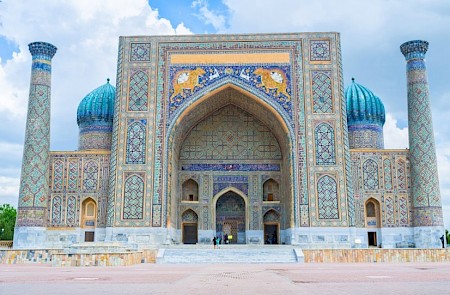 Sher-Dor MadrasahA Madrasah is a lecture hall and place of learning. in Samarkand
Sher-Dor MadrasahA Madrasah is a lecture hall and place of learning. in Samarkand
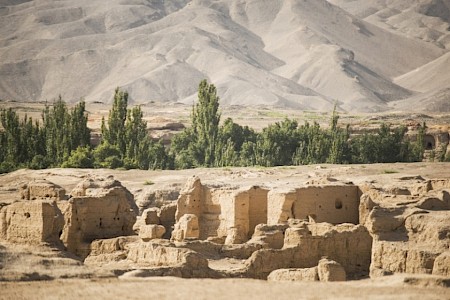 Jiāohé 交河 Ruins in Turfan
Jiāohé 交河 Ruins in Turfan
The Sogdian people adopted the Old Syriac alphabet, which was derived from the Aramaic alphabet. The Sogdian script was used for secular and religious texts. During the ninth century, the Uyghur created a script, which was adopted from the Sogdian alphabet. Influenced by the prestigious Chinese script, the Uyghur changed the direction of the script from horizontal (right-to-left like the Sogdians) to vertical (top-to-bottom like the Chinese). The Uyghur script was used by the Uyghur and Yugur people in Gānsù 甘肃 Province of China until the nineteenth century, when they changed to the Arabic-Persian script and Cyrillic script. Their original writing system fell out of use.
In the thirteenth century, the illiterate Mongol rulers decided to create their own script based on the Old Uyghur script. The Mongolian script in turn formed the basis of writing systems in the Tungusic languages of Manchu, Xibe, and Evenki. Today, the Mongolian script is still in use in China and Mongolia. The following three charts illustrate the alphabetic make-up of a written word and show the consonantal and vocalic graphemes of the Mongolian script.
The first complete Bible was published using the traditional script in Khalka Mongolian, the official language of Mongolia, in 2004, centuries after the Mongolian conquests. However, for Chahar-Mongolian, spoken in the V. R. of China, an independent translation was necessary.
There are three translations of the New Testament in Chahar-Mongolian that were produced in the twenty-first century. The first version, called Ariun Nom, was completed in 2004 by a team coordinated by Stefan Müller of Zentralasien-Gesellschaft. It is the version with the widest circulation in the churches of Inner Mongolia. The second is a dynamic equivalence translation completed by members of the Summer Institute of Linguistics (SIL) and was published in 2007 with the title Shine Geree. The third translation was completed by Bao Xiaolin, a pastor of the Three-Self Church, in cooperation with the United Bible Societies; the manuscript was published by Amity Press in 2013.
The Manchu 满族 peopleThere have been different opinions on the etymology of the self-named Manchu. According to the Qīng dynasty's official historical record, Manchu is derived from the Buddhist term Manjusri, a bodhisattva associated with transcendent wisdom. Other scholars associate Manchu to Lĭ Mănzhù 李满住, the name of a Jurchen chieftain. However, others opined that Manchu is derived from the compound word mangga-ju “strong-arrow,” which means “intrepid arrow.” The term Mandarin adopted in European languages is derived from Măn Dà Rén 满大人, which means “High Manchu Official.” are descended from the Jurchen 女真 peopleThe Sùshèn 肃慎 tribe emerged as early as the sixth century B.C. in Chinese documents. The Sùshèn are believed to be the ancestors of the Mòhé 靺鞨 people, who are mentioned in documents of the Hàn 汉 dynasty (BC 206–AD 220). The Mòhé people are the direct ancestors of the Jurchen 女真 people., a Tungus group who inhabited the area of present-day Liáoníng 辽宁 Province. During the second half of the Sòng dynasty 宋朝 (960–1290), the Jurchen people rebelled against the ruling Sòng and established the Jīn dynasty 金朝 (1115-1234)The Jīn dynasty 金朝 (1115–1234) established by the Jurchen people must not be confused with the Jìn dynasty 晋朝 (265–420). in Northern China.
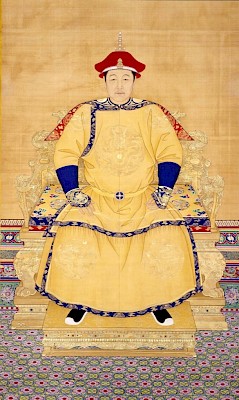 Shùnzhì Emperor 順治皇帝He was the first Qīng Emperor to rule over China. His reign was during 1643-1661. This picture is held at the Palace Museum, Beijing 故宫博物院.The Jurchen or Jīn people were later subjugated by the Mongols. In the late Míng dynasty 明朝 (1368–1644), Jurchen chieftain Nurhaci 努尔哈赤 (1559–1626) unified the Jurchen tribes through three measures: he commissioned a script based on the Mongolian script, established a military and societal system called the Eight BannersThe Eight Banners symbolized eight Manchu elite armies in addition to the ordinary standing green army. The banners incorporated Manchu ethnic identity and each bannerman’s membership was hereditary. The eight banners were: (1) Plain Yellow Banner 正黄旗, (2) Bordered Yellow Banner 镶黄旗, (3) Plain White Banner 正白旗, (4) Bordered White Banner 镶白旗, (5) Plain Red Banner 正红旗, (6) Bordered Red Banner 镶红旗, (7) Plain Blue Banner 正蓝旗, and (8) Bordered Blue Banner 镶蓝旗., and started a military campaign against the ruling Míng. Nurhaci’s son, Hóng Tàijí 洪太極 (1592–1643), adopted the name Qīng 清Pamela Crossley (1997) proposed that the name Qīng 清 (“clear” or “pure”) might be a response to the name of the Míng 明 dynasty, which means “bright” or “clear.” The character 明 is composed of 日 “day” and 月 “moon” and thus associated with the idea of “fire,” while 清 contains the water radical 氵; this association would refer to the Qīng’s conquest of Míng as the elemental defeat of fire by water. and declared himself the emperor of Qīng. Control over all of China was won by Nurhaci’s grandson Shùnzhì 順治 in 1644 through continuous military campaigns.
Shùnzhì Emperor 順治皇帝He was the first Qīng Emperor to rule over China. His reign was during 1643-1661. This picture is held at the Palace Museum, Beijing 故宫博物院.The Jurchen or Jīn people were later subjugated by the Mongols. In the late Míng dynasty 明朝 (1368–1644), Jurchen chieftain Nurhaci 努尔哈赤 (1559–1626) unified the Jurchen tribes through three measures: he commissioned a script based on the Mongolian script, established a military and societal system called the Eight BannersThe Eight Banners symbolized eight Manchu elite armies in addition to the ordinary standing green army. The banners incorporated Manchu ethnic identity and each bannerman’s membership was hereditary. The eight banners were: (1) Plain Yellow Banner 正黄旗, (2) Bordered Yellow Banner 镶黄旗, (3) Plain White Banner 正白旗, (4) Bordered White Banner 镶白旗, (5) Plain Red Banner 正红旗, (6) Bordered Red Banner 镶红旗, (7) Plain Blue Banner 正蓝旗, and (8) Bordered Blue Banner 镶蓝旗., and started a military campaign against the ruling Míng. Nurhaci’s son, Hóng Tàijí 洪太極 (1592–1643), adopted the name Qīng 清Pamela Crossley (1997) proposed that the name Qīng 清 (“clear” or “pure”) might be a response to the name of the Míng 明 dynasty, which means “bright” or “clear.” The character 明 is composed of 日 “day” and 月 “moon” and thus associated with the idea of “fire,” while 清 contains the water radical 氵; this association would refer to the Qīng’s conquest of Míng as the elemental defeat of fire by water. and declared himself the emperor of Qīng. Control over all of China was won by Nurhaci’s grandson Shùnzhì 順治 in 1644 through continuous military campaigns.
Manchu was destined to become the official language of the Chinese empire in 1644, but it lacked the administrative, scientific, and even practical vocabulary found in Chinese; Chinese inevitably influenced the Manchu language. Despite efforts made by the Emperor Kāngxī 康熙皇帝 (1654–1722) and Emperor Qiánlóng 乾隆皇帝 (1711–1796) to maintain the Manchu language, it steadily declined.
In 1859, the Imperial Government allowed Hàn Chinese immigrationSee Gorelova, Liliya M. (2002). Manchu Grammar. Leiden: Brill. into Manchuria, which contributed to the final decline of the Manchu language. By the end of the Qīng government in 1912, the Manchu language disappeared completely from public life. However, the discovery of several Manchu-speaking villages in Liáoníng Province in the 1960s revived interest, and the Chinese Government began a revitalization program; however, there are probably only approximately 20 active speakers of Manchu today. The Manchu script, consonant and vowels, is introduced in the following three charts.
Stepan Vaciliyevich Lipoftsoff (1773–1841), an official of the Russian Foreign Office who studied Manchu for 20 years in China, translated the Gospel of Matthew (1822) and the New Testament (1835) into Manchu before 1859, when Manchu began its final decline.
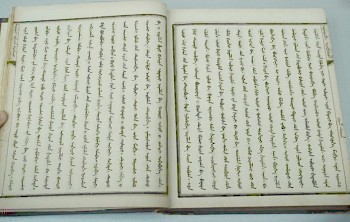 Lipoftsoff’s New Testament TranslationA copy of the New Testament is held at the library of the University of Western Sydney. George Borrow was appointed by the British and Foreign Bible Society (BFBS) to help finalize the manuscript. In Beijing, George Borrow obtained an unpublished manuscript of the Manchu Old Testament that the Jesuit missionary Louis Antoine de Poirot had completed in 1790. This manuscript enabled Borrow to learn the Manchu language in six months and to proofread Lipoftsoff’s New Testament. The BFBS published the New Testament manuscript in St. Petersburg in 1835 using Manchu characters, and it has been reprinted often since then.
Lipoftsoff’s New Testament TranslationA copy of the New Testament is held at the library of the University of Western Sydney. George Borrow was appointed by the British and Foreign Bible Society (BFBS) to help finalize the manuscript. In Beijing, George Borrow obtained an unpublished manuscript of the Manchu Old Testament that the Jesuit missionary Louis Antoine de Poirot had completed in 1790. This manuscript enabled Borrow to learn the Manchu language in six months and to proofread Lipoftsoff’s New Testament. The BFBS published the New Testament manuscript in St. Petersburg in 1835 using Manchu characters, and it has been reprinted often since then.
The Evenki language, a Tungus language, is spoken by 20,000 people in China and 6,000 people in Russia. Nadezhda Bulatova and David Kheĭzell of the Institute for Bible Translation (IBT) in Moscow translated the Gospel of Luke into the Tura dialect of Evenki in 2002. The manuscript was published by IBT in Moscow in 2002 and republished as Evenki/Russian diglot with audio recording in 2013, making it usable for the Evenki in Inner Mongolia and Hēilóngjiāng, China.
More than 10 million, predominantly Muslim, Uyghur 维吾尔 people live in Xīnjiāng 新疆 Province of China, Kazakhstan, Kyrgyzstan, and Uzbekistan today. About 50 manuscripts written in Old Uyghur were found in Turfan, a stop on the Silk Road, and some of these manuscripts are Christian texts, which have been digitalized at the Brandenburg Academy of Social Sciences and Humanities in Germany. As mentioned previously, Catholic missionary John of Montecorvino (1247–1328) translated the New Testament and the Psalms into Old Uyghur before 1307, as Old Uyghur was the lingua franca used by the Mongol rulers in Bĕijīng. Although no Bible manuscript survived, information on the existence of the translated New Testament is contained in a letter by John to the Pope.
 Johannes AvetaranianJohannes Avetaranian (1861–1919) was a Turk from Erzurum in Turkey. His original Islamic name was Mehmet Şükri. His father was a dervish, an ascetic of Sufism (Sufism is a mystical movement within Islam.) Johannes Avetaranian adopted an Armenian Christian name (“Son of the Gospel”) after studying the New Testament and converting to the Christian faith. He was based in Kāshghar during 1892–1897. After 1897, he was appointed by the German Orient Mission as a missionary to Bulgaria. He died in Wiesbaden, Germany in 1919.Modern Uyghur is not the direct descendant of Old Uyghur. Old Uyghur developed into the Western Yugur 西裕固The Western Yugur language is a Turkic language, whereas the Eastern Yugur language, also spoken in Gānsù Province, is a Mongolian language. language, which is spoken today by about 5,000 speakers in the Sùnán 肃南 County of Gānsù 甘肃 Province. Instead, Modern Uyghur is the name of the literary Chagatai language as it is spoken in Kāshghar 喀什 in Xīnjiāng 新疆 Province. Modern Uyghur was standardized in the 1930s, and it is in this language that the New Testament was translated.
Johannes AvetaranianJohannes Avetaranian (1861–1919) was a Turk from Erzurum in Turkey. His original Islamic name was Mehmet Şükri. His father was a dervish, an ascetic of Sufism (Sufism is a mystical movement within Islam.) Johannes Avetaranian adopted an Armenian Christian name (“Son of the Gospel”) after studying the New Testament and converting to the Christian faith. He was based in Kāshghar during 1892–1897. After 1897, he was appointed by the German Orient Mission as a missionary to Bulgaria. He died in Wiesbaden, Germany in 1919.Modern Uyghur is not the direct descendant of Old Uyghur. Old Uyghur developed into the Western Yugur 西裕固The Western Yugur language is a Turkic language, whereas the Eastern Yugur language, also spoken in Gānsù Province, is a Mongolian language. language, which is spoken today by about 5,000 speakers in the Sùnán 肃南 County of Gānsù 甘肃 Province. Instead, Modern Uyghur is the name of the literary Chagatai language as it is spoken in Kāshghar 喀什 in Xīnjiāng 新疆 Province. Modern Uyghur was standardized in the 1930s, and it is in this language that the New Testament was translated.
The first missionary to the Uyghur people in the modern era was Johannes AvetaranianSee Avetaranian, Johannes (1930). Geschichte eines Mohammedaners der Christ wurde. An autobiography completed after his death by R. Schäfer. Potsdam: Missionshandlung und Verlag. (Translated into English by J. Bechard in 2003 with the title A Muslim Who Became a Christian. Hertford, England: Authors OnLine Ltd.), who was recruited by the Mission Union of SwedenThe Mission Covenant Church of Sweden (Svenska Missionskyrkan) was a church denomination that was founded in 1878 and merged in 2012 with the Baptist Union of Sweden and the Methodist Union of Sweden. The new name is Joint Future Church (Equmeniakyrkan). Before 2003, the Mission Covenant Church of Sweden was called Mission Union of Sweden. It was a free reformed church with roots in pietism.. On his first explorative trip with Swedish missionaries to Kāshghar in 1892, Avetaranian stayed behind. He quickly learned Modern Uyghur, which is related to his native language, Turkish. By 1897, he had translated the four Gospels. The Swedish missionaries Lars Erik HögbergLars Erik Högberg (1858–1924) was sent to Kāshghar by the Mission Union of Sweden. He was the undisputed leader of the Swedish Mission in Kāshghar until 1916. and Gösta RaquetteGösta Raquette (1871–1945) was stationed in Kāshghar between 1896–1901 and 1913–1921. He wrote Uyghur grammar, which was published in Berlin in 1912, and contributed to the revision of the New Testament. He accepted a lectureship at Lund University after his retirement from the field., who settled in Kāshghar after 1893, were critical of Avetaranian’s translation, and the differences of opinion resulted in strained relations. Without resolving the dispute, the BFBS published the four Gospels in 1898 using Arabic script.
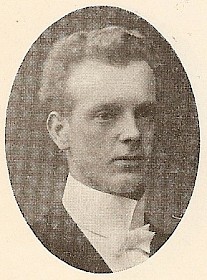 Gustaf AhlbertGustaf Ahlbert, 1884-1943.Avetaranian left Kāshghar in 1897 and did not return. The dispute smoldered on for 20 years. When he was stationed in Plovdiv, Bulgaria, Avetaranian completed the first draft of the Modern Uyghur New Testament. The BFBS initiated two mediation conferences—one in Berlin (1909) and one in London (1911)—and a compromise was reached. Avetaranian and Swedish missionary Gösta Raquette collaborated on the revision in Plovdiv. By 1914, 2,000 copies of the New Testament were printed in Plovdiv, but the distribution was delayed due to the outbreak of the First World War.
Gustaf AhlbertGustaf Ahlbert, 1884-1943.Avetaranian left Kāshghar in 1897 and did not return. The dispute smoldered on for 20 years. When he was stationed in Plovdiv, Bulgaria, Avetaranian completed the first draft of the Modern Uyghur New Testament. The BFBS initiated two mediation conferences—one in Berlin (1909) and one in London (1911)—and a compromise was reached. Avetaranian and Swedish missionary Gösta Raquette collaborated on the revision in Plovdiv. By 1914, 2,000 copies of the New Testament were printed in Plovdiv, but the distribution was delayed due to the outbreak of the First World War.
The Swedish mission thrived in KāshgharSee Hultvall, John (1981). Mission and Revolution in Central Asia: The MCCS Work in Eastern Turkestan 1892–1938. Studia Missionalia Upsaliensa 35. Translated by Birgitta Åhman. Stockholm: Gummessons. between 1901 and 1939 with 60 field missionaries. Different Swedish missionaries translated the books of Genesis (1917), Job (1921), and Psalms (1923). Gustaf Ahlbert, who settled in Kāshghar in 1912, coordinated the translation work after the closure of the Swedish mission in 1939. Together with Uyghur convert Nur Luke and Oskar Hermansson, he was exiled to Bombay in India, where he died in 1943. With the assistance of Moulvi Munshi and Moulvi Fazil, Oskar Hermansson completed the first Uyghur Bible in 1950. The BFBS published this translation in Cairo in 1950.
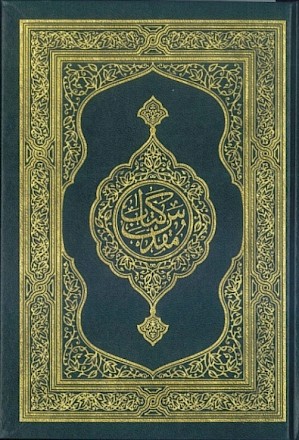 Uyghur Bible in Arabic script, 2005
Uyghur Bible in Arabic script, 2005 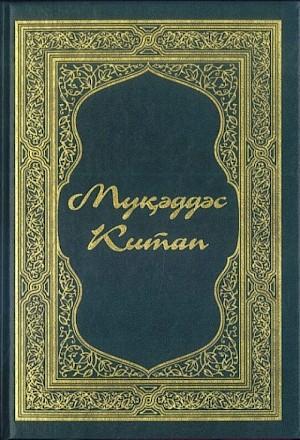 Uyghur Bible in Cyrillic script, 2005The “Dunyaning Nuri” (“Light of the World”) website includes the original Cairo Bible of 1950 and a revision of the Cairo Bible completed in 2013.
Uyghur Bible in Cyrillic script, 2005The “Dunyaning Nuri” (“Light of the World”) website includes the original Cairo Bible of 1950 and a revision of the Cairo Bible completed in 2013.
The Uyghur Bible Society was created in the early 2000s and is based in Turkey. It uploaded a retranslation of almost the entire Bible online in 2005.
Furthermore, two printed versions were published in Turkey in 2005: one in Arabic script for use in China and the other in Cyrillic script for use in Kazakhstan and other countries.
Miao-Yao Minorities (4)
The Miao-Yao languages 苗瑶语系 constitute a small family of about 80 languages.
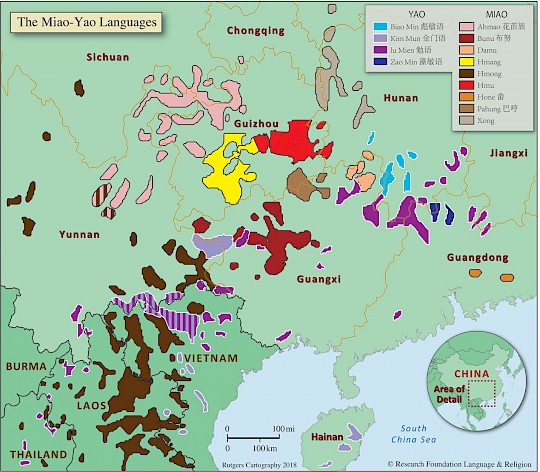 Miao 苗 is the name used by the Chinese during the Qin dynasty (221–206 B.C.) for non-Chinese groups living in the Yangtze valley south of the Hàn areas. Its etymology is uncertain. During the A.D. first millennium, Miao-Yao groups were forced by the expansive Hàn population to migrate southward to what is known today as the Hunan, Guìzhōu, Sìchuān, and Yúnnán provinces.
Miao 苗 is the name used by the Chinese during the Qin dynasty (221–206 B.C.) for non-Chinese groups living in the Yangtze valley south of the Hàn areas. Its etymology is uncertain. During the A.D. first millennium, Miao-Yao groups were forced by the expansive Hàn population to migrate southward to what is known today as the Hunan, Guìzhōu, Sìchuān, and Yúnnán provinces.
After the eighteenth century, some Miao groups emigrated from China to other Southeast Asian countries, such as Thailand, Laos, Vietnam, and Myanmar. In the aftermath of the Second Indochina War (1960–1975), about 100,000 ethnic Miao fled to the United States, France, and Australia because they were allied with the anti-communist forces, which lost the war.
Portions of the Bible were translated into four Miao languages spoken in Guìzhōu and Sìchuān provinces.
|
ISO639-3 |
Language |
Classification |
Population |
Book |
NT |
Bible |
|---|---|---|---|---|---|---|
|
hmd |
Ahmao 花苗语Ahmao or Flowery Miao is the language spoken in Shimenkan 石门坎 and Weining 威宁 in Western Guìzhōu. Samuel Pollard 柏格理 of the Bible Christian Mission (Methodist, UK) settled in Shíménkǎn 石门坎 in 1905 to evangelize the Ahmao people. Since the Yí landowners (and also Hàn settlers) in that area severely exploited the Ahmao people by means of excessive taxation, the Ahmao people listened to Pollard’s message and converted in large numbers to escape the despair that gripped their ethnic psyche. Many episodes in Pollard’s diary describe the rude treatment of the Ahmao people by Yí and Hàn landlords. Samuel Pollard created an alphabet, loosely based on the Latin alphabet, with special characters devised by him (“Pollard Script”). |
Miao-Yao, Miao, Western |
300,000 |
1907With his assistants Stephen Lee 李司提反 and James Yang 杨雅各, Pollard translated Mark into Ahmao by 1907. The manuscript was published by the BFBS and 5,000 copies were printed. | 1917Samuel Pollard of the Bible Christian Mission, again assisted by Stephen Lee and James Yang, completed a first draft of the New Testament in 1915, weeks before he died from typhoid fever in September 1915. William Hudspeth and Arthur Nicholls (both of the United Methodist Mission) reviewed the draft of the New Testament and completed it in 1917. The manuscript in the Pollard Script was published by the BFBS and 5,000 copies were printed in Yokohama, Japan in 1917. The manuscript was reprinted in 1919 and 1929, with a total circulation of 10,000 copies. This was followed by a revision of the New Testament by William Hudspeth and Arthur Nicholls, which was completed in 1936, and another 7,000 copies were printed. |
2009In the 1980s, leaders of the Ahmao churches in Yúnnán met and decided to work on a translation of the Old Testament. In January 1991, with the consent of the Yúnnán Chinese Christian Council and the Three-Self Patriotic Movement, the Ahmao Old Testament translation team was formed in Kunming. By 2001, the team had drafted the entire Old Testament, when a delegation of the United Bible Societies toured the minority areas in Yúnnán. Contacts were established and Yu Suee Yan of the United Bible Societies was appointed as consultant of the Ahmao Old Testament translation project. The team revised, reviewed, and partly retranslated the Old Testament until 2006, when an acceptable translation was completed. As Pollard’s original New Testament translation was outdated, the team retranslated the New Testament during 2006–2008. The first Ahmao Bible was published by the China Christian Council and printed by Amity Press in Nanjing in 2009. Ten thousand copies were dedicated on September 5, 2009 and distributed within days. Yu Suee Yan (2011). The story of the Big Flowery Miao Bible. Bible Translator 62(4), 207-215. United Bible Societies. (Accessed on 12-Feb-2019.) |
|
cqd |
Chuāndiān Hmong 川滇苗语Chuāndiān Hmong 川滇苗语 is spoken by scattered Miao groups in Sìchuān and Yúnnán provinces. |
Miao-Yao, Miao, Western |
1,400,000 |
1922The people mostly residing in Sìchuān province are called “River Miao”. Harry Parsons 张道惠 of the Bible Christian Mission (Methodist, UK) was stationed in Shíménkǎn 石门坎, Guìzhōu during 1906–1911, 1917–1920 and 1922–1926. During his second stay in Shíménkǎn 石门坎, Parsons worked on the Sìchuān Hmong language, which is spoken on the opposite side in Gǒng 珙 and Xùyǒng 叙永 counties of Sìchuān Province. Parsons translated the Gospel of Mark into Sìchuān Hmong in 1922 using the Pollard Script. (Pollard was Parsons’ mission colleague.) The manuscript was published by the BFBS in Kunming. The Gospel of Mark was revised by Hmong speaker Yang Kuanyi and jointly published by the BFBS and American Bible Society in Shanghai in 1938. | 2017Robert and Carey McLaughlin (麦瑞祥 and 裴明明) of Wycliffe USA arrived in Yúnnán in the early 2000s to work with the Hmong Soud/Nzhuab people in the Hónghé and Wénshān prefectures. The Hmong Soud/Nzhuab dialect and Sìchuān Hmong dialect are two different varieties of (Chuānqiándiān) Hmong. The McLaughins worked on a grammar and adopted the Romanized orthography created by the Chinese government in the 1950s for use in Hmong Soud/Nzhuab. A team of Hmong translators completed the New Testament in 2017. |
|
|
hmj |
Gejia 革家语The Ge 革 people, classified as ethnic Miao under the name of Chong'anjiang Miao 重安江苗 in Huángpíng County, Guìzhōu, do not accept being classified as Miao. Missionaries in the 1930s used the spelling Keh Deo derived from the older name Gedou Miao 革兜苗 for this group. |
Miao-Yao, Miao, Central |
60,000 |
1937After China Inland Mission missionary Maurrice Hutton 胡致中 (Australia) completed the New Testament in Hmu, he worked on the Ge language. In 1933, he adapted the National Phonetic Script (Bomofo) to Ge according to the same rules he had used for Hmu. Assisted by Liao De’en 廖德恩 and Liao Ruyin 廖如银, Hutton completed the Gospels of Mark and John by 1937. The National Bible Society of Scotland printed the manuscript in Shanghai in 1937. |
|
|
|
hea |
Hmu 黑苗语Hmu is the autonym of these people; their Hàn Chinese exonym is Black Miao 黑苗. |
Miao-Yao, Miao, Central |
1,250,000 |
1928China Inland Mission missionary Maurrice Hutton 胡致中 (Australia) settled in Pánghăi 旁海 in 1912 to work with the Hmu people. He adapted the National Phonetic Script (Bomofo) as an orthography for Hmu. Together with his main assistant Wáng Xuéguāng 王学光, Hutton translated the Gospels of Matthew and Mark into Hmu in 1928. The manuscript was published by the BFBS in Zhīfú 芝罘, Shandong, China in 1928. | 1934Hutton, assisted by Wáng Xuéguāng 王学光 and other Hmu people, also completed the New Testament in 1934, and it was published by the BFBS in Zhīfú 芝罘, Shandong, China in 1934. In the 1950s, the number of believers declined. Most copies of the New Testament were burned during the Cultural Revolution (1966–1976). The New Testament was retranslated in 2009 by members of Research Foundation Language and Religion (RFLR) using the Romanized script of the Chinese Government. A revision of this New Testament appeared in 2018. Both editions were published by Verlag für Theologie und Religionswissenschaft in Nürnberg, Germany and printed in Hong Kong, with 7,000 copies and 3,000 copies for the 2009 and 2018 editions, respectively. |
|
Table 7: Bible Translation in Miao Languages of China
The service of English Methodist missionary Samuel Pollard 柏格理See Grist, William A. (1920). Samuel Pollard: Pioneer Missionary in China. London: Cassell. (1864–1915) to the Ahmao people was successful and had long-lasting results. The Ahmao people listened to Pollard’s message and converted in large numbers to escape the despair that gripped their ethnic psycheSee Pollard, Walter (1928). The Life of Sam Pollard of China. London: Seeley; and Pollard, Samuel (1954). Eyes of the Earth: The Diary of Samuel Pollard. London: Cargate Press.. For a long period, they had endured the rude treatment by Yí and Hàn landlords. Samuel Pollard created an alphabet, loosely based on the Latin alphabet, with special characters devised by him (called “Pollard Script”). Soon after he had completed the New Testament in Ahmao, Pollard died from typhoid in 1915. Hudspeth, his missionary successor, revised the manuscript and took it to Japan in 1917 to print 5,000 copies. Hudspeth retranslated the New Testament in the 1930s and published it in Shanghai in 1936. In 1936, Hudspeth wrote that there were 40 organized Ahmao churches with a total of 18,300 members. After 1949, these churches were reorganized as Three-Self Churches. The entire Bible was completed in 2009 by a Three-Self-Church Committee and printed by Amity Press in Nánjīng, China.
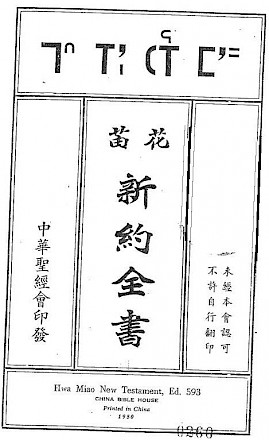 Ahmao New TestamentPrinted in 1934 and reprinted in 1950.
Ahmao New TestamentPrinted in 1934 and reprinted in 1950.
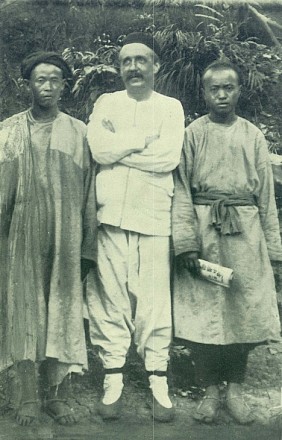 Pollard with Ahmao teachers
Pollard with Ahmao teachers
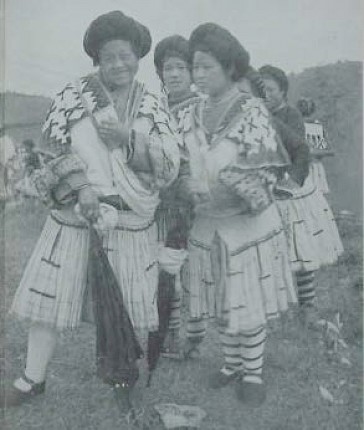 Christian Ahmao women in 1906
Christian Ahmao women in 1906
English Methodist Missionary Harry Parsons 张道惠 (1878–1952) translated the Gospel of Mark into Sìchuān Hmong in 1922, using the Pollard Script. He was based in Dōngchuān 东川, a district in Yúnnán Province close to Sìchuān Province, for most of the time. Parsons was a colleague of Pollard assisting him at different times with the Ahmao work in Guìzhōu.
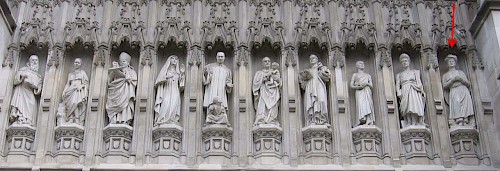 Wáng Zhìmíng 王志明 at the Westminster AbbeyStatues of twentieth-century martyrs are displayed on the façade above the Great West Door of Westminster Abbey, London. Those commemorated from left to right are Maximilian Kolbe, Manche Masemola, Janani Luwum, Mother Teresa, Martin Luther King, Óscar Romero, Dietrich Bonhoeffer, Esther John, Lucian Tapiedi, and Wáng Zhìmíng 王志明. in LondonThe Sìchuān Hmong are closely related to the Hmong in Wǔdìng 武定 county, Yúnnán, who converted in great numbers during the ministry of Parsons and of China Inland Missionary Gladstone Porteous. Wáng Zhìmíng 王志明 (1907–1973), a native Hmong of Wǔdìng, was ordained as a pastor in 1951 following the departure of the foreign missionaries. After Wáng’s refusal to participate in the denunciation of other Christians, he was arrested in 1969 and executed four years later in a stadium in front of 10,000 people. Many of those present were Christians who were indignant. Shortly after the Cultural Revolution (1966–1976), Wáng was rehabilitated, and the church in Wǔdìng grew more than tenfold in the following years. Wáng is remembered at the Westminster Abbey in London as one of 10 twentieth-century martyrs.
Wáng Zhìmíng 王志明 at the Westminster AbbeyStatues of twentieth-century martyrs are displayed on the façade above the Great West Door of Westminster Abbey, London. Those commemorated from left to right are Maximilian Kolbe, Manche Masemola, Janani Luwum, Mother Teresa, Martin Luther King, Óscar Romero, Dietrich Bonhoeffer, Esther John, Lucian Tapiedi, and Wáng Zhìmíng 王志明. in LondonThe Sìchuān Hmong are closely related to the Hmong in Wǔdìng 武定 county, Yúnnán, who converted in great numbers during the ministry of Parsons and of China Inland Missionary Gladstone Porteous. Wáng Zhìmíng 王志明 (1907–1973), a native Hmong of Wǔdìng, was ordained as a pastor in 1951 following the departure of the foreign missionaries. After Wáng’s refusal to participate in the denunciation of other Christians, he was arrested in 1969 and executed four years later in a stadium in front of 10,000 people. Many of those present were Christians who were indignant. Shortly after the Cultural Revolution (1966–1976), Wáng was rehabilitated, and the church in Wǔdìng grew more than tenfold in the following years. Wáng is remembered at the Westminster Abbey in London as one of 10 twentieth-century martyrs.
Australian China Inland Missionary Maurice Hutton 胡致中 (1888–?) introduced the Phonetic Alphabet 注音字母 in the 1920s and completed the New Testament (1934) in the Hmu language as well as the Gospels of Mark and John (1937) in the Gejia language, another Miao language spoken in Guìzhōu Province. More details on Hutton’s work as well as on the New Testament completed in 2009 are provided on the Hmu 苗 page of this website.
Tai-Kadai Minorities (6)
The Tai-Kadai family consists of more than 96 languages spoken by 100 million people in China, Thailand, Myanmar, and Laos. Tai-Kadai people are believed to originate from some of the ancient Bǎiyuè 百越 peopleFrom the Zhōu dynasty 周朝 (BC 1046–256), the term Bǎiyuè, or Hundred Yuè, referred to southern barbarians in a vast territory from Zhèjiāng to Yúnnán Provinces. In the linguistic classification system, the Yuè languages are now designated as the group of Chinese dialects in which Cantonese belongs., who lived more than 2,500 years ago. In manuscripts of the Hàn dynasty 汉朝 (BC 206––AD 220), the Zhuàng 壮, the Bùyī 布依The Bùyī were also called Zhòngjiā, written as 仲家 or as 狆家. and the Hlai 黎 people were variously referred to as Luòyuè 雒越; the Tai people were called Diānyuè 滇越.
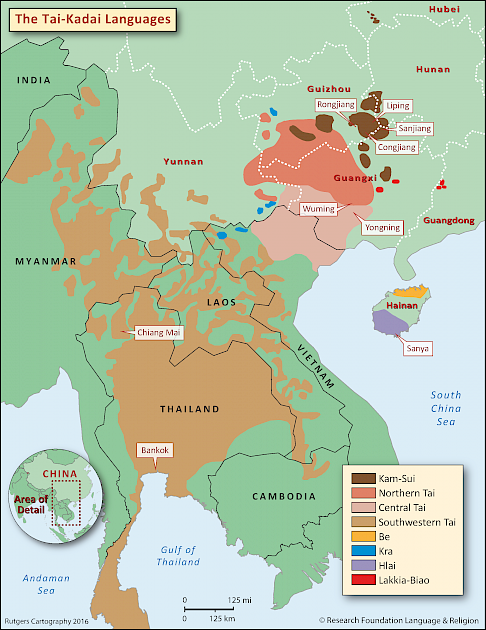 Scholars agree that the Tai people outside of China originated from Guìzhōu, Guǎngxī, and Guǎngdōng provinces within China. Different theories exist about the exact time when the Tai people migrated to Yúnnán, Thailand, Myanmar, and Laos.
Scholars agree that the Tai people outside of China originated from Guìzhōu, Guǎngxī, and Guǎngdōng provinces within China. Different theories exist about the exact time when the Tai people migrated to Yúnnán, Thailand, Myanmar, and Laos.
Historian Henry DaviesSee Davies, Henry R. (1909). Yúnnán, the Link between India and the Yangtze. Cambridge: Cambridge University Press. proposed in 1909 that after the defeat of the Dàlĭ Kingdom 大理国Duàn Sīpíng 段思平 established the Dàlĭ Kingdom in 937. This kingdom was ruled by a dynasty of 22 kings before being subjugated by Mongolian armies in 1253. by the Mongols in 1253, there was a massive migration of Tai people into Southeast Asia; this theory is based on the idea that the Dàlĭ Kingdom and the earlier Nánzhào Kingdom 南诏国In AD 738, Pí Luógé 皮罗阁 unified six ethnic tribes into a new kingdom called Nánzhào 南诏. With the support of Chinese emperor Táng Xuánzōng 唐玄宗 (712–756), Pí Luógé established the capital in Tàihé 太和. Today, Tàihé is a village of Dàlĭ City in Yúnnán Province. Successors of Pí Luógé turned against the Chinese and won two battles with armies of the Táng dynasty. By 829, the Nánzhào Kingdom expanded into Sìchuān, all of Yúnnán, Thailand, and Laos. Yet, after reaching its peak in 850, the Nánzhào Kingdom went into steady decline. See Blackmore (1960). were established by Tai people.
In 1923, missionary-scholar William Clifton DoddSee Dodd (1923). The Tai Race: Elder Brother of the Chinese. Cedar Rapids, Iowa: Torch. forwarded a slightly refined hypothesis, which claimed that the Mongolian conquest of 1253 was the last and not the first in a series of drivers for Tai migration into Southeast Asia.
The connection of the Tai people with the Nánzhào Kingdom was disproved by several scholarsSee Backus (1981), Mote (1964), Terwiel (1978), Du and Chen (1989), and Winai (1990). who argued that in both kingdoms, the ordinary people were BáiLinguists classified the Bái 白 language either as a Chinese language that was influenced by the Tibeto-Burman language or as an offshoot of the Proto-Sinitic language that had extended contact with Tibeto-Burman languages. The Bái people are known to be the only ethnic group of Buddhist faith in the area. Anthropologists have used this fact to connect the Bái people to the Nánzhào and Dàlĭ polities, which were Buddhist kingdoms. and the ruling elite YíThe Yí 彝 are now a nationality in the People’s Republic of China whose members speak Tibeto-Burman languages and not Tai languages.. The Tai people did not have a sufficiently significant role to justify fear of a Mongolian invasion. Using evidence from Chinese manuscripts of different dynasties, these historians further claimed the existence of a Tai Kingdom in today’s borders since at least the Western Hàn dynasty 西汉朝 (BC 206—AD 9).
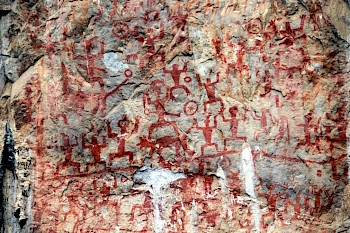 Rock Paintings of Huā MountainThe Rock Paintings of Huā Mountain (花山壁画) are believed to represent paintings of the ancient Luòyuè 雒越 people, the ancestors of the Zhuàng people and to date back at least to the period between BC 400 and AD 400. The main painting is located in Níngmíng 宁明 County close to the Míng River 明江 in Guǎngxī Province. Spurred by discoveries of archaeological sites such as Ban Chiang, Thai scholar Wongthet (1986) suggested a prehistoric presence of Tai people in Thailand. Upon inspection of the Rock Paintings of Huā Mountain (花山壁画) in Guǎngxī Province, Wongthet (1994) modified his theory in 1994 and speculated that Guǎngxī, the homeland of the Zhuang people, might be the historic origin of the Tai peopleThe Guǎngxī-Guìzhōu area is also proposed as the origin of proto-Tai by scholars who examined the spatial variation of terms connected with wet-rice farming. See Luo Wei, John Hartmann, Li Jinfang, and Vinya Sysamouth (2000). “GIS Mapping and Analysis of Tai Linguistic and Settlement Patterns in Southern China.” Geographic Information Sciences 6: 129–36.. Chinese historians, including Chen Lüfan (1990), proposed a similar theory according to which the Tai people originated from the ancient Luòyuè 雒越 people, one subgroup of the Bǎiyuè 百越 peopleSee Meacham, William (1996). “Defining the Hundred Yue.” Bulletin of the Indo-Pacific Prehistory Association 15, no. 2: 93–100..
Rock Paintings of Huā MountainThe Rock Paintings of Huā Mountain (花山壁画) are believed to represent paintings of the ancient Luòyuè 雒越 people, the ancestors of the Zhuàng people and to date back at least to the period between BC 400 and AD 400. The main painting is located in Níngmíng 宁明 County close to the Míng River 明江 in Guǎngxī Province. Spurred by discoveries of archaeological sites such as Ban Chiang, Thai scholar Wongthet (1986) suggested a prehistoric presence of Tai people in Thailand. Upon inspection of the Rock Paintings of Huā Mountain (花山壁画) in Guǎngxī Province, Wongthet (1994) modified his theory in 1994 and speculated that Guǎngxī, the homeland of the Zhuang people, might be the historic origin of the Tai peopleThe Guǎngxī-Guìzhōu area is also proposed as the origin of proto-Tai by scholars who examined the spatial variation of terms connected with wet-rice farming. See Luo Wei, John Hartmann, Li Jinfang, and Vinya Sysamouth (2000). “GIS Mapping and Analysis of Tai Linguistic and Settlement Patterns in Southern China.” Geographic Information Sciences 6: 129–36.. Chinese historians, including Chen Lüfan (1990), proposed a similar theory according to which the Tai people originated from the ancient Luòyuè 雒越 people, one subgroup of the Bǎiyuè 百越 peopleSee Meacham, William (1996). “Defining the Hundred Yue.” Bulletin of the Indo-Pacific Prehistory Association 15, no. 2: 93–100..
From a linguistic perspective, Chamberlain (1997) proposed the Tai-Kadai hypothesis, which is now rather widely accepted. According to this theory, Proto-Tai separated from other Kadai languages around BC 330.
Although Tai-Kadai people account for more than 22 million speakers in China, no full Bible has ever been completed in any of these languages. The New Testament was translated into three languages—Southern Dòng, Yōngběi Zhuàng, and Tai Lü—and Old Testament translations are in progress.
|
ISO639-3 |
Language |
Classification |
Population |
Book |
NT |
Bible |
|---|---|---|---|---|---|---|
|
kmc |
Southern Kam 侗语Kam is the autonym and Dòng is the Hàn Chinese exonym of this group of people. The Dòng 侗 nationality is one of the 56 official nationalities in China. There are two nonintelligible Dòng languages: Northern Dòng and Southern Dòng. Northern Dòng is moribund, but the language use of Southern Dòng is vibrant. |
Tai-Kadai, Kam-Sui |
1,000,000 |
|
2006The translation of the New Testament in Southern Dòng was completed in 2006 by the Research Foundation Language and Religion and published in the same year by Verlag für Theologie und Religionswissenschaft in Nurnberg, Germany. |
|
|
pcc |
Bùyī 布依语The Bùyī language is spoken by the Bùyī people, one of the 56 official nationalities in China. The Bùyī people live in Guìzhōu province, and their language forms a dialect chain with the Zhuàng languages in Guangxi Province. At the beginning of the twentieth century, the Hàn people referred to the Bùyī as Zhòngjiā 中家. |
Tai-Kadai, Tai, Northern |
2,600,000 |
1904China Inland Mission missionary Samuel Clarke 克拉克 (UK), with the assistance of Bùyī helpers, translated the Gospel of Matthew into Bùyī in 1904 using a Romanized script in which the tones were marked by diacritics. The manuscript was published by the BFBS in Shànghăi in the same year. Clarke acknowledged in his publications that most Bùyī can speak and read Chinese and could read a Chinese Bible when available (Clarke 1907: 269). |
|
|
|
zyb |
Yōngběi Zhuàng 邕北壮语Yōngběi 邕北 Zhuàng is a Northern Tai language and constitutes the basis of Standard Zhuàng. This variety includes Wǔmíng Zhuàng, which is the speech of Wǔmíng 武鸣 County in the north of the Yōng 邕 river. |
Tai-Kadai, Tai, Northern |
2,000,000 |
|
2016The New Testament was completed in 2016 by a team of native Zhuàng led by two anonymous American linguists. |
|
|
khb |
Tai Lü 傣仂语Tai Lü 傣仂语 is the Tai language spoken in the Xīshuāngbǎnnà 西双版纳 Prefecture in the south of Yúnnán Province. The name of this prefecture is derived from the Tai Lü place name Sipsongpanna, which means the “Twelve-Paddy-Rice-Townships.” |
Tai-Kadai, Tai, Southwestern |
550,000 |
1921Claude Mason and Lyle Beebe of the American Presbyterian Mission, together with their wives, arrived in Sipsongpanna/Xīshuāngbǎnnà (สิบสองปันนา/西双版纳) in 1917 to evangelize the Tai Lü people. They were allotted a piece of land by the Dai chieftain in the Jǐnghóng 景洪 district and built a church and hospital. The Tai Lü converts were two kinds of outcasts of the society: lepers and Pipa (=demon-)possessed people. Both groups were healed and settled together in “Christian villages.” Mr. and Mrs. Beebe adapted the Lao script for writing texts in Tai Lü. They formed a Bible translation group and finished Luke and John in 1921. Their manuscript was published by the American Bible Society and printed in Yokohama, Japan in 1921. | 1933In 1933, Mr. and Mrs. Beebe, with the assistance of Kru Myang, Cha Suh Phommah, Nan Tanawadi, and Cha Sincha, completed the first New Testament in Tai Lü in 1933. The manuscript was published by American Bible Society and printed in Bangkok in 1933. The number of baptized believers increased to 300 after the publication of the New Testament. By 1942, the missionaries had to depart, and church activities came gradually to a halt in the 1950s. In 1980, Christian life in the villages was revitalized, the “Christian villages” were reorganized, and the churches were rebuilt. |
|
|
cuu |
Tai Ya 花腰傣语The home area of Tai Ya 花腰傣语 is the Yùxī and Hónghé prefectures in Yúnnán Province. |
Tai-Kadai, Tai, Southwestern |
50,000 |
1922W. C. Dodd of the American Presbyterian Mission translated the Gospel of Matthew in 1922. It was published in Bangkok by the American Bible Society using the Yuan script. |
|
|
|
tdd |
Tai Nüa 傣那傣语Tai Nüa, also called Yunnanese Shan, is mainly spoken in Déhóng 德宏 Prefecture of Yúnnán Province. The Tai Nüa are part of the Dai 傣 nationality in China. |
Tai-Kadai, Tai, Southwestern |
540,000 |
1931The Gospel of Mark was completed in 1931 by E. Johansson (Swedish Free Mission), aided by Kong, a mother tongue teacher. It was published in the same year by the BFBS. |
|
|
Table 8: Bible Translation in Tai-Kadai Languages of China
Information on the Southern Kam (Dòng) New Testament will be introduced on the Kam 侗 page of this website.
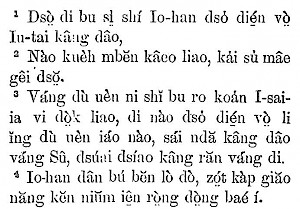 Gospel of Matthew 3: 1-4 in BùyīThe British missionary Samuel Clarke 克拉克 (1853–1946)See Clarke, Samuel R. (1904). “The Miao and Chungchia Tribes of Kweichow Province.” East of Asia Magazine 3: 193–207. was stationed in Guìzhōu Province in the early 1890s to work among the indigenous people. He first learned the Hmu language and by 1896, he compiled a Hmu language primer, a catechism, some tracts, and several hymns. After the tragic murder of his colleague William Fleming 明鑑光 in 1898 by opponents to the mission, Clarke turned to the Bùyī people and devised a Romanized script in which tones are marked by diacritics. By 1904, he and a team of native speakers translated the Gospel of Matthew in Bùyī, which was published by the BFBS in Shànghăi in the same year. Subsequently, Clarke did not translate other portions of the Bible into Bùyī because he assumed the more general function of a mission superintendent. Foreign missionaries began a new translation of the Bible in Bùyī in the early 2000s. Informal drafts of the translation are still circulating. Two American missionaries settled in Guǎngxī 广西 Province in 1992 and translated the New Testament into Northern (Yōngběi) Zhuàng 邕北壮语 in 2016.
Gospel of Matthew 3: 1-4 in BùyīThe British missionary Samuel Clarke 克拉克 (1853–1946)See Clarke, Samuel R. (1904). “The Miao and Chungchia Tribes of Kweichow Province.” East of Asia Magazine 3: 193–207. was stationed in Guìzhōu Province in the early 1890s to work among the indigenous people. He first learned the Hmu language and by 1896, he compiled a Hmu language primer, a catechism, some tracts, and several hymns. After the tragic murder of his colleague William Fleming 明鑑光 in 1898 by opponents to the mission, Clarke turned to the Bùyī people and devised a Romanized script in which tones are marked by diacritics. By 1904, he and a team of native speakers translated the Gospel of Matthew in Bùyī, which was published by the BFBS in Shànghăi in the same year. Subsequently, Clarke did not translate other portions of the Bible into Bùyī because he assumed the more general function of a mission superintendent. Foreign missionaries began a new translation of the Bible in Bùyī in the early 2000s. Informal drafts of the translation are still circulating. Two American missionaries settled in Guǎngxī 广西 Province in 1992 and translated the New Testament into Northern (Yōngběi) Zhuàng 邕北壮语 in 2016.
Portions of the Bible were translated into three Tai languages in the early twentieth century: Tai Lü, Tai Ya, and Tai Nüa.
 Tai Lü Woman, 1918The ministry of Claude Mason and Lyle Beebe of the American Presbyterian Mission among the Tai Lü people is remarkable. They arrived in Sipsongpanna/Xīshuāngbǎnnà(สิบสองปันนา/西双版纳)In the Tai Lü language, Sipsongpanna (or its Chinese transliteration Xīshuāngbǎnnà) means “the paddy-rice twelve-townships.” in 1917 to evangelize the Tai Lü people. The ministry was allotted a piece of land by the Tai chieftain in the Jǐnghóng 景洪 district, and it built a church and hospital. The ministry reached out to the outcasts of the Tai society: the lepers and demon-possessed people (there existed a somewhat arbitrary and sometimes abusive process by which people were declared demon-possessedSee Ai, Juhong (2016). “The Politics of Identity: Identity Research on Dai Christians in Sipsongpanna.” In Yearbook of Chinese Theology, edited by Paulos Z. Huang, 48–64. Leiden: Brill..) These outcasts were forced to roam in the wilderness to survive until they died a dreadful death. Mason and Beebe evangelized them and settled them in special “Christian villages.” Mr. and Mrs. Lyle Beebe translated the Gospels of Luke and John into Tai Lü by 1921 and the entire New Testament by 1933. The number of baptized believers increased to 300 after the publication of the New Testament. By 1942, the missionaries had to leave because of the general political situation, and in the 1950s, church activities came to a gradual halt. In the 1980s, after the Cultural Revolution, Christian life was resumed, the “Christian villages” were reorganized, and the churches were rebuilt.
Tai Lü Woman, 1918The ministry of Claude Mason and Lyle Beebe of the American Presbyterian Mission among the Tai Lü people is remarkable. They arrived in Sipsongpanna/Xīshuāngbǎnnà(สิบสองปันนา/西双版纳)In the Tai Lü language, Sipsongpanna (or its Chinese transliteration Xīshuāngbǎnnà) means “the paddy-rice twelve-townships.” in 1917 to evangelize the Tai Lü people. The ministry was allotted a piece of land by the Tai chieftain in the Jǐnghóng 景洪 district, and it built a church and hospital. The ministry reached out to the outcasts of the Tai society: the lepers and demon-possessed people (there existed a somewhat arbitrary and sometimes abusive process by which people were declared demon-possessedSee Ai, Juhong (2016). “The Politics of Identity: Identity Research on Dai Christians in Sipsongpanna.” In Yearbook of Chinese Theology, edited by Paulos Z. Huang, 48–64. Leiden: Brill..) These outcasts were forced to roam in the wilderness to survive until they died a dreadful death. Mason and Beebe evangelized them and settled them in special “Christian villages.” Mr. and Mrs. Lyle Beebe translated the Gospels of Luke and John into Tai Lü by 1921 and the entire New Testament by 1933. The number of baptized believers increased to 300 after the publication of the New Testament. By 1942, the missionaries had to leave because of the general political situation, and in the 1950s, church activities came to a gradual halt. In the 1980s, after the Cultural Revolution, Christian life was resumed, the “Christian villages” were reorganized, and the churches were rebuilt.
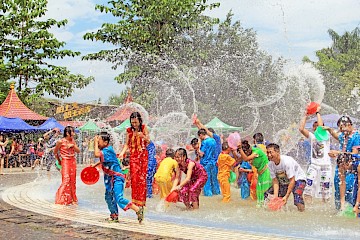 Water-Splashing Festival of the Tai peopleDuring the New Year in August, the Tai people would go to the temple to bathe the Buddha with fresh water and then splash water on each other to symbolize ritual blessings. This picture shows the Tai Lü people in Xīshuāngbǎnnà 西双版纳, Southern Yúnnán. William Clifton and Isabella Eakin Dodd of the American Presbyterian Mission arrived in Chiang Mai, Northern Thailand in 1886. William Dodd took a number of significant exploratory trips into Eastern Burma and Southern China and wrote travel reports and scholarly papers that raised interest in the Tai people. On several of his trips during 1910–1916, he evangelized the Tai Ya in Hónghé 红河 and Yùxī 玉溪 prefectures, China. William Dodd and his wife settled in Jǐnghóng 景洪 in 1917 to better reach out to the different Tai groups in China, but he died only two years later in 1919. His widow, Isabella, adapted the Lao script for writing in Tai Ya and translated the Gospel of Matthew into Tai Ya by 1922, which was published by the American Bible Society in Bangkok.
Water-Splashing Festival of the Tai peopleDuring the New Year in August, the Tai people would go to the temple to bathe the Buddha with fresh water and then splash water on each other to symbolize ritual blessings. This picture shows the Tai Lü people in Xīshuāngbǎnnà 西双版纳, Southern Yúnnán. William Clifton and Isabella Eakin Dodd of the American Presbyterian Mission arrived in Chiang Mai, Northern Thailand in 1886. William Dodd took a number of significant exploratory trips into Eastern Burma and Southern China and wrote travel reports and scholarly papers that raised interest in the Tai people. On several of his trips during 1910–1916, he evangelized the Tai Ya in Hónghé 红河 and Yùxī 玉溪 prefectures, China. William Dodd and his wife settled in Jǐnghóng 景洪 in 1917 to better reach out to the different Tai groups in China, but he died only two years later in 1919. His widow, Isabella, adapted the Lao script for writing in Tai Ya and translated the Gospel of Matthew into Tai Ya by 1922, which was published by the American Bible Society in Bangkok.
The Swedish Free MissionThe Swedish name is Svenska Fria Missionen, and its former name was Svensk Pingstmission. The mission in Yunnan was officially registered under the Chinese name of 瑞典神召会 (Ruìdiǎn Shén Zhàohuì, Swedish Assemblies of God), see Tiedemann (2009: 219). , a mission of Pentecostal Assemblies in Sweden, started working in Yúnnán Province in 1922 under the auspices of Anna and Zakris Zakrisson. Their colleague, Endy Johansson, was appointed as a missionary to the Tai Nüa in Déhóng 德宏 Prefecture, which borders Myanmar, at the beginning of the 1920s. As the Tai Nüa people have their own 700-year-old alphabetic script for writing Buddhist texts, called Tai LeSee Everson, Michael (2001). Revised proposal for encoding the Tai Le script in the Bitmap (BMP) of the Universal Coded Character Set (UCS). Published by the Unicode Consortium on its website on 06-Oct-2001.
Zhōu Mínglǎng (2003). Multilingualism in China: The Politics of Writing Reforms for Minority Languages 1949-2002. New York: Mouton de Gruyter., Johansson used this scriptThe Tai Le script was also used by Miss Stileman, wife of Harry Stileman of the Bible Churchman’s Missionary Society, in the 1940s for transliterating two books (Luke and Acts) of the Shan Bible into the Tayok dialect of Shan. The Shan Bible was completed in 1892 and published in Burmese characters in Myanmar. Because the Tayok dialect is closely related to Tai Nüa, the use of the Tai Le script helped accommodate the readers of this dialect. for Bible translation. In 1931, Johansson completed the Gospel of Mark with the assistance of his Tai Nüa teacher Kong, and the BFBS published the Gospel in the same year. Endy Johansson left Yúnnán before completing the New Testament.
Tibeto-Burman Minorities (14)
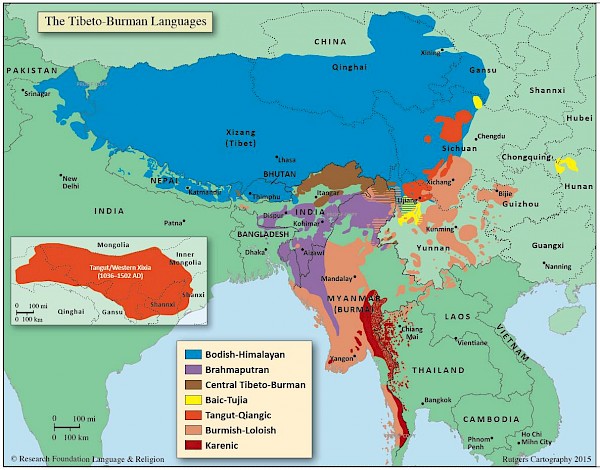 The Tibeto-Burman languages total more than 450 languages, and together with the Sinitic languages, they form the Sino-Tibetan language family. The Tibeto-Burman people dwell in India, Nepal, Myanmar, Bhutan, Thailand, and China.
The Tibeto-Burman languages total more than 450 languages, and together with the Sinitic languages, they form the Sino-Tibetan language family. The Tibeto-Burman people dwell in India, Nepal, Myanmar, Bhutan, Thailand, and China.
Five complete Bibles were translated in Tibeto-Burman languages of China, Standard Tibetan (1948), Flowery Lisu (1968), Achang (2011), Black Lisu or Lipo (2016), and Black Yi or Nasu (2016). There are six languages with only New Testaments and three languages with only Bible portions. Details are shown in the following chart.
|
ISO639-3 |
Language |
Classification |
Population |
Book |
NT |
Bible |
|---|---|---|---|---|---|---|
|
bod |
Standard Tibetan 藏语Standard Tibetan is the Tibetan language used as the official language in the Tibet Autonomous Region, China. The written form contains numerous elements that are influenced by Classical Tibetan. |
Tibeto-Burman, Bodish |
1,070,000 |
1862The Acts of Apostles was the first book of the Bible that was translated into Tibetan. It was completed in 1862 by a committee of the Moravian Church Mission including H. A. Jaeschke, A. W. Heyde, and F. A. Redslob. | 1885The New Testament was completed in 1885 by a committee of the Moravian Church Mission, including H. A. Jaeschke, A. W. Heyde, and F. A. Redslob. It was published in the same year by the BFBS in Berlin. The New Testament was revised in 1903 by a committee, including A. W. Heyde, D. MacDonalds, and J. F. Frederickson. | 1948The entire Bible was completed before World War II by A. H. Francke and Y. Gergan (Moravian Church Mission). The manuscript was sent to England, where it was stored during the war in the crypt of Ripon Cathedral. The 1948 Bible contains a revised New Testament by Chandhu Ray. |
|
atb |
Zaiwa 景颇语Zaiwa, which is also known as Atsi language, is a language spoken in Yúnnán Province, Déhóng Prefecture, by people belonging to the Chinese Jǐngpō nationality 景颇族. |
Tibeto-Burman, Burmish, North |
80,000 |
1939The Gospel of Mark was translated in 1939 by F. J. Fitzwilliam (China Inland Mission) using the Fraser Script. In 1951, the Gospel of Mark was transliterated into Roman characters by E. J. Cox (China Inland Mission) and published in Rangoon by the BFBS. | 2009A committee of the United Bible Societies completed the New Testament in 2009, which was published in the same year in Rangoon. |
|
|
acn |
Āchāng 阿昌语About 30,000 Āchāng people live in China and about 30,000 live in Myanmar. The selfname of the Āchāng people is Ngochang. |
Tibeto-Burman, Burmish, North |
60,000 |
|
1992The Āchāng translator Nasaw Sampu, who was sponsored by the Asian Christian Service, completed the first New Testament in 1992. The manuscript was published by the Asian Christian Service, and 1,000 copies were printed in Hong Kong. | 2011Doug and Connie Inglis of Wycliffe Canada settled in Thailand in 1990 to work from there with the Āchāng people in China and Myanmar. They analyzed the phonology of Āchāng, compiled a dictionary (Inglis & Inglis 2003; Sampu et al. 2005), and advised the Old Testament project with Nasaw Sampu, who served as the main translator. The Old Testament was completed in 2009, and the entire Bible was published by the Bible Society of Myanmar in Rangoon. |
|
lis |
Flowery Lisu 花傈僳语The Flowery Lisu, or Western Lisu, live in the Bǎoshān 保山 and Déhóng 德宏 prefectures of Yúnnán Province. They were evangelized by James Outram Fraser (China Inland Mission) during 1910–1938. Fraser developed a script, the Fraser Script, into which the New Testament was translated. |
Tibeto-Burman, Lolo, Central |
600,000 |
1921In 1921, the Gospel of Mark was also translated by Fraser of the China Inland Mission and published in the same year by the BFBS in Shànghăi. | 1938The New Testament was completed by Fraser, Allyn Cooke, and Lisu assistant Moses Nguali in 1938, which was also when Fraser died from malaria. The New Testament was published in 1938 by the China Bible House in Shànghăi. | 1968The entire Bible was completed in 1968 by Allyn Cooke, John Kuhn, and Allan Crane (Overseas Missionary Fellowship) and was published by the Bible Society of Burma. Two Christian organizations in Yúnnán set up a review committee, which revised the entire Bible by 2008. The Chinese Christian Council published the revised Bible and printed 50,000 copies in Nánjīng. |
|
lpo |
Black Lisu 黑傈僳语The Black Lisu, also called Eastern Lisu or Lipo 里泼, mainly reside in Chŭxióng 楚雄 Prefecture of Yúnnán Province and Huìdōng 会东 and Huìlĭ 会理 counties of Sìchuān Province. The Black Lisu language has two dialects, which are not completely intelligible, called Western Lipo and Eastern Lipo. The Western Lipo branch of Black Lisu is concentrated in Yongren 永仁 and Dayao 大姚 counties of Eastern Chŭxióng 楚雄. The Chinese Government has classified Western Lipo within the Yi nationality. The Eastern Lipo dialect of Black Lisu is spoken by people living in Wŭdìng 武定, Yuánmó 元谋, and Lùquàn 禄劝 counties of Western Chŭxióng 楚雄 as well as in Huìdōng 会东 and Huìlĭ 会理 counties in Sìchuān. The Eastern Lipo people are grouped within the Lisu nationality. |
Tibeto-Burman, Lolo, Central |
250,000 |
1912The Gospel of Matthew was translated in 1912 by George Metcalf and Arthur Nicholls (both with the China Inland Mission) and published in the same year by the BFBS in Shànghăi. | 1951The New Testament was completed before 1951 by George Metcalf (China Inland Mission) and was published in 1951 by the China Bible House in Hong Kong. | 2016In 1992, the Yúnnán Three-Self Church instituted a Lipo translation committee, including Elder Bi Hongzheng and 13 Lipo pastoral co-workers. The group integrated, revised the New Testament of 1951, and translated the Old Testament during 1992–2013. In the translation process, they engaged consultants of the United Bible Societies for help. The China Christian Council published the Bible in 2016. |
|
yna |
Alupu 干彝语Another name for the Alupu language is Laka or Dry Yí. The people who speak this language belong to the Yí Nationality and live in Wŭdìng 武定 County of Yúnnán Province. |
Tibeto-Burman, Lolo, Central |
41,000 |
1912The Gospel of Mark was translated in 1912 by A. G. Nicholls (China Inland Mission) using the Pollard Script. |
2016In 2008, the Yúnnán China Christian Council and Three-Self Patriotic Movement formed a translation group for the Alupu Old Testament, including Alupu pastor Fu Lianxing. The team completed the translation of the Old Testament eight years later. The manuscript in Pollard Script was published by the Yúnnán Chinese Christian Council and Three-Self Patriotic Movement in 2016 and 3,000 copies were printed. A dedication ceremony was held on March 13, 2016 in the Heinaji Church in Chuxiong. Yang Yi, 2016a, The Gan Yi Version of The Old Testament Published. Article published on 20-Mar-2016 in China Christian Daily, under the auspices of the Beijing Gospel Times Information Technology Co. Ltd. in Beijing. |
|
|
ywq |
Nasupu 黑彝语Nasupu is the autonym of this group while Black Yí or 黑彝 is the Hàn Chinese exonym. These people live in Chŭxióng 楚雄 Prefecture of Yúnnán Province. |
Tibeto-Burman, Lolo, Central |
250,000 |
1923The Gospel of Luke was translated in 1923 by G. Porteus (China Inland Mission) and published in the same year by the British and Foreign Bible Society in Shànghăi. | 1948The New Testament was translated into Nasu in 1948 also by G. Porteus (China Inland Mission) and his collaborators, and published in the same year by the China Bible House in Shànghăi. | 2016The Yúnnán Chinese Christian Council instituted a translation committee for the Nasu Old Testament in the 1990s, including native Pastor Wen Fu. The committee completed the Old Testament before 2010 and then revised the New Testament of 1948. After a lengthy approval process, the entire Bible was published by the Chinese Christian Council in 2016 and printed at Amity Press in Nánjīng. |
|
lhi |
Lahu Shi 黄拉祜语The Lahu Shi 黄拉祜族 or Yellow Lahu live in China (population approximately 120,000), Myanmar (60,000), Thailand (15,000), and Laos (3,000). Their language differs from the Lahu Na (Black Lahu). The Lahu form one of the 56 nationalities in China. |
Tibeto-Burman, Lolo, Central |
117,000 |
2009Arthur and Pamela Cooper of Wycliffe USA settled in Chiang Mai in 1993 to work with the Lahu Shi in Thailand. They adapted and finalized the existing (Lahu Na) orthograph, took responsibility for an existing, but disunited, Bible translation group and were able to reorganize it, and translated a gospel into Lahu Shi in 2009. | 2015A team, including Arthur and Pamela Cooper of Wycliffe USA, Upai Jasa of Wycliffe Thailand, and Lahu Si translator Duangthip Nakiri, completed the New Testament in 2015. The manuscript was published by Wycliffe Thailand in the same year and dedicated on February 13, 2016. The New Testament is intelligible to the Lahu Shi people in China, where most of the people live. |
|
|
nuf |
Nusu 怒语The Nusu 怒族 people constitute one of the 56 nationalities in China. Their language is also spoken in Myanmar by several hundred people. |
Tibeto-Burman, Lolo, Central |
12,000 |
2010Ethnologue-17 reported the translation of a book of the Bible in Nusu in 2010. By 2019, the anonymous organization behind this project uploaded seven books of the New Testament on their project website: http://nusu.win/en/Home. |
|
|
|
ygp |
Kopu 白彝语The Kopu is an ethnic group within the Yí nationality that comprises approximately 50,000 people. An alternate name of this group is White Yí, although there are several other Yí groups called by this name. The Kopu reside in Qǔjìng, Hónghé, and Chǔxióng prefectures. |
Tibeto-Burman, Lolo, North |
50,000 |
1913The Gospel of Mark was translated in 1913 by A. G. Nicholls (China Inland Mission) and A. Evans (United Methodist Mission) using the Pollard Script. It was published in the same year by the BFBS in Yokohama, Japan. |
2015Almost a century later, the Yúnnán Chinese Christian Council and Three-Self Patriotic Movement formed a committee for translating the New Testament into Kopu in 2009, inviting Kopu lead translator Li Wanxing, five other Kopu translators, and United Bible Societies’ consultant Yu Suee Yan to be members of the team. They worked at Kūnmíng and completed the project in 2015. They used the Pollard Script, for which United Bible Societies provided literacy courses. The manuscript was printed at Amity Press in Nánjīng. Oh, Cynthia, 2015, God’s written word a century after. Posted on 02-Mar-2015 on the website of the United Bible Societies China Partnership project, a website related to the United Bible Societies. |
|
|
iii |
Nuosu 凉山黑彝语The Nuosu people live mainly in Liángshān Prefecture in Sìchuān Province. They constitute the most populous group within the Yí nationality. Their language use is vibrant. |
Tibeto-Burman, Lolo, North |
2,000,000 |
|
2005The New Testament was completed in 2005 by the Research Foundation and published in the same year by Verlag für Theologie und Religionswissenschaft in Nurnberg, Germany. |
|
|
yig |
Neasu 黔西彝语The Neasu language is spoken by about 600,000 people in Wēiníng 威宁 and Hèzhāng 赫章 counties of Guìzhōu Province. The Neasu and Nuosu languages are related, although unintelligible. |
Tibeto-Burman, Lolo, North |
600,000 |
|
2018Together with a pastor of the Three-Self Church in Wēiníng, members of Research Foundation Language and Religion developed a Romanized script and translated, revised, and tested the entire New Testament in Neasu by 2006. The manuscript was published in 2018 by Verlag für Theologie und Religionswissenschaft in Nürnberg, with 3,000 copies printed in Hong Kong. |
|
|
ktp |
Kǎduō Hāní 卡多哈尼语Kǎduō is a dialect of the Hāní 哈尼 language spoken in Yuánjiāng 元江 county. |
Tibeto-Burman, Lolo, South |
20,000 |
1939Bertha Preisinger of the Vandsburger Mission (Germany) arrived at the mission station in Táohuāpíng 桃花坪 (of their partner organization Liebenzeller Mission), Húnán in 1912. In 1928, she was transferred to the mission station of Éshān 峨山 (China Inland Mission) and in 1932 to the mission station of Yuánjiāng 元江 (American Presbyterian Mission), both in Yúnnán. The American Presbyterian Mission station was transferred to the Vandsburger Mission in 1933. She began working with the Kǎduō people, who belong to the Hāní 哈尼 nationality. She adapted the Pollard Script and translated the Gospel of Luke into Kǎduō in 1939. The manuscript was published by the BFBS in Shànghăi in 1939. |
|
|
|
nxq |
Nàxī 纳西语Nàxī is spoken in Northwest Yúnnán, in Yùlóng County. |
Tibeto-Burman, Tangut-Qiangic |
300,000 |
1932The Gospel of Mark was translated in 1932 by Elize Scharten (Dutch Pentecostal Missionary Society), using the Fraser Script. It was published in the same year by the BFBS in Shànghăi. |
|
|
Table 9: Bible Translation in Tibeto-Burman Languages of China
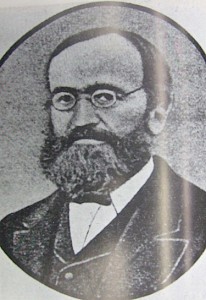 Heinrich A. JäschkeHeinrich A. Jäschke, 1817-1883.More than one million speakers of Standard Tibetan dwell in Tibet, China and only 100,000 live in India and Nepal. The story of the Tibetan Bible began in 1856, when Khedrup Gyatso (1838–1856), the eleventh Dalai Lama, suddenly died in the Potala Palace in Lhasa, Tibet. Tempu Gergan, the Minister of Finance, was suspected of murdering the Dalai Lama. He fled Lhasa and settled down in the Luba valley near Leh (Ladakh) in the Indian state of Jammu and KashmirThis story is recorded in Maberly, Allan (2001). God Spoke Tibetan. Rockwall: Evangelical Bible Translators.. In the 1850s, the Moravian Church, with roots in the reformer Jan Hus (1369–1415), sent William Heyde, Edward Pagel, Heinrich August Jäschke, and later August Francke to Western Tibet. They settled down in Leh in 1858 and benefited from the help of Tempu Gergan, the owner of the land where they established a mission. After the death of Tempu Gergan, his son, Sonam Gergan, converted to Christianity and changed his name to Yoseb Gergan.
Heinrich A. JäschkeHeinrich A. Jäschke, 1817-1883.More than one million speakers of Standard Tibetan dwell in Tibet, China and only 100,000 live in India and Nepal. The story of the Tibetan Bible began in 1856, when Khedrup Gyatso (1838–1856), the eleventh Dalai Lama, suddenly died in the Potala Palace in Lhasa, Tibet. Tempu Gergan, the Minister of Finance, was suspected of murdering the Dalai Lama. He fled Lhasa and settled down in the Luba valley near Leh (Ladakh) in the Indian state of Jammu and KashmirThis story is recorded in Maberly, Allan (2001). God Spoke Tibetan. Rockwall: Evangelical Bible Translators.. In the 1850s, the Moravian Church, with roots in the reformer Jan Hus (1369–1415), sent William Heyde, Edward Pagel, Heinrich August Jäschke, and later August Francke to Western Tibet. They settled down in Leh in 1858 and benefited from the help of Tempu Gergan, the owner of the land where they established a mission. After the death of Tempu Gergan, his son, Sonam Gergan, converted to Christianity and changed his name to Yoseb Gergan.
 Tibetan Pastor Yoseb GerganYoseb Gergan became the main translator of the Tibetan Bible. Jäschke, who led the translation project, chose Lhasa Tibetan as the basic speech but allowed elements of Classical Tibetan in the target language. The Gospel of John was translated in 1862 and printed in Lahul, India. The New Testament was completed in 1885 and printed in Ladakh, India, two years after the death of Jäschke.
Tibetan Pastor Yoseb GerganYoseb Gergan became the main translator of the Tibetan Bible. Jäschke, who led the translation project, chose Lhasa Tibetan as the basic speech but allowed elements of Classical Tibetan in the target language. The Gospel of John was translated in 1862 and printed in Lahul, India. The New Testament was completed in 1885 and printed in Ladakh, India, two years after the death of Jäschke.
An Old Testament committee was formed in 1891, which included August Francke of the Moravian Church, British trade agent David MacDonald at Yatung, and Tibetan pastor Yoseb Gergan. Gergan produced the first draft of the Old Testament in 1910 and sent it to Francke, who corrected the manuscript and discussed it with MacDonald. The entire Bible was completed before the Second World War, but was not published until 1948 by the Bible Society of India and Ceylon in Lahore.
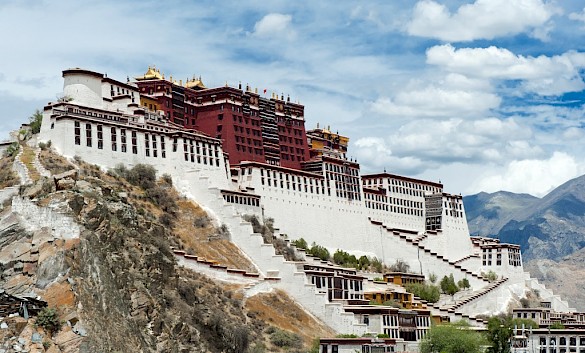 Potala Palace in Lhasa, Tibet, ChinaThe Potala Palace in Lhasa was the residence of the Dalai Lama until 1959.
Potala Palace in Lhasa, Tibet, ChinaThe Potala Palace in Lhasa was the residence of the Dalai Lama until 1959.
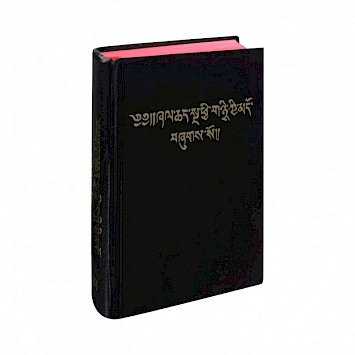 Tibetan Bible (1948)
Tibetan Bible (1948)
The China Inland Mission (CIM) 内地会 missionaries Francis and Jennie Fitzwilliam (USA) settled in Yúnnán Province in 1927 to work with the Lisu. However, after their first furlough in 1935, they began working with the Zaiwa people in Lǒngchuān 陇川 along the Burmese border and translated the Gospel of Mark into Zaiwa in 1938. They used the Fraser script (originally devised for Lisu), and the manuscript was published privately and printed in Zhīfú 芝罘, Shandong, China. After the death of Francis Fitzwilliam in 1940, the translation project was canceled. Half a century later in 1990, Mark Wannemacher of Wycliffe USA settled in Thailand to work from there with the Zaiwa people in China and Myanmar. A team of native speakers coordinated by Wannemacher translated the New Testament into Zaiwa in 2009, using the Zaiwa orthography created by the Chinese Government in the 1950s.
The Achang translator Nasaw Sampu completed the first New Testament in 1992 using the Romanized script of the Chinese Government. The manuscript was published by the Asian Christian Service, which printed 1,000 copies in Hong Kong. Doug and Connie InglisSee Inglis, Douglas and Connie Inglis (2003). A preliminary phonology of Ngochang, presented at the 36th Annual Sino-Tibetan Conference on Languages and Linguistics. La Trobe University, Melbourne, Australia. (Accessed on 15th of February, 2019). of Wycliffe Canada, who were stationed in Thailand, advised the Old Testament project with Nasaw Sampu, who served as the main translator. The entire Bible was completed in 2009 and published by the Bible Society of Myanmar in Rangoon.
James Outram Fraser 富能仁 (1886–1938) of the China Inland Mission (CIM) had a successful ministry among the Flowery Lisu people in Northeastern Yúnnán Province. He designed the Fraser Script for translating the New Testament into Lisu. Fraser organized converts into self-supporting indigenous churches. He completed the Gospel of Mark in 1922, went on a furlough to England during 1924–1926, and continued the work after his return. He was joined by CIM missionaries Allyn and Leila Cooke. The Cookes, with the help of Lisu assistant Moses Nguali, took responsibility for the translation work in the 1930s. The Cookes and Moses Nguali completed the New Testament in 1938, which is the same year Fraser died from malaria. He was buried in Baoshan, Yúnnán, leaving his wife and three children. An estimated 600 Lisu believers were baptized by 1918. By 1950, this number grew to 14,800 and by the 1990s, to more than 100,000. The translation of the Lisu Old Testament began in 1956 in Chiang Mai, Thailand by a committee established by the China Inland Mission, which was renamed the Overseas Missionary Fellowship in 1964. The committee included Allyn Cooke, John Kuhn, and Allan Crane. The translators completed the entire Bible in 1968.
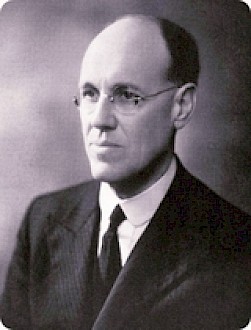 James Fraser 富能仁James O. Fraser 富能仁 (1886–1938) was the missionary of the Lisu people. He was affiliated with the China Inland Mission.
James Fraser 富能仁James O. Fraser 富能仁 (1886–1938) was the missionary of the Lisu people. He was affiliated with the China Inland Mission.
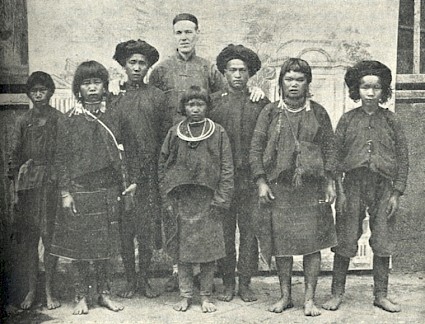 James Fraser with indigenous Christians
James Fraser with indigenous Christians
 Flowery Lisu New TestamentThe Flowery Lisu New Testament was first published in 1938.
Flowery Lisu New TestamentThe Flowery Lisu New Testament was first published in 1938.
George Edgar Metcalf 王懷仁 (1879–1956), an English missionary of the China Inland Mission (CIM), translated the Gospel of Matthew into Black Lisu (Eastern Lipo) in 1912 and the entire New Testament in 1951.
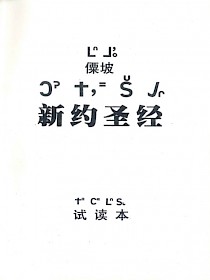 Lipo New TestamentPublished anonymously in 2002.Upon completion of the New Testament, he was forced to leave China following the Communist victory over the Republican government. Metcalf carried a hand-written copy to Hong Kong and left one copy with the Lisu/Lipo church that he had established. However, the church’s copy was lost, but Metcalf’s copy survived and was printed at the China House in Hong Kong. Unfortunately, the copies that were sent to Yúnnán Province were never received. In 1999, George Metcalf’s daughter Ruth presented the Black Lisu New Testament to the Religious Affairs Bureau in Wŭdìng 武定 County, Yúnnán. Since the beginning, the Black Lisu people have been receptive of Christianity as evidenced in 1912, when hundreds of Eastern Lisu were reported baptized. According to one account, there were 60,000 Lisu/Lipo Christians in Eastern Chŭxióng 楚雄 in 1999. An anonymous mission organization published the entire New Testament in Pollard Script in 2002, probably using Metcalf’s original translation.
Lipo New TestamentPublished anonymously in 2002.Upon completion of the New Testament, he was forced to leave China following the Communist victory over the Republican government. Metcalf carried a hand-written copy to Hong Kong and left one copy with the Lisu/Lipo church that he had established. However, the church’s copy was lost, but Metcalf’s copy survived and was printed at the China House in Hong Kong. Unfortunately, the copies that were sent to Yúnnán Province were never received. In 1999, George Metcalf’s daughter Ruth presented the Black Lisu New Testament to the Religious Affairs Bureau in Wŭdìng 武定 County, Yúnnán. Since the beginning, the Black Lisu people have been receptive of Christianity as evidenced in 1912, when hundreds of Eastern Lisu were reported baptized. According to one account, there were 60,000 Lisu/Lipo Christians in Eastern Chŭxióng 楚雄 in 1999. An anonymous mission organization published the entire New Testament in Pollard Script in 2002, probably using Metcalf’s original translation.
In 1992, before Ruth Metcalf presented her father’s translation of the New Testament to the Religious Bureau of Wŭdìng, the Yúnnán Three-Self Church instituted a Lipo translation committee, including Elder Bi Hongzheng and 13 Lipo pastoral co-workers. The group integrated, revised the New Testament of 1951, and translated the Old Testament during 1992–2013. During the translation process, the committee engaged consultants of the United Bible Societies for assistance. In 2016, the China Christian Council published the Bible.
The Naxi 纳西 Nationality in Yúnnán Province has attracted international scholarly attentionAustro-American botanist Joseph Rock (1884–1962) and author of The Ancient Na-Khi Kingdom (1947) resided in Lìjiāng in the same neighborhood as Elize Scharten between 1922 and 1945. Rock worked in the Lìjiāng area as an explorer, first for the U.S. Department of Agriculture of Washington D.C. and then for the National Geographic Society. During 1944–1945, he was a consultant to the U.S. Army Map Service. mainly because of their cultural features: their matriarchal family structure and traditional pictographic script.
 Lìjiāng in Yúnnán provinceThe old town of Lìjiāng in Yúnnán province is home to the Naxi 纳西 Nationality and Unesco World Heritage Site.
Lìjiāng in Yúnnán provinceThe old town of Lìjiāng in Yúnnán province is home to the Naxi 纳西 Nationality and Unesco World Heritage Site.
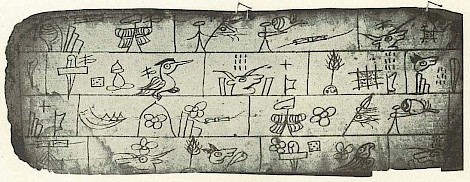 Naxi Traditional Pictographic Script
Naxi Traditional Pictographic Script
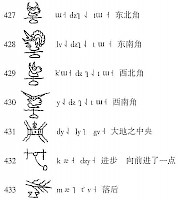 Pictograms decipheredSample page of Naxi pictograms deciphered in Chinese by Zhào Jìngxiū 赵净修 (2001). The Meaning of Common Dōngbā Pictograms. Kūnmíng: Yúnnán People’s Publisher House.
Pictograms decipheredSample page of Naxi pictograms deciphered in Chinese by Zhào Jìngxiū 赵净修 (2001). The Meaning of Common Dōngbā Pictograms. Kūnmíng: Yúnnán People’s Publisher House.
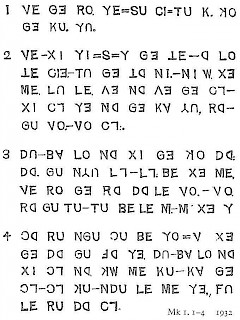 Gospel of Mark 1: 1-4Excerpt of Gospel of Mark translated into Naxi by Elize Scharten in 1932 by using the Fraser Script.After coordinating with the China Inland Mission (CIM), a group of Dutch Pentecostal missionariesCecil Polhill, one of the Cambridge Seven Band who joined the Chinese Inland Mission in 1885 as a missionary to China, returned to Europe in the wake of the Boxer uprising in 1900. He received Spirit baptism when he attended the meetings at Azusa Street, Los Angeles in 1908 (Robeck, 2006: 69). Upon his return in 1909, Polhill founded the Pentecostal Missionary Union (PMU) in London, which sent missionaries to China and elsewhere (Hocken 1988: 125-126). The Dutch Pentecostal Mission was formed in 1920 and channeled its missionaries through the PMU (Van der Laan 1997)., including Elize SchartenElize Scharten (1876–1965) was the daughter of a Lutheran minister in Amsterdam, the seventh of nine children. Elize experienced Spirit baptism after she attended meetings of the nascent Pentecostal movement in Amsterdam in 1908. During a conference in Sunderland, England, she received her missionary calling to China. She left for China in April 1912 and joined other Dutch Pentecostal missionaries in Yúnnán Province. Interrupted by two furloughs and the civil war period in 1927, Elize stayed for more than 34 years on the mission field and returned to the Netherlands in 1947 (Van der Laan 1997). (1876-1965), began missionary work in Lìjiāng 丽江 in 1912. After 1923, the group was joined by Pentecostal missionaries from England and GermanyA dispute appeared between the British-led Pentecostal Missionary Union and the Dutch missionaries, when a British missionary was appointed to lead the work in Lìjiāng but whom the Dutch rejected. The Dutch missionaries separated from the PMU but later managed to work beside the British missionaries (Van der Laan 1997).. Elize Scharten studied the Naxi language, adapted James Frazer’s Lisu script to Naxi, prepared a dictionary, and translated the Gospel of Mark, a catechism, and a song book. The Gospel of Mark was printed by the BFBS in Shànghaĭ in 1932.
Gospel of Mark 1: 1-4Excerpt of Gospel of Mark translated into Naxi by Elize Scharten in 1932 by using the Fraser Script.After coordinating with the China Inland Mission (CIM), a group of Dutch Pentecostal missionariesCecil Polhill, one of the Cambridge Seven Band who joined the Chinese Inland Mission in 1885 as a missionary to China, returned to Europe in the wake of the Boxer uprising in 1900. He received Spirit baptism when he attended the meetings at Azusa Street, Los Angeles in 1908 (Robeck, 2006: 69). Upon his return in 1909, Polhill founded the Pentecostal Missionary Union (PMU) in London, which sent missionaries to China and elsewhere (Hocken 1988: 125-126). The Dutch Pentecostal Mission was formed in 1920 and channeled its missionaries through the PMU (Van der Laan 1997)., including Elize SchartenElize Scharten (1876–1965) was the daughter of a Lutheran minister in Amsterdam, the seventh of nine children. Elize experienced Spirit baptism after she attended meetings of the nascent Pentecostal movement in Amsterdam in 1908. During a conference in Sunderland, England, she received her missionary calling to China. She left for China in April 1912 and joined other Dutch Pentecostal missionaries in Yúnnán Province. Interrupted by two furloughs and the civil war period in 1927, Elize stayed for more than 34 years on the mission field and returned to the Netherlands in 1947 (Van der Laan 1997). (1876-1965), began missionary work in Lìjiāng 丽江 in 1912. After 1923, the group was joined by Pentecostal missionaries from England and GermanyA dispute appeared between the British-led Pentecostal Missionary Union and the Dutch missionaries, when a British missionary was appointed to lead the work in Lìjiāng but whom the Dutch rejected. The Dutch missionaries separated from the PMU but later managed to work beside the British missionaries (Van der Laan 1997).. Elize Scharten studied the Naxi language, adapted James Frazer’s Lisu script to Naxi, prepared a dictionary, and translated the Gospel of Mark, a catechism, and a song book. The Gospel of Mark was printed by the BFBS in Shànghaĭ in 1932.
Scharten founded a church attended by the Naxi and Lisu people and trained their leaders. The church, however, did not survive the Cultural Revolution (1966–1976); the building was confiscated, many members were incarcerated, and several spiritual leaders Scharten had trained died during their long emprisonment. Visitors from the Netherlands, Germany and England in the 1980s found the memory of Elize Scharten among survivors still vivid. Xuan Ke, a music and English teacher whose father belonged to Scharten’s trainees requested a copy of the Gospel of Mark which was delivered by the German Pentecostal Mission in 1988See van der Laan (1997).. Plans of reprinting the Gospel translation have been not been carried out due to the uncertain spiritual needs of the Naxi people in the Lìjiāng area.
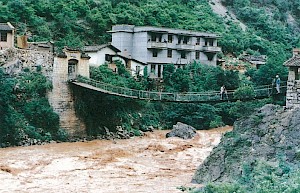 Pŭdù Suspension Bridge, LùquànPŭdù Suspension Bridge 普渡河铁索桥 in Lùquàn county of Yúnnán province.The Australian missionary Gladstone Porteous 张尔昌 (1874–1944) of the China Inland Mission (CIM) experienced a successful ministry among the Nasupu 黑彝 people in Lùquàn 禄劝 and Wǔdìng 武定 Counties in Chuxiong, Yúnnán.
Pŭdù Suspension Bridge, LùquànPŭdù Suspension Bridge 普渡河铁索桥 in Lùquàn county of Yúnnán province.The Australian missionary Gladstone Porteous 张尔昌 (1874–1944) of the China Inland Mission (CIM) experienced a successful ministry among the Nasupu 黑彝 people in Lùquàn 禄劝 and Wǔdìng 武定 Counties in Chuxiong, Yúnnán.
He arrived in Yúnnán in 1907, established a theological training center in Sāyíngpán 撒营盘 township of Lùquàn by 1912, and reached out to the Nasupu (Yí) and Hmong (Miáo). He translated the Gospel of Luke into Nasu in 1923. Before completing the New Testament, Gladstone Porteous died from typhoid in 1944 in Sāyíngpán, where he was buried.
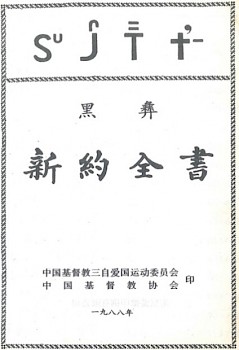 Nasu New Testament of 1948Nasu New Testament of 1948 reprinted in 1988 by the Chinese Christian Council.His collaborators finished the translation of the New Testament in 1948 using the Pollard Script. The manuscript was published by China Bible House in Shànghăi in the same year. At Porteous’ death, there were 20,000 Nasupu and Hmong believers in Lùquàn and Wǔdìng; by 2011, this number reportedly doubled. Lùquàn and Wǔdìng counties are still Christian strongholds today, partly because of the testimony of Wáng Zhìmíng, a native Hmong pastor of Wǔdìng, who refused to participate in the denunciation of other Christians during the Cultural Revolution (1966-1976). When he was arrested in 1969 and executed four years later in a stadium in front of 10,000 people, many villagers in Lùquàn and Wǔdìng converted to Christianity.
Nasu New Testament of 1948Nasu New Testament of 1948 reprinted in 1988 by the Chinese Christian Council.His collaborators finished the translation of the New Testament in 1948 using the Pollard Script. The manuscript was published by China Bible House in Shànghăi in the same year. At Porteous’ death, there were 20,000 Nasupu and Hmong believers in Lùquàn and Wǔdìng; by 2011, this number reportedly doubled. Lùquàn and Wǔdìng counties are still Christian strongholds today, partly because of the testimony of Wáng Zhìmíng, a native Hmong pastor of Wǔdìng, who refused to participate in the denunciation of other Christians during the Cultural Revolution (1966-1976). When he was arrested in 1969 and executed four years later in a stadium in front of 10,000 people, many villagers in Lùquàn and Wǔdìng converted to Christianity.
In the 1990s, the Yúnnán Chinese Christian Council (CCC) instituted a translation committee for the Nasupu Old Testament, including native pastor Wen Fu. The committee completed the Old Testament before 2010 and then revised the New Testament of 1948. After a lengthy approval process, the entire Bible was published by the CCC in 2016 and printed at Amity Press in Nánjīng.
Two teams of Sìchuān Yí and Guìzhōu Yí Christians translated the first New Testaments into Nuosu (2005) and Neasu (2018). Information on these translations is provided on the Nuosu 凉山彝 and Neasu 黔西彝 pages of this website. Other Tibeto-Burman languages with translated Bible portions include Kaduo (Luke 1939), Zaiwa 景颇 (NT 2009), Alupu 干彝 (Mark 1912, OT 2016), Lahu Shi 黄拉祜 (NT 2015), Nusu 怒 (Mark 2010), and Kopo 白彝 (NT 2015). Some of these translations have been completed recently.
Austro-Asiatic Minorities (2)
The Austro-Asiatic family has approximately 168 languages spoken in Southeast Asia. Prominent languages are Vietnamese (Vietnam) and Khmer (Cambodia). There are two Austro-Asiatic peoples in China forming two official nationalities, the Blang 布朗 and the Wa 佤. They are located in the southernmost part of the Yúnnán Province at the border to Myanmar and Thailand.
|
ISO639-3 |
Language |
Classification |
Population |
Book |
NT |
Bible |
|---|---|---|---|---|---|---|
|
blr |
Blang 布朗Blang or Bulang 布朗 is an Austro-Asiatic language related to the Wa language spoken by 55,000 people. Most of them live in Měnghǎi 勐海 County of Xīshuāngbǎnnà 西双版纳 Prefecture, China. |
Austro-Asiatic, Palaungic |
55,000 |
2015Ethnologue-19 reported the translation of a book of the Bible in Blang in 2015. No independent information on the translation project could be found. |
|
|
|
wbm |
Wa 佤 (Vo)The Wa language distinguishes between the Parauk (750,000), Vo (40,000), and Awa (100,000) varieties. The Parauk variety is the one in which the New Testament was translated in 1938. The Vo variety in China is the one in which the whole Bible was completed in 2016. |
Austro-Asiatic, Palaungic |
40,000 |
|
|
2016A team of Wa pastors including Bao Guangqiang and the United Bible Societies’ consultant Simon Wong completed the translation of the Old Testament and the revision of the New Testament in 2016, when the Chinese Christian Council published the whole Wa Bible in Nánjīng. The Bible was printed by Amity Press in Nánjīng and dedicated on October 22, 2016. |
Table 10: Bible Translation in Austro-Asiatic Languages of China
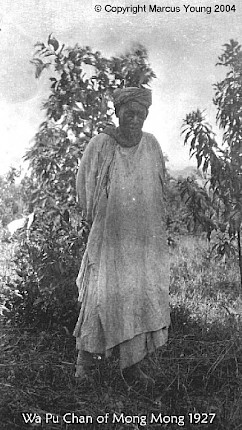 The Wa Bible translation is viewed by the Wa people as fulfillment of an ancient saga. According to an old Wa myth, one day a “white brother” would bring them a book about the lost God. In the 1880s, Pu Chan, a Wa leader summoned his tribesmen that the “white brother” might be near and that they should stop killing each other and doing evil things. William Marcus Young 永伟里 of the Boston Missionary Society settled in the town of Kengtung, Burma in 1892 and set up a mission station. One day in the 1890s, Pu Chan prepared a white Wa pony that, according to a vision, would bring them to the “white brother.” The tribesmen arrived exactly at the mission station that Young had established. They asked William Young to bring them “the” book, and the Wa people converted in large numbersSee Richardson, Don, 1981, Eternity in their Hearts. Ventura, California: Regal Books. in the following years. In 1912, William’s son, Marcus Vincent Young永文生, moved to the district of Nuòfú 糯福 in Mènglián 孟连 County, China. He devised Romanized scripts for the Wa (Parauk dialect) language and built churches and a school there. Assisted by native Wa speakers Yaw Su, Sai Pluik, and Sara Ngao Meung, who were from Myanmar, Marcus Young translated the Gospel of John into Wa by 1934 and the entire New Testament by 1938. Both manuscripts were published by the American Baptist Mission Press in Rangoon, Burma, in 1934 and 1938, respectively.
The Wa Bible translation is viewed by the Wa people as fulfillment of an ancient saga. According to an old Wa myth, one day a “white brother” would bring them a book about the lost God. In the 1880s, Pu Chan, a Wa leader summoned his tribesmen that the “white brother” might be near and that they should stop killing each other and doing evil things. William Marcus Young 永伟里 of the Boston Missionary Society settled in the town of Kengtung, Burma in 1892 and set up a mission station. One day in the 1890s, Pu Chan prepared a white Wa pony that, according to a vision, would bring them to the “white brother.” The tribesmen arrived exactly at the mission station that Young had established. They asked William Young to bring them “the” book, and the Wa people converted in large numbersSee Richardson, Don, 1981, Eternity in their Hearts. Ventura, California: Regal Books. in the following years. In 1912, William’s son, Marcus Vincent Young永文生, moved to the district of Nuòfú 糯福 in Mènglián 孟连 County, China. He devised Romanized scripts for the Wa (Parauk dialect) language and built churches and a school there. Assisted by native Wa speakers Yaw Su, Sai Pluik, and Sara Ngao Meung, who were from Myanmar, Marcus Young translated the Gospel of John into Wa by 1934 and the entire New Testament by 1938. Both manuscripts were published by the American Baptist Mission Press in Rangoon, Burma, in 1934 and 1938, respectively.
After the mid-1980s, the Wa in China and outside of China produced independent translations of the Old Testament. The Yúnnán CCC and the Three-Self-Patriotic-Movement appointed a team of Wa pastors, including Bao Guangqiang, in 2002. The team was forced to stop its work by 2005 due to a lack of technical equipment. The United Bible Societies, which was called for assistance, sponsored computers and software, and assigned Simon Wong as a consultant. The reorganized team completed the translation of the Old Testament and the revision of the New Testament in 2016, when the CCC published the entire Wa Bible. The Bible was printed by Amity Press in Nánjīng and dedicated on October 22, 2016.
Formosan Minorities (10)
The FormosanBefore 1958, Taiwan was called Formosa, a name derived from the Portuguese expression Ilha Formosa to mean “Beautiful Island.” languages are Austronesian languagesThe Austronesian languages are distributed over a triangle covering Madagascar, Southeast Asia, and islands in the Pacific Ocean. They number more than 1,200 languages. Linguists have shown that the Austronesian languages originate from languages spoken in Taiwan. spoken by the indigenous people of TaiwanAccording to William Campbell (1903), the name Taiwan was given by the Dutch who adopted the term Taiyoan (“foreigner”) from the now-extinct Siraya 西拉雅语 language to name the coastal area where they had established a commercial post. This area corresponds to the modern-day county of Ānpíng 安平. The Siraya term was also adopted in Hokkien and other Chinese dialects, before being accepted as a generalized name for the island.. Linguists estimate about 26 Formosan languages: 10 of which are extinct, four are moribund, and three more are endangered. The indigenous speakers belong to 16 official tribesAccording to The China Post on June 27, 2014, there are 16 officially recognized tribes in Taiwan: Amis 阿美族, Atayal 泰雅族, Bunun 布农族, Saaroa 沙阿鲁阿族, Kanakanvu 卡那卡那富族, Kavalan 噶玛兰族, Paiwan 排湾族, Puyuma 卑南族, Rukai 鲁凯族, Saisiyat 赛夏族, Yami 雅美族, Thao 邵族, Tsou 邹族, Truku 太鲁阁族, Sakizaya 撒奇莱雅族, and Seediq 赛德克族., totaling 533,600 people; this comprises 2% of the island’s population.
|
Taiwan History |
Time |
|---|---|
|
Pre-Chinese |
BC 4500–AD 222 |
|
Chinese Expeditions |
222-1624 |
|
Dutch |
1624–1664 |
|
Chinese Qīng 清 |
1664–1895 |
|
Japanese |
1895–1945 |
|
Republic of China |
1949–today |
Table 11: Eras in Taiwan History
The discovery of pottery and weaponry of the Neolithic Age (BC 4500–AD 400) convinced scholars to connect Taiwan’s aborigines both to Mainland China and other Polynesian groups. Chinese rulers had sent expeditions to Taiwan throughout the Three Kingdom period 三国时期Sūn Quán 孙权 (229–-252), the King of Wú 吴 in Southeast China, sent the first recorded expedition to Taiwan. The name given to Taiwan at this time was I-chou. (AD 222-280) and the Sui dynasty 隋朝The emperor Yáng Guăng 楊廣皇帝 (reign 604–617), second emperor of the Sui dynasty 隋朝, sent a force of 10,000 soldiers to conquer the island. With the demise of the Sui dynasty, this enterprise failed. At that time, Taiwan was called Liúqiúqún Dăo 琉球群岛, which later became the Chinese name for the Ryukyu Islands. (AD 590-618). After the ninth century, small groups of immigrants from the Zhejiang 浙江 coastal area settled on the Pescadores Islands 澎湖岛, which lies midway between China and Taiwan.
At the onset of the Mongol reign in 1260, many Chinese from the Yellow River valley moved to Taiwan and settled there. Constant conflicts between Chinese and Japanese pirates during the Míng dynasty 明朝 (1368–1644) had caused thousands of Chinese to take refuge in the southern part of Taiwan. At the end of the Míng dynasty, Chinese immigrants arrived in greater numbers and settled in the plains of Central Taiwan. They gradually displaced the aboriginal people, who retreated to the mountains or were assimilated to Chinese culture.
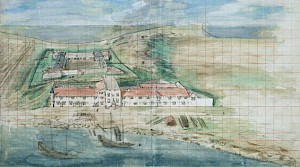 Fort Zeelandia in 1635When Spain annexed Portugal in 1580, Dutch ships were blocked from doing trade with Lisbon. The Dutch decided to turn toward Asia and founded the Dutch East India Company in the early 1600s. The goal of the company was to establish trade with China. The Dutch forced the Chinese into a deal over the Pescadores Islands and Taiwan. In 1624, the Dutch were accorded Taiwan, where they built Fort Zeelandia at Taiyoan, close to modern-day Táinán 台南. They extended their control over the whole island after they defeated Spanish invaders in 1642. By using or threatening force, the Dutch pacified the indigenous villages. In 1635, a rebellion broke out in the village of Mádòu 麻豆, killing 60 Dutch men. Troops, who were called in from abroad, quickly overcame the resistance.
Fort Zeelandia in 1635When Spain annexed Portugal in 1580, Dutch ships were blocked from doing trade with Lisbon. The Dutch decided to turn toward Asia and founded the Dutch East India Company in the early 1600s. The goal of the company was to establish trade with China. The Dutch forced the Chinese into a deal over the Pescadores Islands and Taiwan. In 1624, the Dutch were accorded Taiwan, where they built Fort Zeelandia at Taiyoan, close to modern-day Táinán 台南. They extended their control over the whole island after they defeated Spanish invaders in 1642. By using or threatening force, the Dutch pacified the indigenous villages. In 1635, a rebellion broke out in the village of Mádòu 麻豆, killing 60 Dutch men. Troops, who were called in from abroad, quickly overcame the resistance.
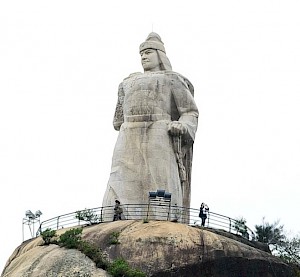 Zhèng Chénggōng 郑成功The statue of Zhèng Chénggōng 郑成功 is on Gŭlàngyŭ 鼓浪屿 Island. The Gŭlàngyŭ 鼓浪屿 Island is at short distance of the coastal city of Xiàmén in Fújiàn Province.The Dutch East India Company employed members of the Dutch reformed clergy (predikantenIn Dutch, a predikant is a preacher, pastor, or minister.) on short-term posts, generally less than 10 years. During the Dutch period, about 32 clergymen worked in Taiwan. When a village was pacified and the villagers forsook their idols, clergymen and catechists would baptize the aboriginal people, initiate worship services, and build churches and schools. By 1650, reports of baptized indigenous believers ranging from 1,000 to 5,000 reached Holland.
Zhèng Chénggōng 郑成功The statue of Zhèng Chénggōng 郑成功 is on Gŭlàngyŭ 鼓浪屿 Island. The Gŭlàngyŭ 鼓浪屿 Island is at short distance of the coastal city of Xiàmén in Fújiàn Province.The Dutch East India Company employed members of the Dutch reformed clergy (predikantenIn Dutch, a predikant is a preacher, pastor, or minister.) on short-term posts, generally less than 10 years. During the Dutch period, about 32 clergymen worked in Taiwan. When a village was pacified and the villagers forsook their idols, clergymen and catechists would baptize the aboriginal people, initiate worship services, and build churches and schools. By 1650, reports of baptized indigenous believers ranging from 1,000 to 5,000 reached Holland.
In 1661, Zhèng Chénggōng 郑成功, a Míng supporter whose honorary name was Koxinga 国姓爷, fled the Manchu control, went to Taiwan, and overthrew the Dutch empire in 1662. The indigenous people persevered with Christian faith for several decades, which was attested by a Jesuit traveler in 1715. It took until the mid-nineteenth century for Western missionaries to reach the island and begin their work with no spiritual foundations to build upon.
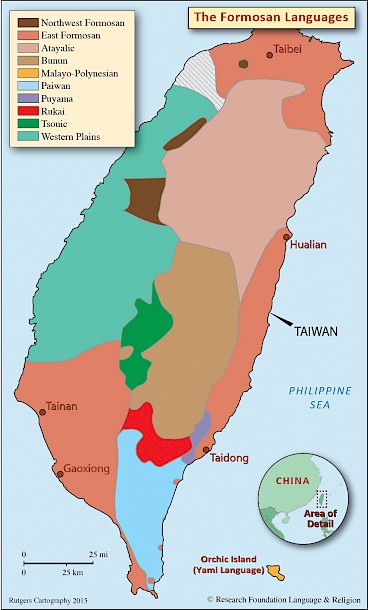 The Míng loyalists, who fled to Taiwan, were defeated by the Manchu rulers in 1683. Long-term instability with numerous rebellions by Míng supporters and by indigenous people caused the Manchu Government to station tens of thousands of troops in Taiwan. By the nineteenth century, Taiwan was divided into four counties. Each county had urban centers, Chinese villages, assimilated indigenous villages, and “savage” native villages.
The Míng loyalists, who fled to Taiwan, were defeated by the Manchu rulers in 1683. Long-term instability with numerous rebellions by Míng supporters and by indigenous people caused the Manchu Government to station tens of thousands of troops in Taiwan. By the nineteenth century, Taiwan was divided into four counties. Each county had urban centers, Chinese villages, assimilated indigenous villages, and “savage” native villages.
Spanish Dominican missionaries from Manila arrived in Taiwan in 1859, one of whom was Father Fernando Sainz. During the 15 years of their ministry, several hundred aborigines converted to the Christian faith. In the 1860s and 1870s, three English Presbyterian missionaries, James Maxwell 马雅各 (1836–1921), William Campbell 甘为霖 (1841–1921)See Campbell, William (1903). Formosa Under the Dutch: Described from Contemporary Records. London: Kegan Paul, Trench, Trüber & Co., and Thomas Barclay 巴克礼 (1849–1935), settled in Táinán and established Presbyterian churches. The Christian movement among the aborigines started in the 1870s. By 1877, the Presbyterian mission statistics numbered 1,031 baptized adults in 26 chapels with 24, mostly native, preachers. The converts were essentially Siraya people.
In the wake of the Treaty of Shimonoseki (《马关条约》)—an unequal treaty to end the First Sino-Japanese War between the Empire of Japan and the Manchu government—Taiwan was ceded to Japan in 1895. The Japanese abandoned the Manchu strategy of containing the aborigines and adopted a more repressive policy. At the same time, the Japanese investigated the Formosan languages and cultures, publishing their findings for the outside world. After the “savage” indigenous people in the mountains were pacified in the early twentieth century, Japanese officials learned their languages and interacted with them. For this reason, older aborigines still favorably recall the Japanese era today.
After the Japanese defeat in World War II and the retreat of the Bĕijīng Republican Government to Taiwan in 1949, a new era began. The missionary movement among the “savage” aborigines, which had started in 1929, gained momentum after 1949 when Bible portions were translated into a range of indigenous languages. This movement among all the Formosan groups would eventually bring about 50% of the aborigines to the Christian faith. By 1949, there were 120 Protestant churches with 20,000 believers; by 1959, the figures tripled with 360 churches and 60,000 members. Catholic churches grew strongly in numbers only after the mid-1950s. The particular experience of the Formosan people supports the conventional thinking that any movement to the Christian faith must be sustained by Scripture translation.
|
ISO639-3 |
Language |
Classification |
Population |
Book |
NT |
Bible |
|---|---|---|---|---|---|---|
|
ami |
Amis 阿美语The Amis language is spoken in Eastern Taiwan along the coast between Huālián and Táidōng. The language is mainly spoken by elderly people. Traditionally, the Amis have a matrilineal social organization, with women having most of the authority in the clan. To balance this out, men have superior positions within the local government. The Amis have a legend about a brother and sister who drifted on a tub-raft from the Caroline Islands to Taiwan. (The Caroline Islands, whose Chinese name is Jiāluólín Dǎo 加罗林岛, are part of the Republic of Kiribati in the central Pacific Ocean.) Fey and Apack (1993) who recorded this legend, suggested a non-Asutronesian origin of the Amis and possibly of other people groups in Taiwan as well. Fey, Virginia and Afo Apack. (1993). Amis Culture. Taipei: Bible Society of Taiwan. |
East Formosan, Central |
138,000 |
1957U.S. missionary Edward Torjesen of the Evangelical Alliance Mission settled in Chénggōng 成功, Táidōng 台东 County in 1955 to work with the Amis people. He learned the language and developed a Bopomofo-based alphabet and translated the Epistle of James into Amis by 1957, which was published by the Bible Society of Taiwan as a trial version in 1957. Because the Bopomofo-based script did not render well certain Amis sounds, the church leaders were not very receptive of the publication. | 1972Edward Torjesen was joined by Arthur Stejskals (USA) and Virginia Fey (USA) of the Evangelical Alliance Mission in 1960. Virginia Fey learned the language so well that she became the translation expert on the team. The team developed a Romanized script that solved the problems of the Bopomofo script and completed the first Amis New Testament in 1972, which was published by the Bible Society of Taiwan in 1972. | 1997The Bible Society of Taiwan gradually took over responsibility for the Old Testament translation project. United Bible Societies’ consultant Graham Ogden directed a team of Amis translators, who completed the entire Bible in 1997, which was published by the Bible Society of Taiwan in the same year. |
|
bnn |
Bunun 布农语The Bunun people are spread across Taiwan, and they are known for their multivocal singing. Because of their geographical dispersion, they developed the custom of communicating with one another through musical cries. A large portion of the population converted to Christianity after 1946. |
Bunun |
38,000 |
1951Hú Wénchí 胡文池 of the Presbyterian Church of Taiwan worked with the Bunun people during 1947–1971, with financial support from Presbyterian churches in England, Canada, and the United States. With his colleague Zhāng Yùfā 张玉发, Hú Wénchí developed a Romanized script for Bunun and translated the Gospel of Matthew by 1951, which was published by the Bible House in Hong Kong. | 1973After publication of the Gospel, further progression was stalled by the Taiwan authorities, which in the 1950s, pursued an assimilatory policy of the aboriginal people and viewed any Romanized, non-Bopomofo-based, script as a threat to the national identity of Taiwan. A team of Hàn and Bunun pastors, including Hú Wénchí and Manias Is-tasipal, completed the translation of the Bunun New Testament in 1973 using the Bopomofo-based script. The manuscript was published as a Bunun-Chinese diglot by the Bible Society of Taiwan in Táiběi in 1973. | 2000In 1987, at the request of the Bunun Presbyterian Church, the Bible Society of Taiwan formed a translation committee for the Old Testament, including three Bunun pastors (Lǐ Míngrén 李明仁, Wǔ Zhuī 伍锥, and Shěn Délái 沈德来) as translators and seven Bunun pastors (Zhāng Yùfā 张玉发, Huáng Shùn 黄顺, Zhōu Tiānhuà 周天化, Yán Yǒulì 颜有利, Tián Róngguì 田荣贵, Yú Zàiwàng 余再旺, and Sī Míngshān 司明山) as reviewers. This team of 10 pastors, which was advised by United Bible Societies’ consultant Graham Ogden, completed an abridged version of the Old Testament by 2000 as well as a revision to the New Testament. The first Bunun Bible was published in a Romanized script by the Bible Society of Taiwan in 2000. |
|
dru |
Rukai 鲁凯语Rukai is believed to be the oldest Formosan language having split from Proto-Austronesian in 2,500 B.C. The Rukai were evangelized in the 1950s and 1960s, and about 80% of Rukai people are affiliated with a Christian church. |
Rukai |
10,500 |
|
2001Rukai churches requested a Bible translation project from the Bible Society of Taiwan in 1987. A translation committee, including Rukai pastors Adriu and Tanubake, was formed in 1988. Pastor Han Der-seng of the Young Nak Presbyterian Church in Korea became a crucial supporter of the translation project as a result of getting to know some Rukai people in Taiwan. The committee took 13 years to complete the New Testament, which was published by the Bible Society of Taiwan in 2001. The New Testament has been used in three of six dialect areas. | 2017The Bible Society of Taiwan and the Presbyterian Church of Taiwan formed an Old Testament translation committee of Rukai pastors in 2002. After the committee finished most of the Old Testament books, they appointed Paul McLean of the United Bible Societies as a consultant to the project in 2012. The review of the manuscript took another five years before the Bible Society of Taiwan published the entire Bible in the Drekay dialect of Rukai and printed 3,000 copies. The Bible was dedicated on July 11, 2017. |
|
fos |
Siraya 西拉雅语The Siraya language is an East Formosan language that had become extinct in the late nineteenth century. The language is currently revitalized by the modern Siraya people. |
East Formosan, Southwest |
Extinct |
1661In 1661, the Dutch missionary and linguist Daniel Gravius (Dutch Reformed Church) translated the Gospel of Matthew into Siraya and published it by juxtaposing Dutch text with it. |
|
|
|
pwn |
Paiwan 排湾语In the past, the Paiwan people gained a reputation as headhunters. When the Dutch occupied Taiwan, more than 5,000 became Christians. They were all killed by the Chinese military leader Zhèng Chénggōng in 1661 when he defeated the Dutch forces. Today, there is a large number of Paiwan Christians, with more than 14,000 belonging to the Presbyterian Church alone. |
Paiwan |
66,100 |
1959John Whitehorn 怀约翰 of the English Presbyterian Mission arrived in Taiwan in 1951 to work with the Paiwan people. He created a Bopomofo-based script for Paiwan (Bopomofo was created by the Republican Government in 1911), and, aided by Pari (or Yè Chéngbiān 叶盛编) and other native translators, he completed the Gospel of Mark in 1959. The manuscript was published by the Hong Kong Bible House using the Bopomofo script. | 1973Whitehorn and his team also completed the first New Testament in 1973, which was published by the Bible Society of Taiwan in 1973 using the Bopomofo-based script and a diglot with Mandarin Chinese. | 1993In 1984, the Bible Society of Taiwan formed a translation committee, including Cukar (Xǔ Sōng 许松) as the main translator and Lín Quánmào 林泉茂, Lín Jiànèr 林建二, Kǒng Shùnxìng 孔顺兴, Máo Dōngnán 毛东南, Xiè Qīnyù 谢钦玉, Lài Guāngxióng 赖光雄, Hé Míngdào 何明道, and Lǐ Dìngxióng 李定雄 as the reviewers. Together with United Bible Societies’ consultants I-Jin Loh and Graham Ogden, they completed an abridged version of the Old Testament and a revision of the New Testament in 1993, transcribing the work into a Romanized script. This work was published by the Bible Society of Taiwan in 1993. |
|
tao |
Yami 雅美语Yami is a Malayo-Polynesian language and not a Formosan language. It is a language spoken on Orchid Island, 46 kilometers southeast of Taiwan, and is similar to languages found in the Northern Philippines. |
Malayo-Polynesian, Philippine, Bashiic |
3,380 |
1970Grace Wakelin 卫克琳 of the Canadian Presbyterian Church arrived in Taiwan and settled on Orchid Island 兰屿岛 in 1956. She began translating the Gospel of Mark in 1965 and completed it five years later in 1970 using a Bopomofo-based script. In the same year, she retired and returned to Canada. | 1994In 1985, the Bible Society of Taiwan arranged a special cooperation between Wycliffe Bible Translators and United Bible Societies and formed a translation committee, including Rosemary Thompson 汤思玫 of Wycliffe Canada, Virginia Larson 罗雅菁 of Wycliffe USA, Yami pastors Wáng Róngjī 王荣基 and Zhāng Hǎiyǔ 张海屿, and the United Bible Societies’ consultant Graham Ogden. The Wycliffe translators checked the appropriateness of the vocabulary and the faithfulness to the original text, while Graham Ogden supervised compliance with translation principles. The committee completed the New Testament in 1994, which was published by the Bible Society of Taiwan. |
|
|
tay |
Atayal 泰雅语The Atayal language 泰雅语, with its two dialects of Squliq and C’uli’, is spoken by more than 84,000 people in central and northern Taiwan, along the Xuěshān 雪山 mountains. |
Atayalic |
84,300 |
1964Clare McGill 穆克理 of the Canadian Presbyterian Church arrived in Taiwan in 1953 and after learning Mandarin Chinese, he settled in Dàtóng, a township 大同 in Yílán 宜蘭 County, to work with the Atayal people. He first toured the area as an itinerant preacher to learn about the different Atayal dialects. In 1956, McGill formed a Bible translation group, including Atayal pastors Chén Zhōnghuī 陈忠辉, Lín Míngfú 林明福, Gāo Jīnróng 高金荣, and Chén Guāngsōng 陈光松. At the insistence of the government and despite the absence of symbols for certain sounds, they created a Bopomofo-based script for use in Atayal and translated the Gospel of Mark in 1964. | 1974A team coordinated by Clare McGill and again including the Atayal pastors Chén Zhōnghuī 陈忠辉, Lín Míngfú 林明福, Gāo Jīnróng 高金荣 and Chén Guāngsōng 陈光松 completed the New Testament in 1974 using the Bopomofo-based script. The manuscript was published by the Bible Society of Taiwan in the same year. | 2003In 1989, after Clare McGill had returned to Canada, the Presbyterian Atayal Church requested the translation of the Old Testament, after which the Bible Society of Taiwan formed a committee with Atayal pastor Lín Chūnhuī 林春輝 as chief translator and pastors Lín Míngfú 林明福, Gāo Jīnróng 高金荣, Lǐ Fúquán 李福全, Chén Guāngsōng 陈光松, and Lín Chéng 林诚 as reviewers. Graham Ogden of the United Bible Societies served as a consultant to the committee. They completed an abridged version of the Old Testament as well as a revision of the New Testament in 2003. The text was recompiled in a Romanized script and published by the Bible Society of Taiwan in 2003. |
|
trv |
Seediq 赛德克语The Seediq language is spoken by 20,000 Seediq 赛德克族 and Truku 太鲁阁族 people in Huālián 花莲县 and Nántóu 南投县 counties. |
Atayalic |
20,000 |
1956Ruth Covell 柯饶富of the Conservative Baptist Foreign Mission Society settled in Taiwan in 1951 and started a Bible translation project in the Seediq (Truku) language in 1953. They engaged two native translators, Tailong Litok and Howat Pisao. The policy of the Taiwan government in the 1950s was to transcribe aboriginal languages using the Bopomofo script (注音符号) to differentiate itself from the Communist government, which employed the Romanized script for the minorities on the continent. Covell and his team completed the Gospel of Mark in 1956, which was published as a monoglot by Bible House in Hong Kong and printed in Taiwan. | 1963Ralph and Ruth Covell, together with Lǐ Shǒuxìn 李守信 and Seediq translators Tailong Litok and Howat Pisao, completed the Seediq New Testament in 1963. The manuscript was jointly published by the Bible Societies of Hong Kong and of Taiwan in 1963. | 2005The Seediq (Taroko) Old Testament was gradually translated over a period of 40 years by a committee, which included pastors Tián Xìndé 田信德, Wú Wénhuá 吴文华, Yè Bǎojìn 叶保进, and Jīn Qīngshān 金清山. Ralph Covell, who had returned to the United States, advised the team as a consultant. The final manuscript was published by the Bible Society of Taiwan in 2005 and dedicated on October 1, 2005. |
|
pyu |
Puyuma 卑南语The Puyuma language 卑南语 is spoken by about 8,500 people in Táidōng 台东 County on the east coast. The Puyuma people are divided into the Zhīběn 知本 and Nánwáng 南王 groups. The Puyuma people were evangelized by the Catholic Church and the Presbyterian Church of Taiwan. |
Puyuma |
8,490 |
1990The Catholic priest John Zēng 曾建次, who was located near the city of Táidōng 台东, translated the Gospel of Mark into the Kapitol (知本) dialect of Puyuma, his native dialect. The Gospel was published in the Kanji script in 1990. Although Zēng taught literacy and Gospel classes, the general interest of the Puyuma people in their written language was limited. In the 2000s, a new edition of the Gospel of Mark transcribed in a Romanized script was circulated. |
|
|
|
tsu |
Tsou 邹语The Tsou language is spoken by 2,100 people in Nántóu 南投 and Jiāyì 嘉义 counties. |
Tsouic |
2,130 |
|
2012A team of Catholic priests from the Jiāyì diocese (天主教嘉义教区) in Western Taiwan translated and revised the New Testament over a period of 30 years and finally published it in 2012. Members of the team were German priest Anton Weber, Hungarian priest Dr. Jozsef Szakos, native Tsou priest Norbert Pu, Lisa Wang, and others. The linguist priest on the team was Jozsef Szakos, who had written a Tsou grammar book and co-compiled a Tsou-English dictionary. |
|
Table 12: Bible Translation in Languages of Taiwan
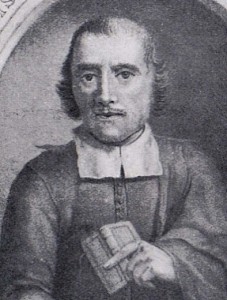 Daniel GraviusDaniel Gravius, 1616-1681.The first Bible portion translated in an aboriginal language of Taiwan was completed in 1661. Daniel Gravius, who was a Dutch clergyman (predikant), worked in Taiwan during 1647–1651. He settled in an indigenous village of the Siraya people close to Fort Zeelandia. Otness (1999) credited Gravius with introducing livestock raising among the aborigines. Gravius learned and transcribed Siraya using a Romanized script. He translated the Gospel of Matthew and a catechism into Siraya. Parallel Siraya and Dutch texts were published in Amsterdam in 1662. Gravius was accused of slander and fined, but he was later completely exonerated by a Dutch court in what is now Jakarta, Indonesia. He returned to the Netherlands in 1661 with his reputation restored.
Daniel GraviusDaniel Gravius, 1616-1681.The first Bible portion translated in an aboriginal language of Taiwan was completed in 1661. Daniel Gravius, who was a Dutch clergyman (predikant), worked in Taiwan during 1647–1651. He settled in an indigenous village of the Siraya people close to Fort Zeelandia. Otness (1999) credited Gravius with introducing livestock raising among the aborigines. Gravius learned and transcribed Siraya using a Romanized script. He translated the Gospel of Matthew and a catechism into Siraya. Parallel Siraya and Dutch texts were published in Amsterdam in 1662. Gravius was accused of slander and fined, but he was later completely exonerated by a Dutch court in what is now Jakarta, Indonesia. He returned to the Netherlands in 1661 with his reputation restored.
During the Qīng dynasty 清朝 (1644–1911), the number of Siraya speakers declined, and in the late nineteenth century, the language became extinct.
It took 289 years before missionaries were able to translate Bible portions in another aboriginal language. Pastor Hú Wénchí 胡文池 of the Presbyterian Church and his team translated the Gospel of Matthew in the Bunun language in 1951.
Several missionaries settled in Taiwan in the early 1950s. The Conservative Baptist Foreign Mission Society appointed Ralph Covell (1923–2013) and his wife, Ruth, as missionaries to the Nuosu people in Liángshān 凉山 in Sìchuān Province. They arrived in Liángshān in 1947/1948, but before accomplishing any work, they were forced to leave in 1951 and relocated to Taiwan. The Covells started a Bible translation project in the Seediq language in 1953See Covell, Ralph (1998). Pentecost of the Hills in Taiwan. Pasadena: Hope Publishing House. and engaged two native translators, Tailong Litok and Howat Pisao. The policy of the Taiwan government in the 1950s was to transcribe aboriginal languages using the Bopomofo script (注音符号) to differentiate itself from the Communist government, which employed the Romanized script for the minorities on the continent. Covell and his team completed the Gospel of Mark in 1956 and Acts and First Corinthians in 1957; they published the text as a monoglot. They translated the first New Testament in 1963 and subsequently the entire Bible in 2005.
Other major translations have been the Paiwan Bible in 1993, the Yami New Testament in 1994, the Amis Bible in 1997, the Bunun Bible in 2000, the Atayal Bible in 2003, the Tsou New Testament in 2012, and the Rukai Bible in 2017. For all aboriginal languages, the translation of key terms was a long and difficult process. The following table shows the titles of the Trinity in three aboriginal languages: Bunun, Seediq, and Paiwan. The name for God in the Bunun language was newly created because no suitable concept existed in the language previously.
|
Terms |
Bunun |
Seediq |
Paiwan |
|---|---|---|---|
|
God |
“Father of Heaven” |
“The Spirit Above” |
“The Spirit” (with impersonal article) |
|
Son of God |
“Child of God” |
“Child of God” |
“Child of God” |
|
Holy Spirit |
Sele (from Japanese 圣霊 “Seirei”) |
“Power of God” |
“Most Excellent Spirit” |
Table 13: Bible Terms in Three Formosan Languages
References
Ai, Juhong (2016). “The Politics of Identity: Identity Research on Dai Christians in Sipsongpanna.” In Yearbook of Chinese Theology, edited by Paulos Z. Huang, 48–64. Leiden: Brill.
Avetaranian, Johannes (1930). Geschichte eines Mohammedaners der Christ wurde. An autobiography completed after his death by R. Schäfer. Potsdam: Missionshandlung und Verlag. (Translated into English by J. Bechard in 2003 with the title A Muslim Who Became a Christian. Hertford, England: Authors OnLine Ltd.)
Backus, Charles (1982). The Nanchao Kingdom and T’ang China’s Southwestern Frontier. Cambridge: Cambridge University Press.
Baum, Wilhelm, and Dietmar W. Winkler (2003). The Church of the East: A Concise History. London: RoutledgeCurzon.
Blackmore, M. (1960). “The Rise of Nan-Chao in Yúnnán.” Journal of Southeast Asian History 1, no. 2: 47–61.
Bos, Kirsten I., Verena J. Schuenemann, Brian G. Golding, Hernan A. Burbano, Nicholas Waglechner, Brian K. Coombes, Joseph B. McPhee et al. (2011). “A Draft Genome of Yersinia Pestis from Victims of the Black Death.” Nature 478, no. 7370: 506–10.
Broomhall, Marshall (1934). The Bible in China. London: The China Inland Mission.
Campbell, William (1903). Formosa Under the Dutch: Described from Contemporary Records. London: Kegan Paul, Trench, Trüber & Co.
Chamberlain, James R. (1997). “Tai-Kadai Arthropods: A Preliminary Biolinguistic Investigation.” In Comparative Kadai: The Tai Branch, edited by Jerald A. Edmondson and David B. Solnit, 291–326. Dallas: SIL & The University of Texas at Arlington.
Chen Lüfan (1990). 泰族起源问题研究 Whence came the Thai race - an inquiry. 昆明:国际文化出版公司 Kunming: International Culture Publisher.
Chen, Lüfan and Du Yuting. (1989). “Did Kublai Khan’s Conquest of the Dali Kingdom Give Rise to the Mass Migration of the Thai People to the South?” Journal of the Siam Society 77, no. 1: 33–41.
Clarke, Samuel R. (1904). “The Miao and Chungchia Tribes of Kweichow Province.” East of Asia Magazine 3: 193–207.
Clarke, Samuel. R. (1907). “The Province of Kweichow.” In The Chinese Empire: A General and Missionary Survey, edited by Marshall Broomhall, 251–70. London: Morgan & Scott.
Cline, Eric H. (2002). The Battles of Armageddon. Ann Arbor: University of Michigan Press.
Covell, Ralph. (1998). Pentecost of the Hills in Taiwan. Pasadena: Hope Publishing House.
Crossley, Pamela K. (1997). The Manchus. New York: Wiley.
Davies, Henry R. (1909). Yúnnán, the Link between India and the Yangtze. Cambridge: Cambridge University Press.
Dodd, William C. (1923). The Tai Race: Elder Brother of the Chinese. Cedar Rapids, Iowa: Torch.
Eber, Irene, Sze-Kar Wan, and Knut Walf (1999). Bible in Modern China. Sankt Augustin: Institut Monumenta Serica.
Everson, Michael (2001). Revised proposal for encoding the Tai Le script in the Bitmap (BMP) of the Universal Coded Character Set (UCS). Published by the Unicode Consortium on its website on 06-Oct-2001. (Accessed on 13th of February, 2019.)
Fey, Virginia, and Afo Apack (1993). Amis Culture. Taipei: Bible Society of Taiwan.
Gorelova, Liliya M. (2002). Manchu Grammar. Leiden: Brill.
Grist, William A. (1920). Samuel Pollard: Pioneer Missionary in China. London: Cassell.
Hocken, Peter (1988). “Cecil H. Polhill - Pentecostal Layman.” Pneuma 10, no. 2: 116–140.
Hofrichter, Peter L. (2006). “Preface.” In Jingjiao: The Church of the East in China and Central Asia, edited by Roman Malek and Peter L. Hofrichter. Sankt Augustin, Germany: Institut Monumenta Serica.
Horne, Charles F. (1917). “The Sacred Books and Early Literature of the East,” Vol. XII, Medieval China, 381–392. New York: Parke, Austin & Lipscomb.
Hultvall, John (1981). Mission and Revolution in Central Asia: The MCCS Work in Eastern Turkestan 1892–1938 (Studia Missionalia Upsaliensa 35). Translated by Birgitta Åhman. Stockholm: Gummessons. (The original Swedish book title was Mission och revolution i Centralasien.)
Inglis, Douglas and Connie Inglis (2003). A preliminary phonology of Ngochang, presented at the 36th Annual Sino-Tibetan Conference on Languages and Linguistics. La Trobe University, Melbourne, Australia. (Accessed on 15th of February, 2019.)
Latourette, Kenneth S. (1929). A History of Christian Missions in China. London: Macmillan Publishers.
Leslie, Donald D. (1998). Jews and Judaism in Traditional China. Sankt Augustin: Institut Monumenta Serica.
Li, Dun Jen (1969). China in Transition: 1517-1911. Hoboken, New Jersey: Van Nostrand Reinhold.
Luo Wei, John Hartmann, Li Jinfang, and Vinya Sysamouth (2000). “GIS Mapping and Analysis of Tai Linguistic and Settlement Patterns in Southern China.” Geographic Information Sciences 6: 129–36.
Maberly, Allan (2001). God Spoke Tibetan. Rockwall: Evangelical Bible Translators.
McLaughin, C. E. (2013). A salience scheme for Hmong Soud: Types of Foreground and Background Information in Narrative Discourse. Dallas: Summer Institute of Linguistics.
McLaughin, C. E. (2018). The sentence in Flowery Hmong. Dallas: Summer Institute of Linguistics.
Meacham, William (1996). “Defining the Hundred Yue.” Bulletin of the Indo-Pacific Prehistory Association 15, no. 2: 93–100.
Mostaert, Antoine and Francis W. Cleaves (1952). “Trois Documents Mongols des Archives Secrètes Vaticanes.” Harvard Journal of Asiatic Studies 15, no. 3/4: 419–506.
Mote, Frederick W. (1964). “Problems of Thai Prehistory.” Social Science Review 2, no. 2: 100–09.
Mungello, David E. (2005). The Great Encounter of China and the West, 1500–1800. Lanham: Rowman & Littlefield.
Noss, Phil (2007). A History of the Bible Translation. Rome: Edizioni di Storia e Letteratura.
Otness, Harold (1999). One Thousand Westerners in Taiwan, to 1945: A Biographical and Bibliographical Dictionary. Taibei: Academica Sinica.
Pollard, Walter (1928). The Life of Sam Pollard of China. London: Seeley.
Pollard, Samuel (1954). Eyes of the Earth: The Diary of Samuel Pollard. London: Cargate Press.
Richardson, Don (1981). Eternity in Their Hearts. Ventura, CA: Regal Books.
Robeck, Cecil M. (2006). The Azusa Street Mission and Revival. Nashville: Thomas Nelson.
Rock, Joseph F. (1947). The Ancient Na-Khi Kingdom of Southwest China, 2 vols. Cambridge, MA: Harvard University Press.
Saeki, Yoshio (1937). The Nestorian Documents and Relics in China. Tokyo: Academy of Oriental Culture.
Sampu, Nasaw, Wilai Jaseng, Thocha Jana, and Douglas Inglis (2005). A preliminary Ngochang - Kachin- English Lexicon. Chiang Mai: Payap University, Linguistics Department.
Spence, Jonathan (1996). God’s Chinese Son: The Taiping Heavenly Kingdom of Hong Xiuquan. New York: W. W. Norton & Company.
Taylor, Howard (1944). Behind the Ranges: Fraser of Lisuland S.W. China. London: Lutterworth Press and The China Inland Mission.
Tiedemann, R. G. (2009). Reference Guide to Missionary Societies in China: From the 16th to the 20th Centuries. London: Routledge.
Terwiel, Barend Jan. (1978). “The Origins of the T’ai Peoples Reconsidered.” Oriens Extremus 25, no. 2: 239–58.
The China Post (2014). Government officially recognizes two more arboriginal tribes. Published in The China Post on 27th of June, 1994. (Accessed on 9th of May, 2019.)
Van der Laan, Cornelis (1997). “Beyond the clouds: Elize Scharten (1876–1965) Pentecostal Missionary to China.” In Pentecostalism in Context (Journal of Pentecostal Theology Supplement Series 11), edited by Wonsuk Ma and Robert P. Menzies, 337–60. Sheffield: Sheffield Academic Press.
Wáng Shuòfēng 王硕丰 (2013). 《古新圣经》考 (Louis de Poirot’s) Old and New Testament. 世界宗教研究,第2期:127-132页 Research on World Religions 2:127-132.
Winai, Pongsripian (1991). “Nan-chao and the Birth of Sukhothai: Problems of the Twentieth-Century Thai Perception of the Past.” Asian Review 5:1-19.
Wongthet, Suchit (1986). Khon thai yu thi ni [The Thai Were Here]. Muang Boran, special number.
Wongthet, Suchit (1994). Khon thai yu thi ni nai utsakhane [The Thai Were Here in Southeast Asia]. Bangkok: Silpakon University.
Willeke, Bernward (1945). “The Chinese Bible Manuscript in the British Museum.” The Catholic Biblical Quarterly 7, no. 4: 450–453.
Yu Suee Yan (2011). “The story of the Big Flowery Miao Bible”. Bible Translator 62(4), 207-215. United Bible Societies. (Accessed on 12-Feb-2019.)
Yule, Henry. (ed.) (1866). Cathay and the Way Thither: Being a Collection of Medieval Notices of China. Vol. 1. London: Hakluyt Society.
Zetzsche, Jost (1999). “The Work of Lifetimes: Why the Union Version Took Nearly Three Decades to Complete.” In Bible in Modern China: The Literary and Intellectual Impact, edited by Irener Eber, Sze-Kar Wan, and Knut Walf, 77–100. Sankt Augustin: Institut Monumenta Serica.
Zhào Jìngxiū 赵净修 (2001). 东巴象形文常用字词译注 Dōngbā Frequent Pictograms Translated into Chinese. 昆明:云南人民出版社 Kūnmíng: Yúnnán People’s Publisher House.
Zhèng Hǎijuān 郑海娟 (2012). 贺清泰《古新圣经》研究 Research on Louis de Poirot’s Old and New Testament. 北京:北京大学 Běijīng: Běijīng University.
Zhōu Mínglǎng (2003). Multilingualism in China: The Politics of Writing Reforms for Minority Languages 1949-2002. New York: Mouton de Gruyter.
Zhōu Mínglǎng (2013). “Historical Review of the PRC’s Minority/Indigenous Language Policy and Practice.” In China’s Assimilationist Language Policy, edited by Gulbahar H. Beckett and Gerard A. Postiglione, 18–30. London: Routledge.


